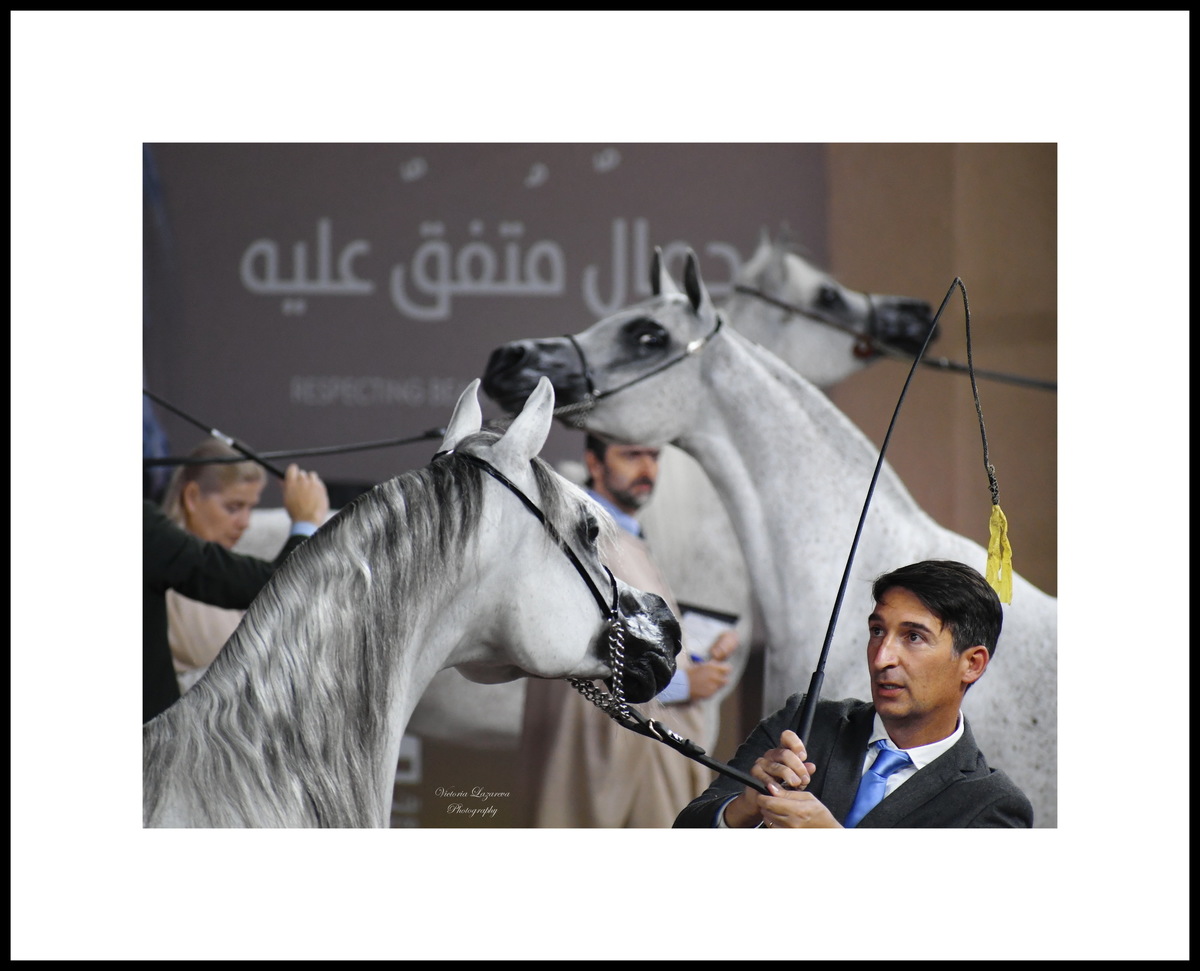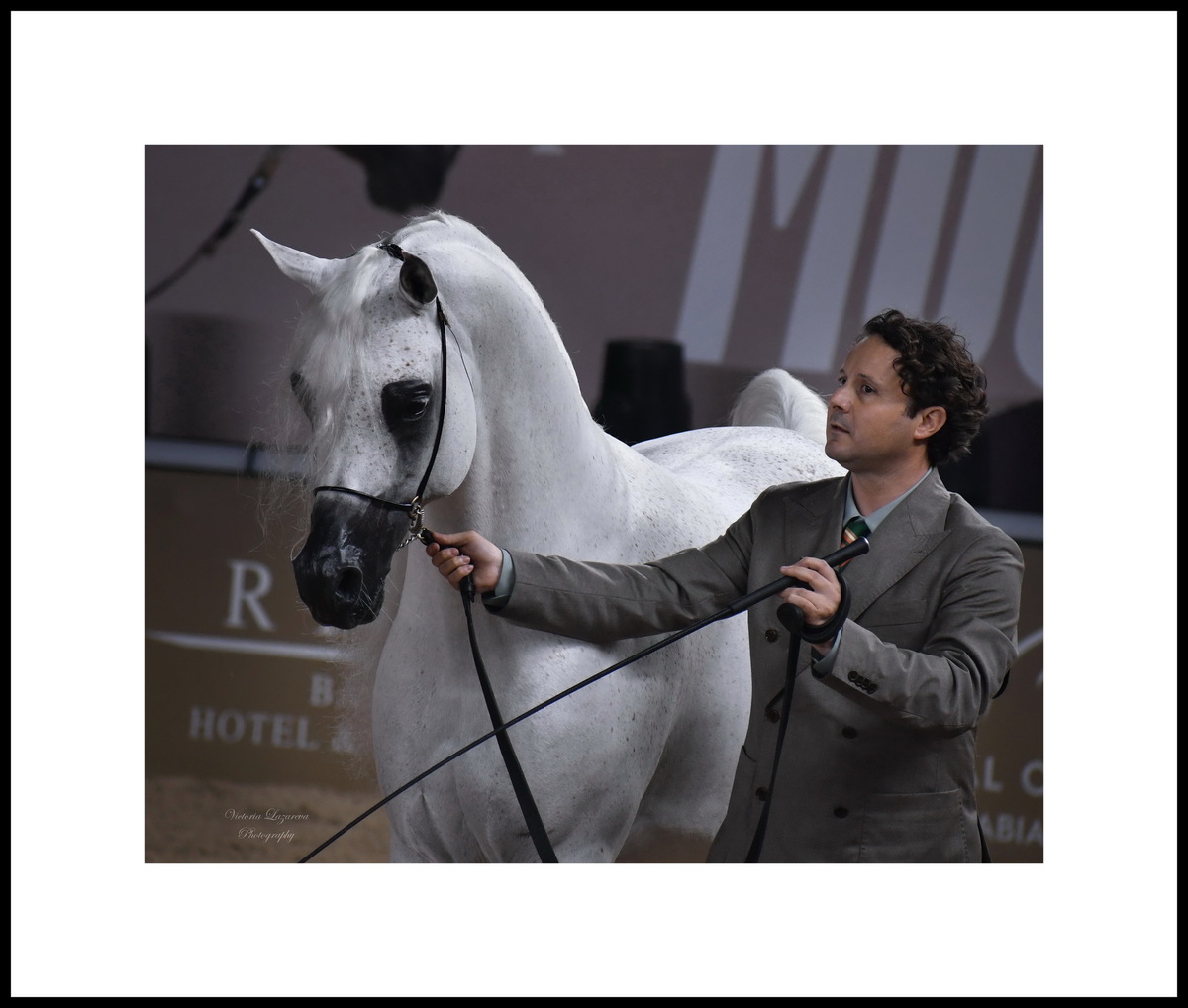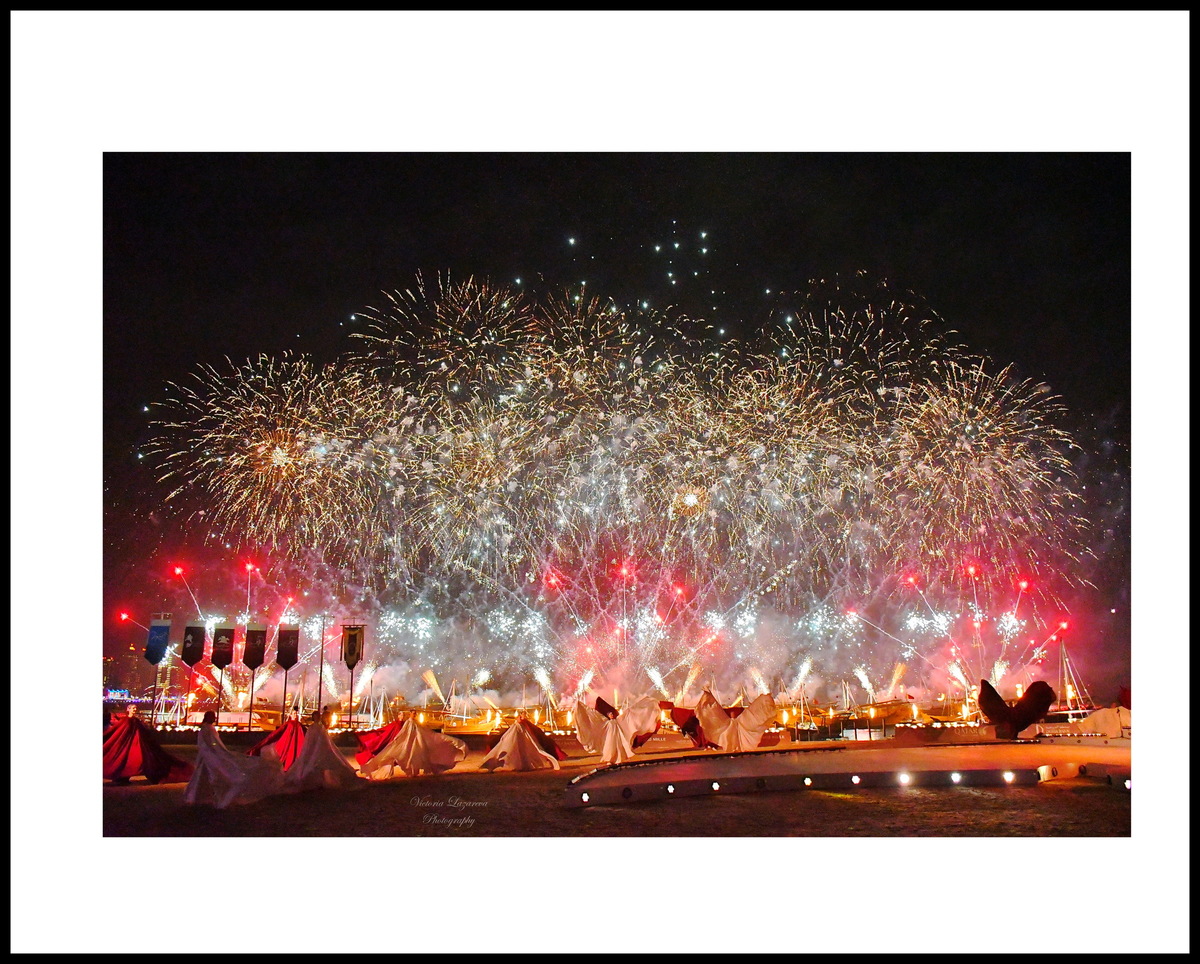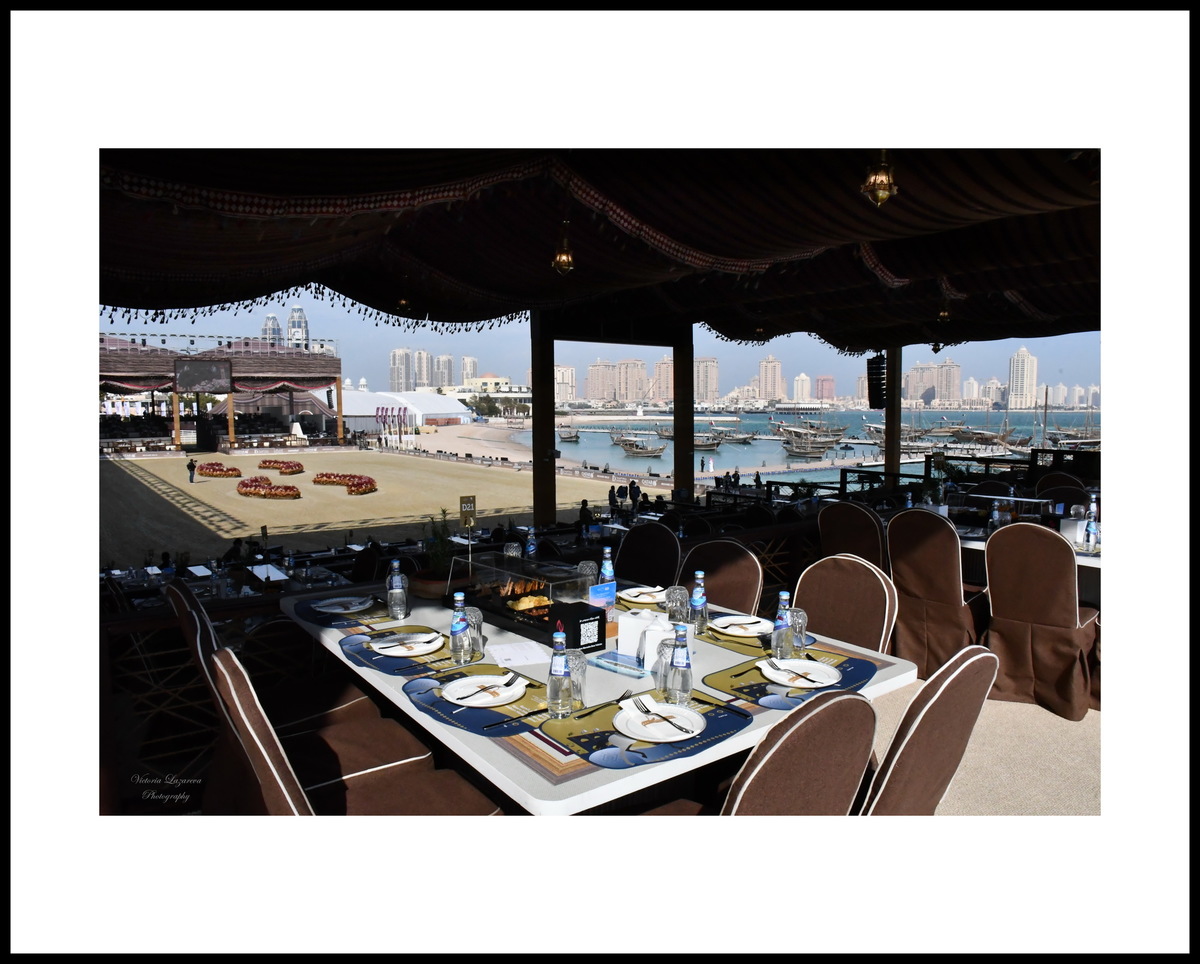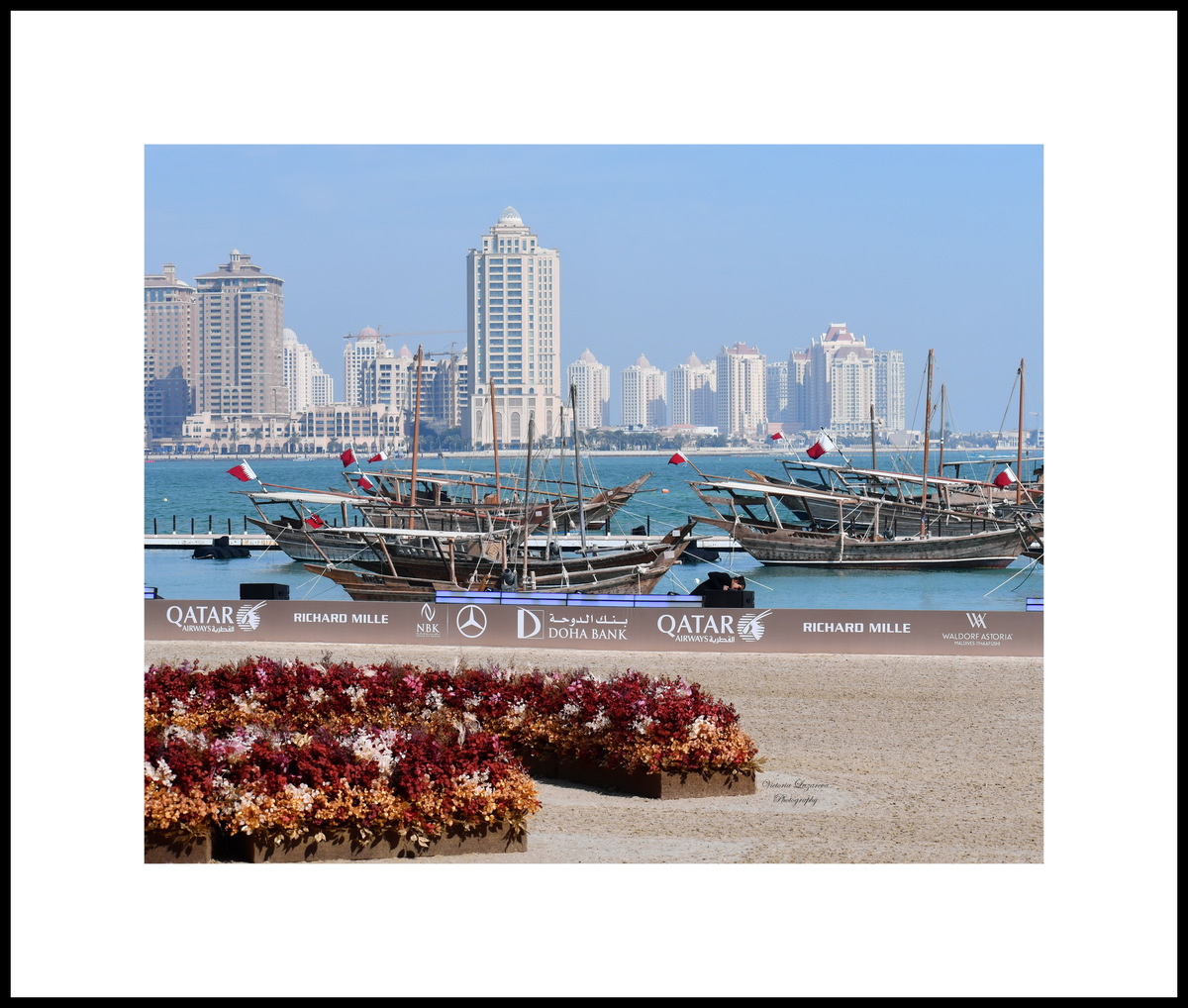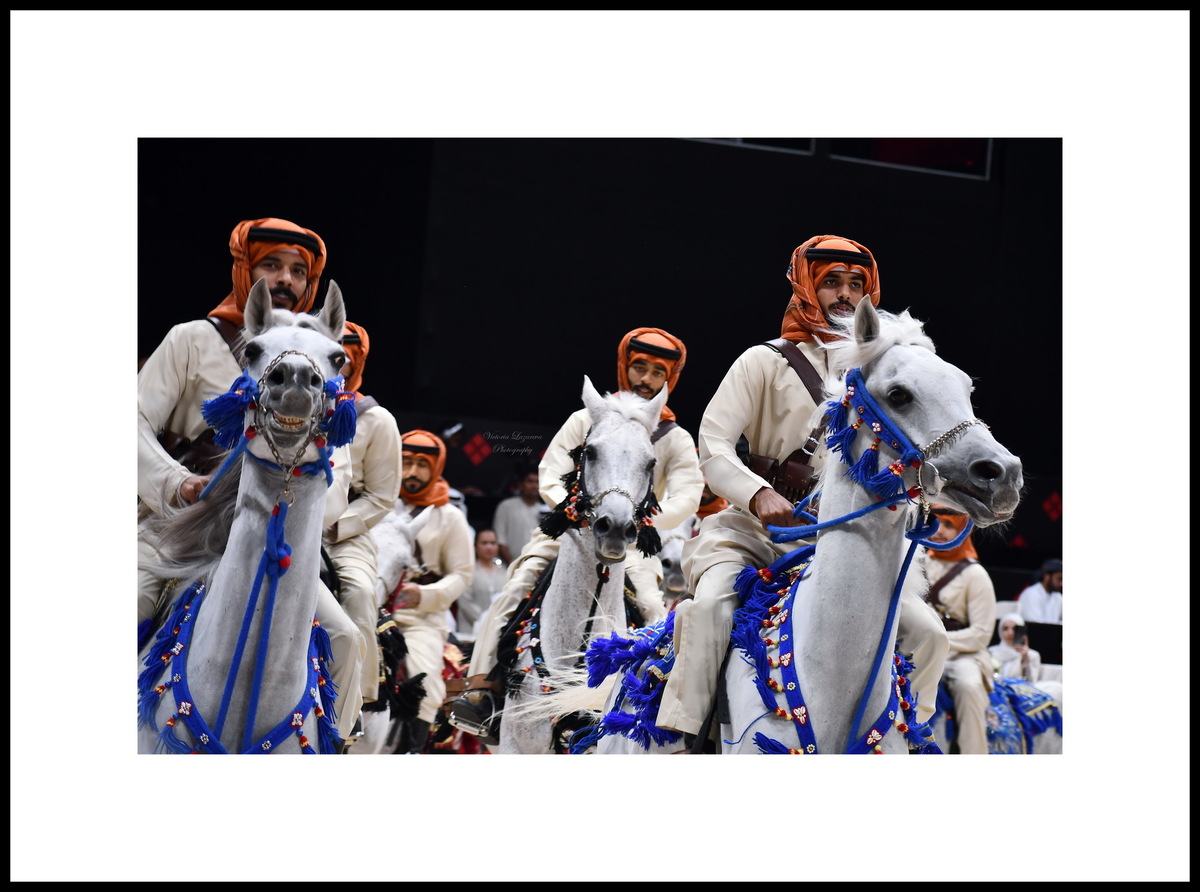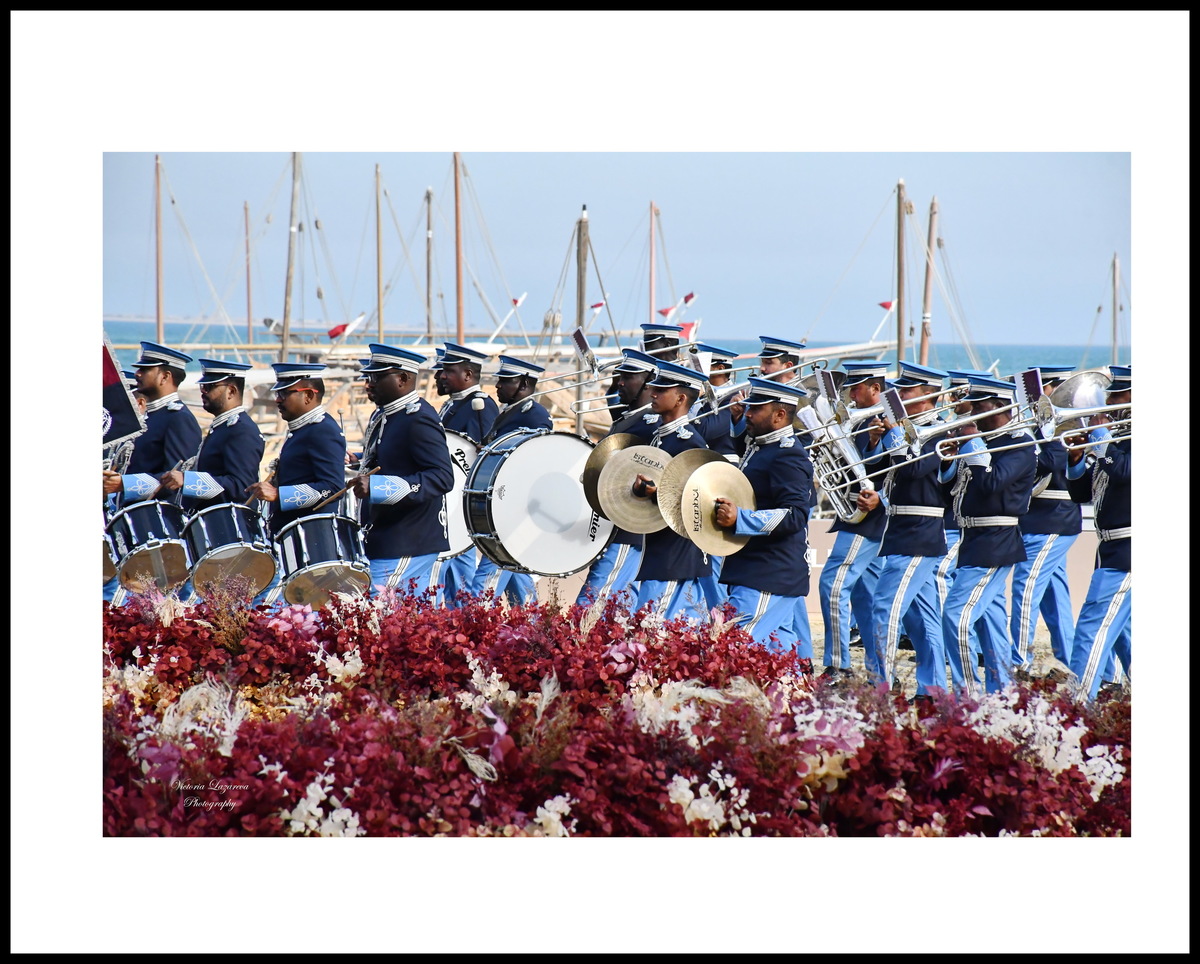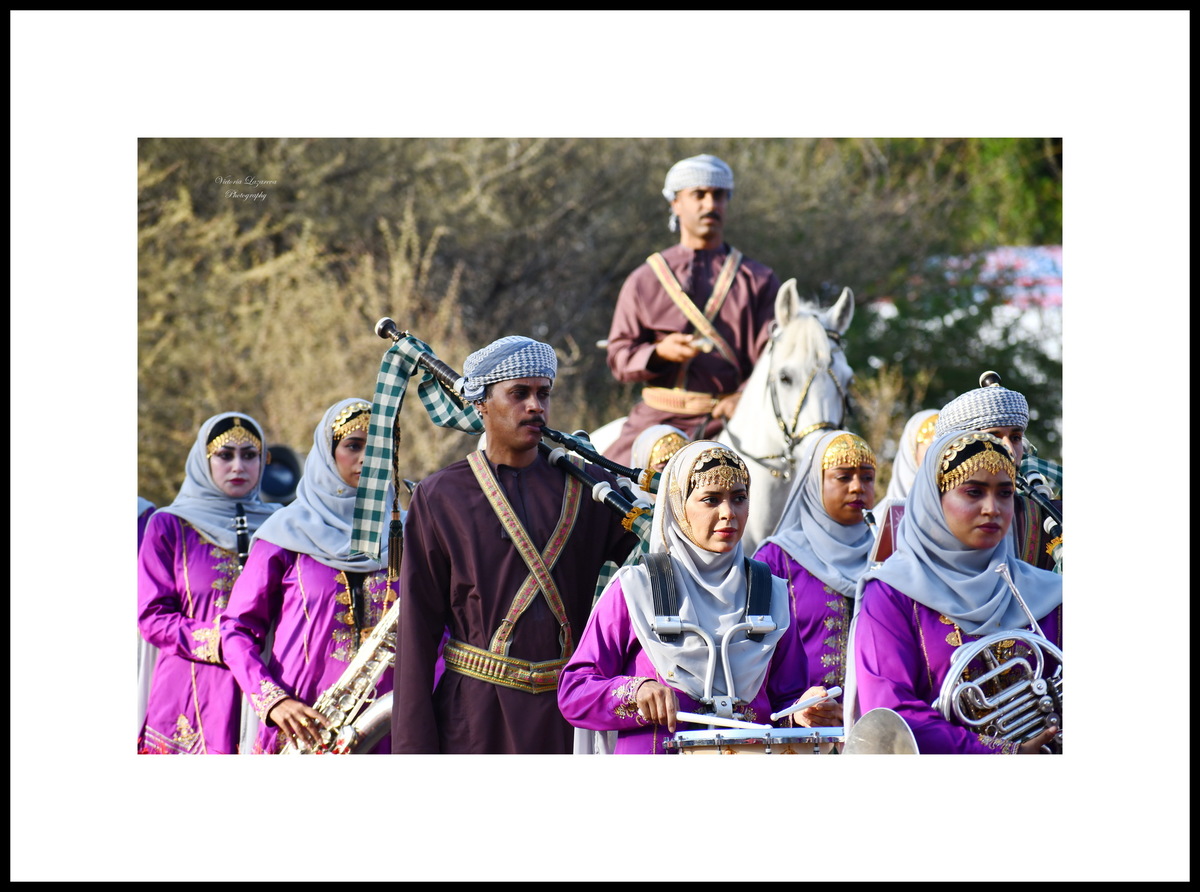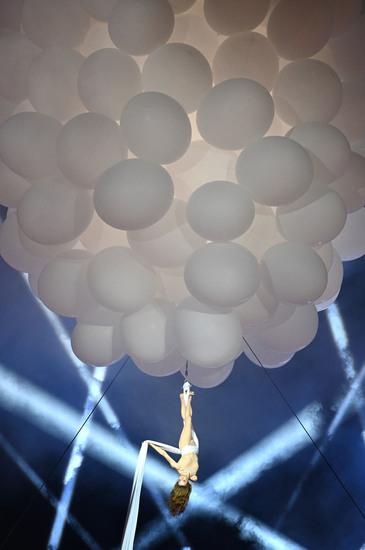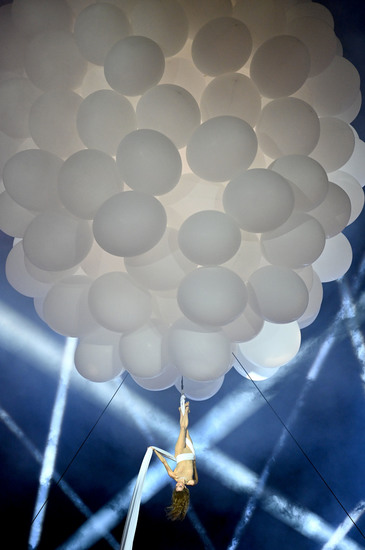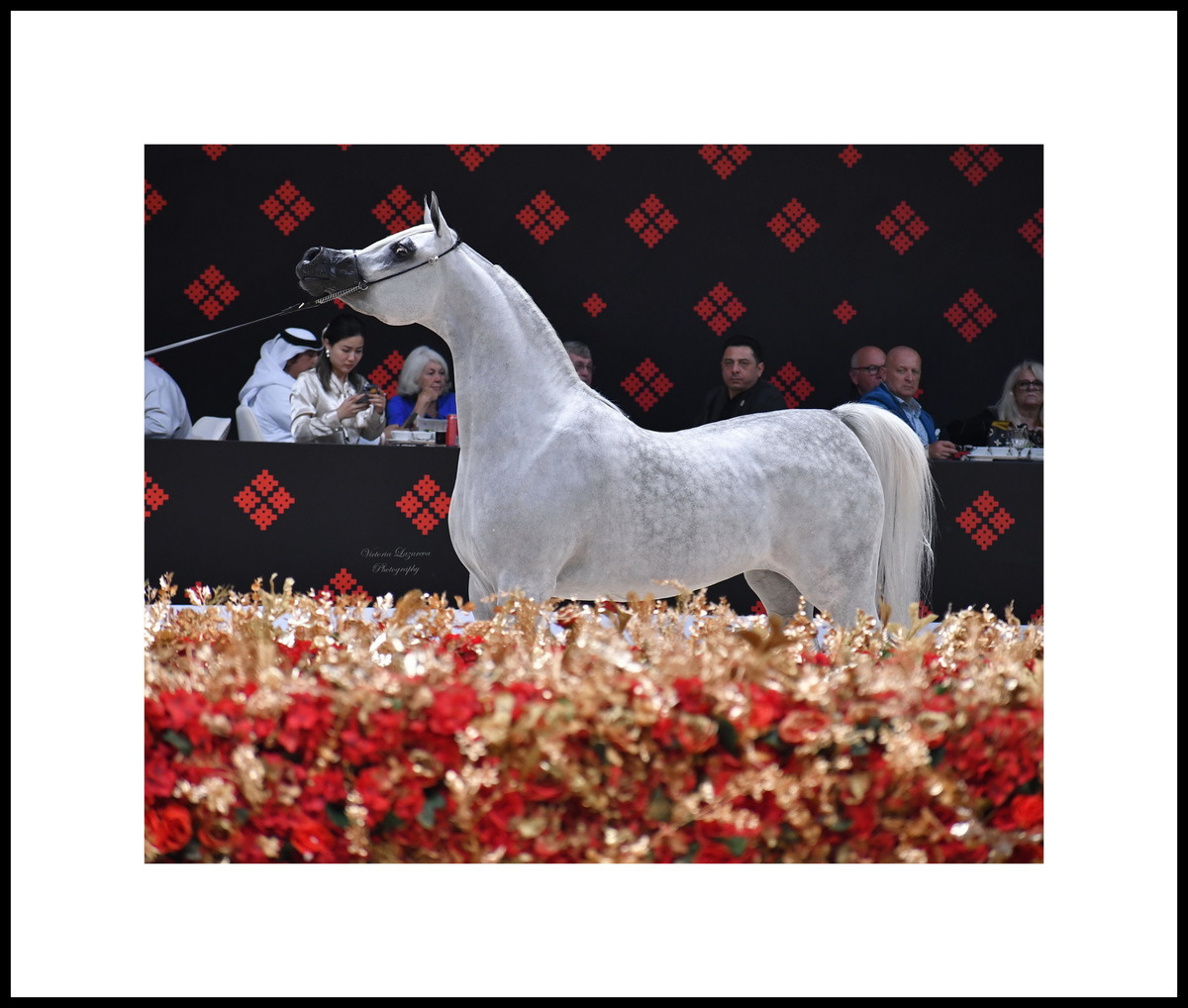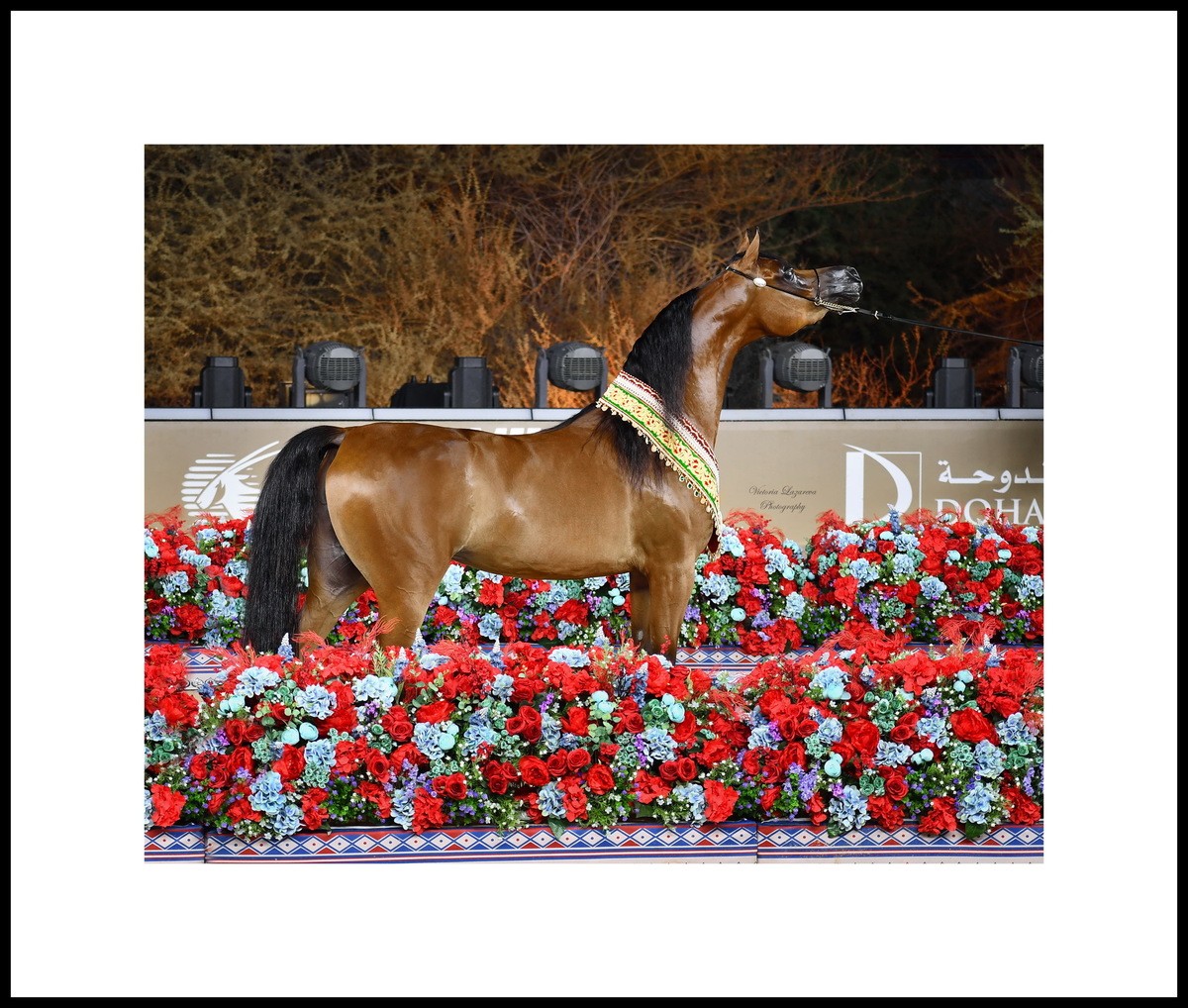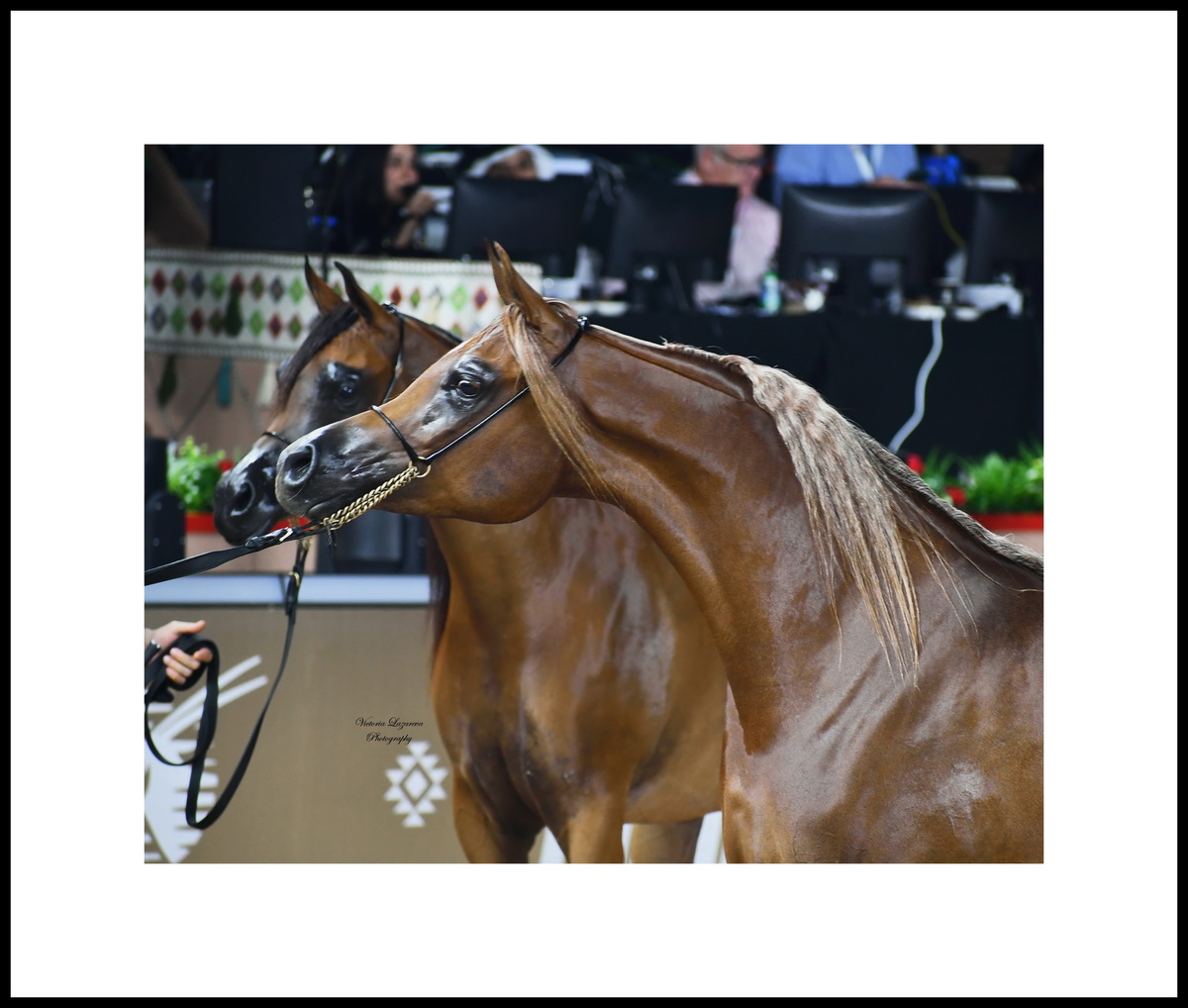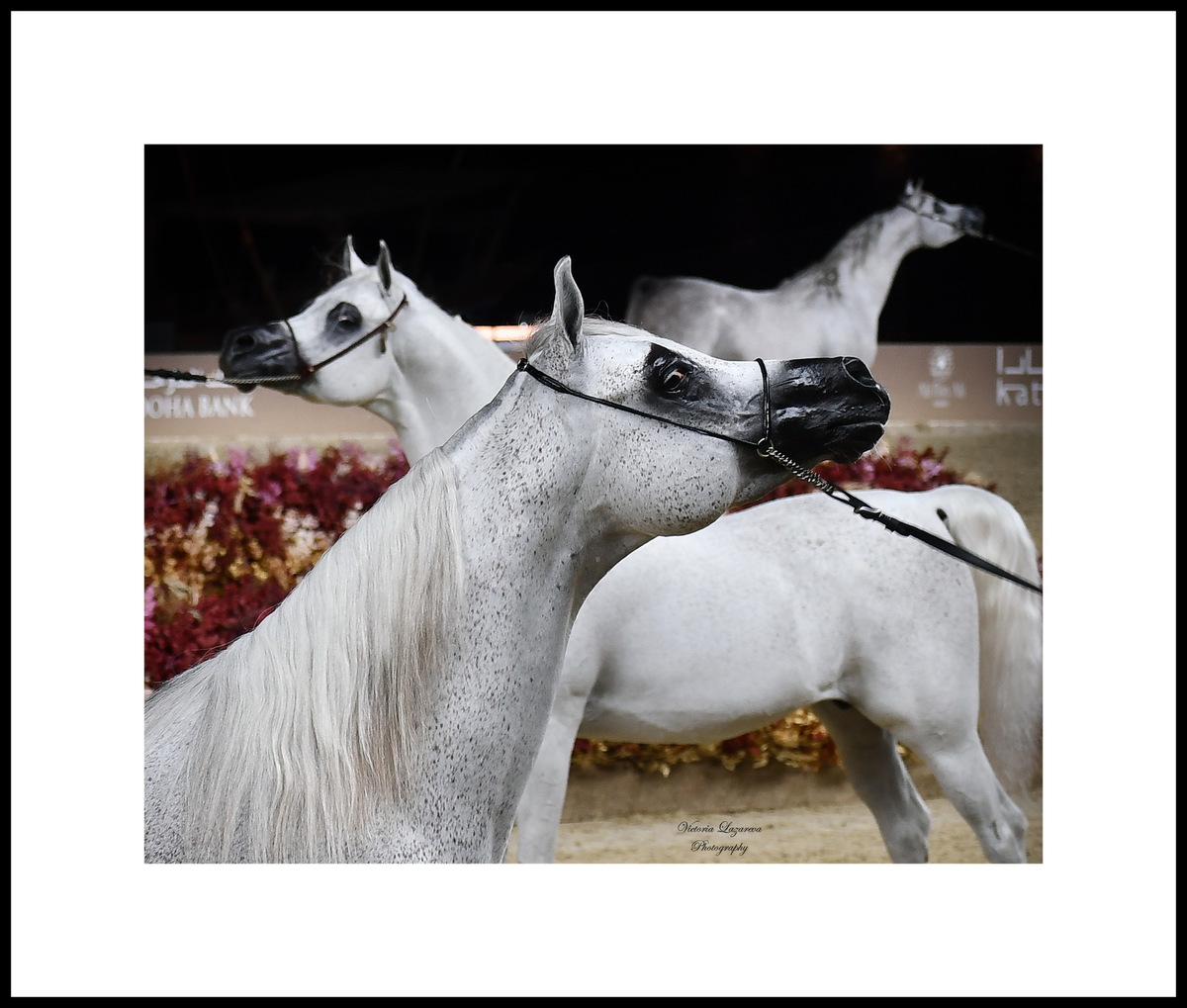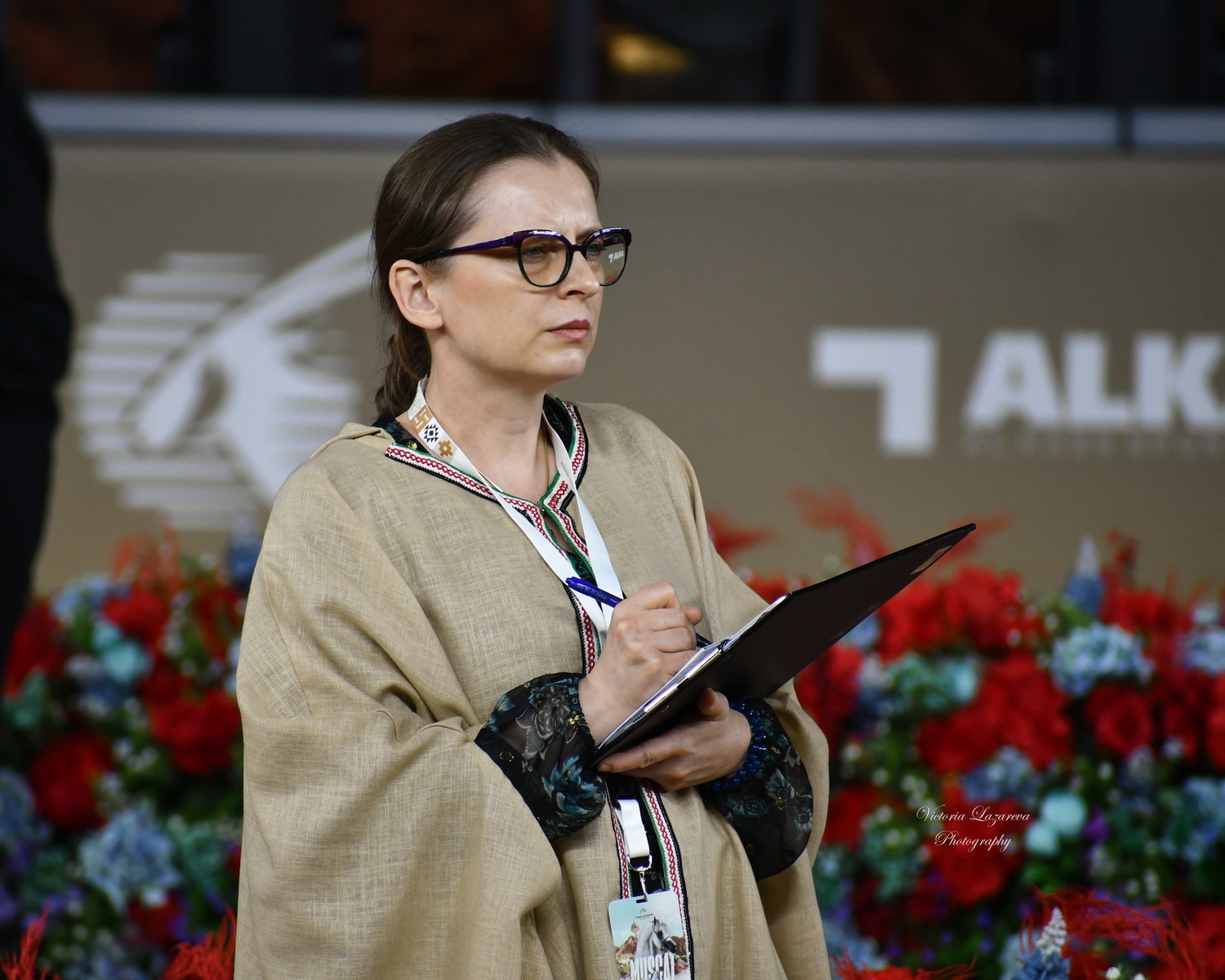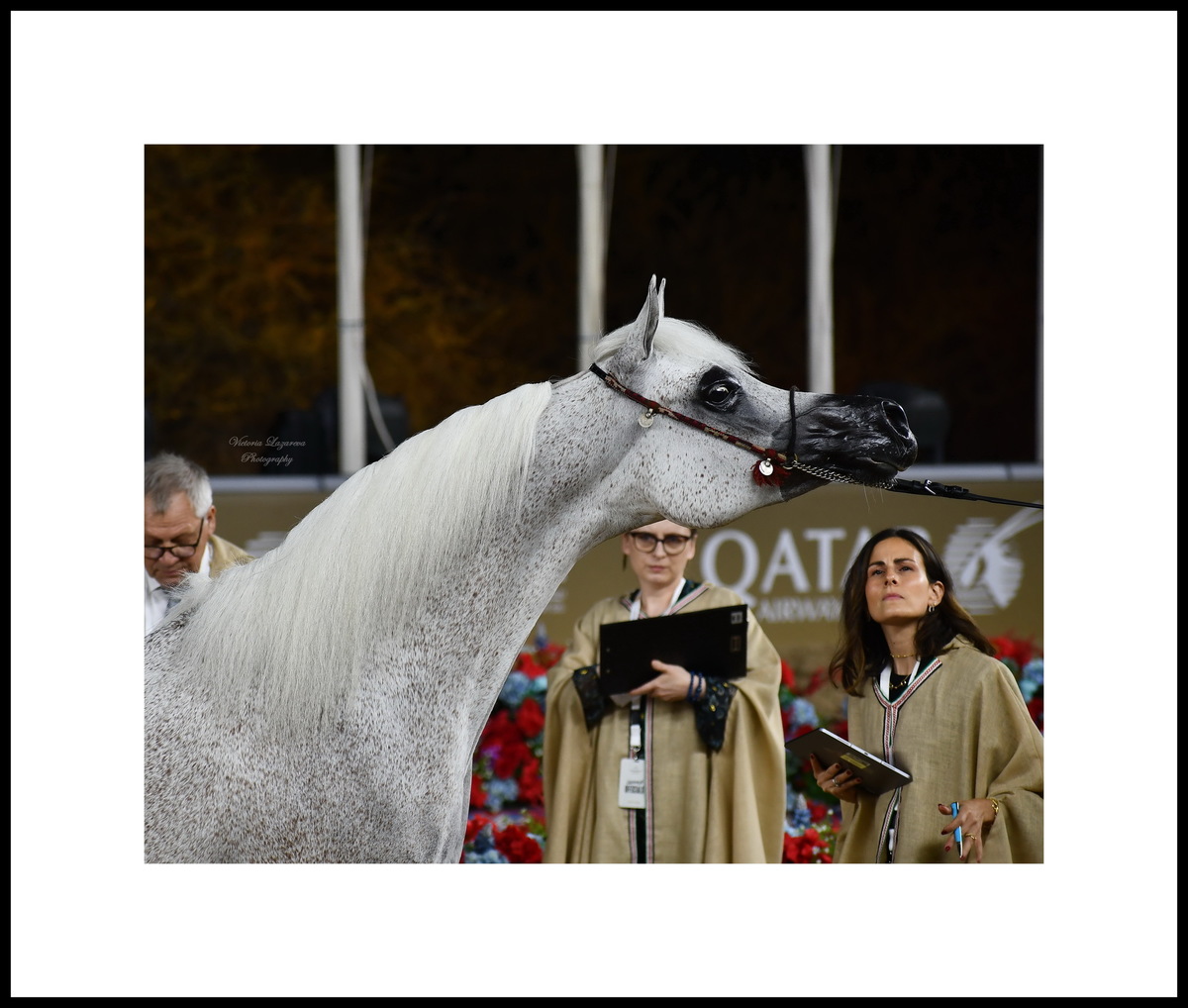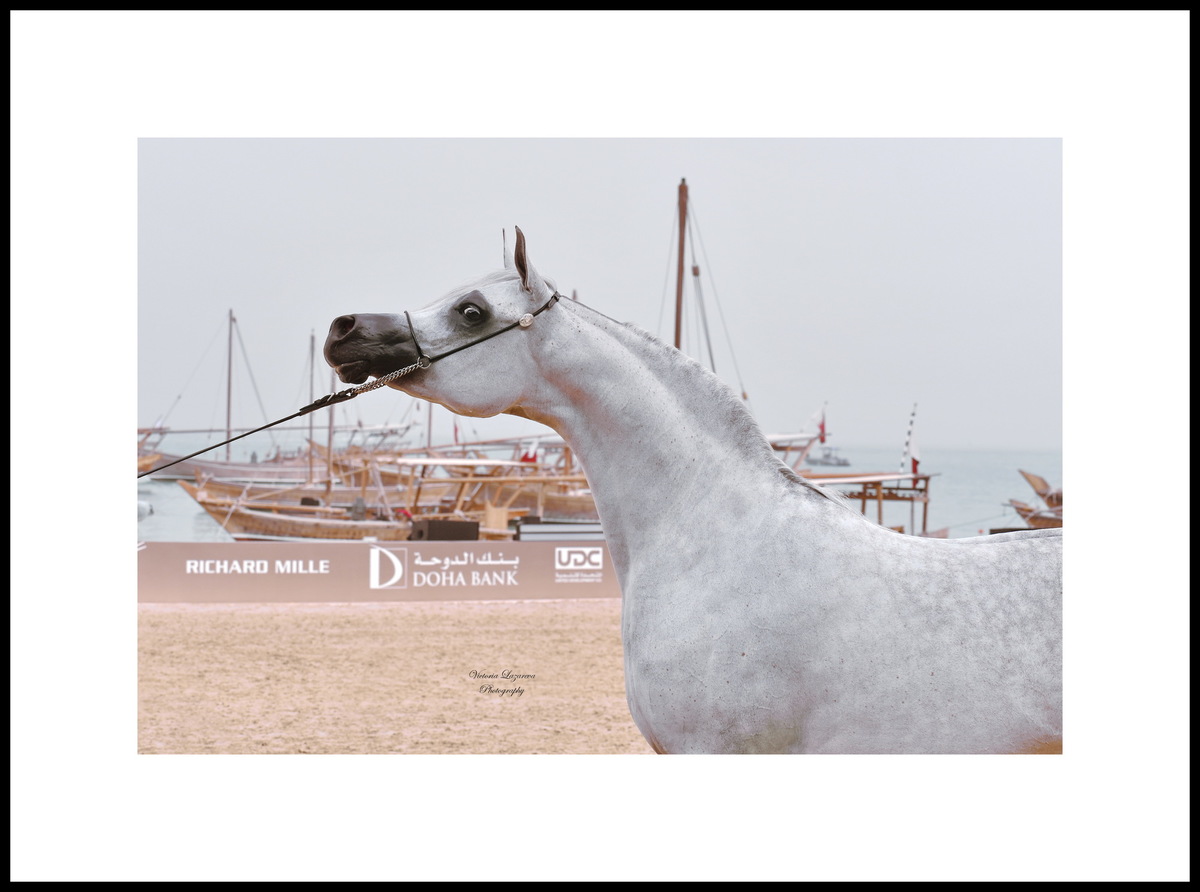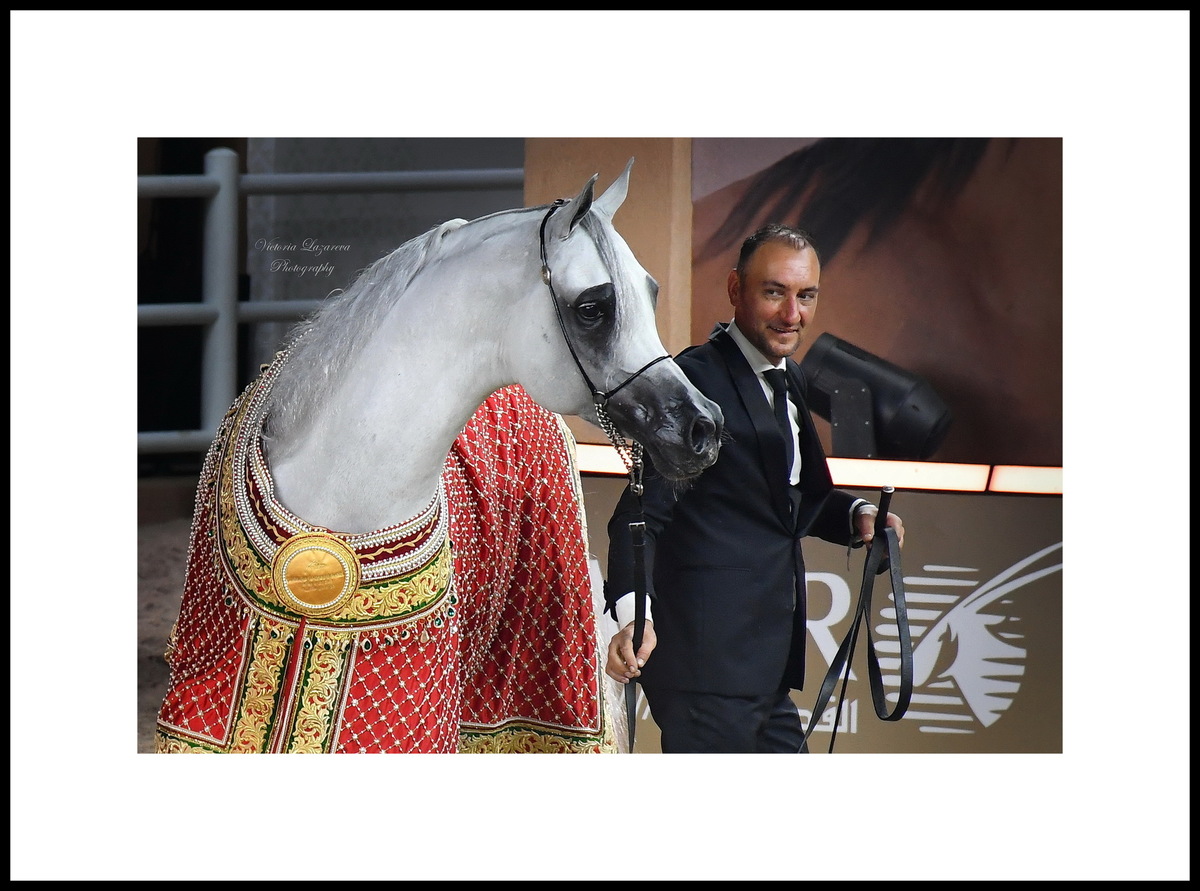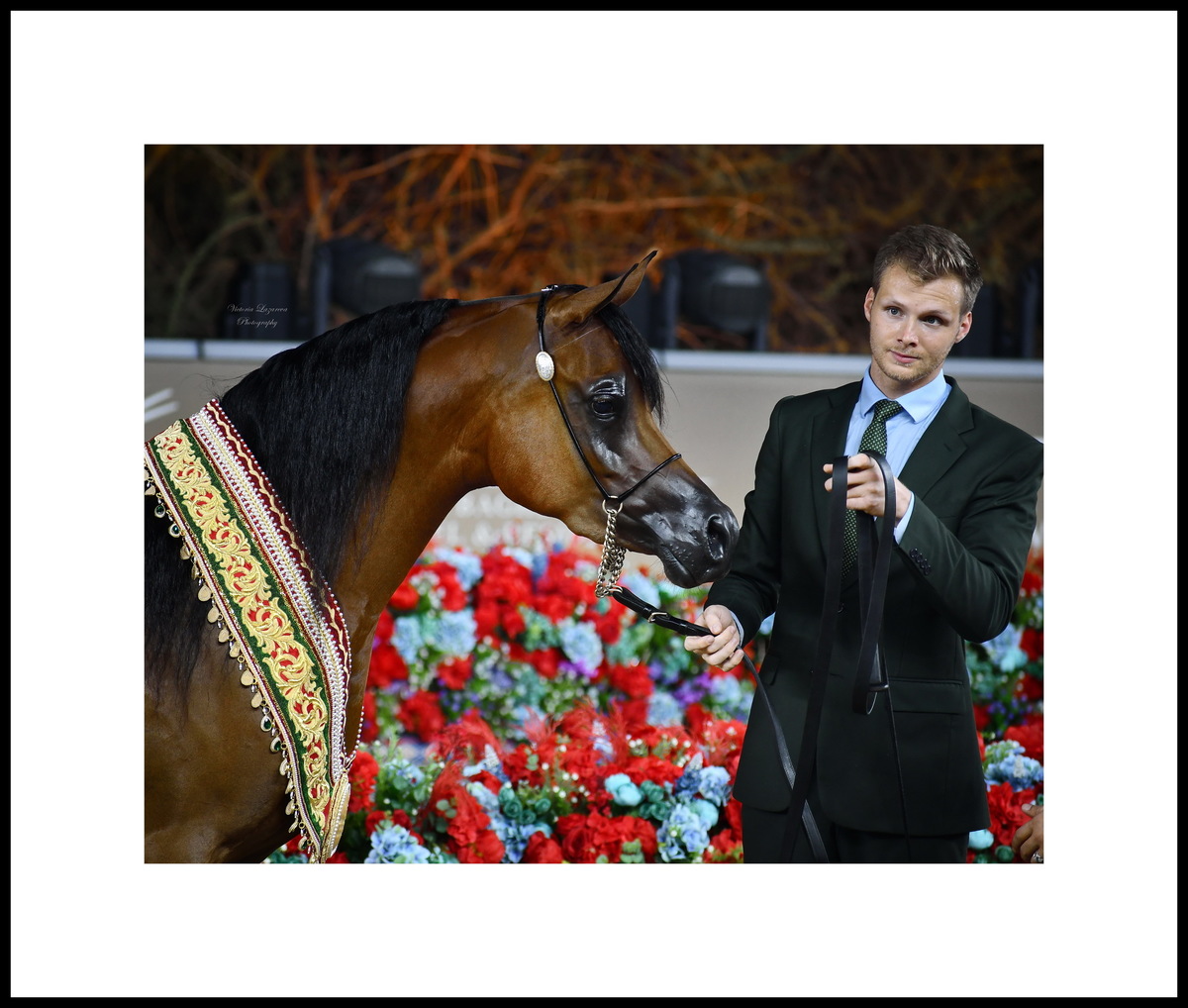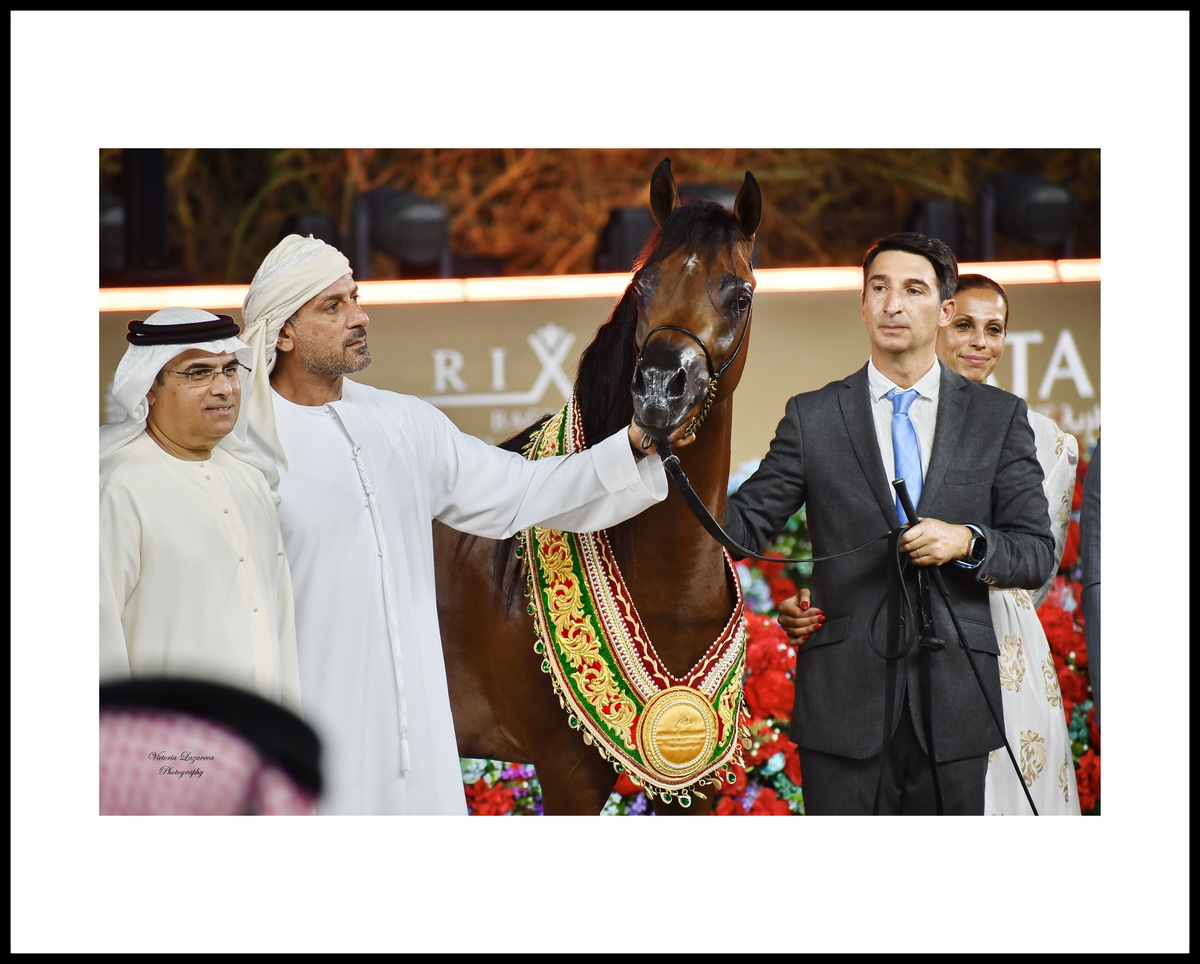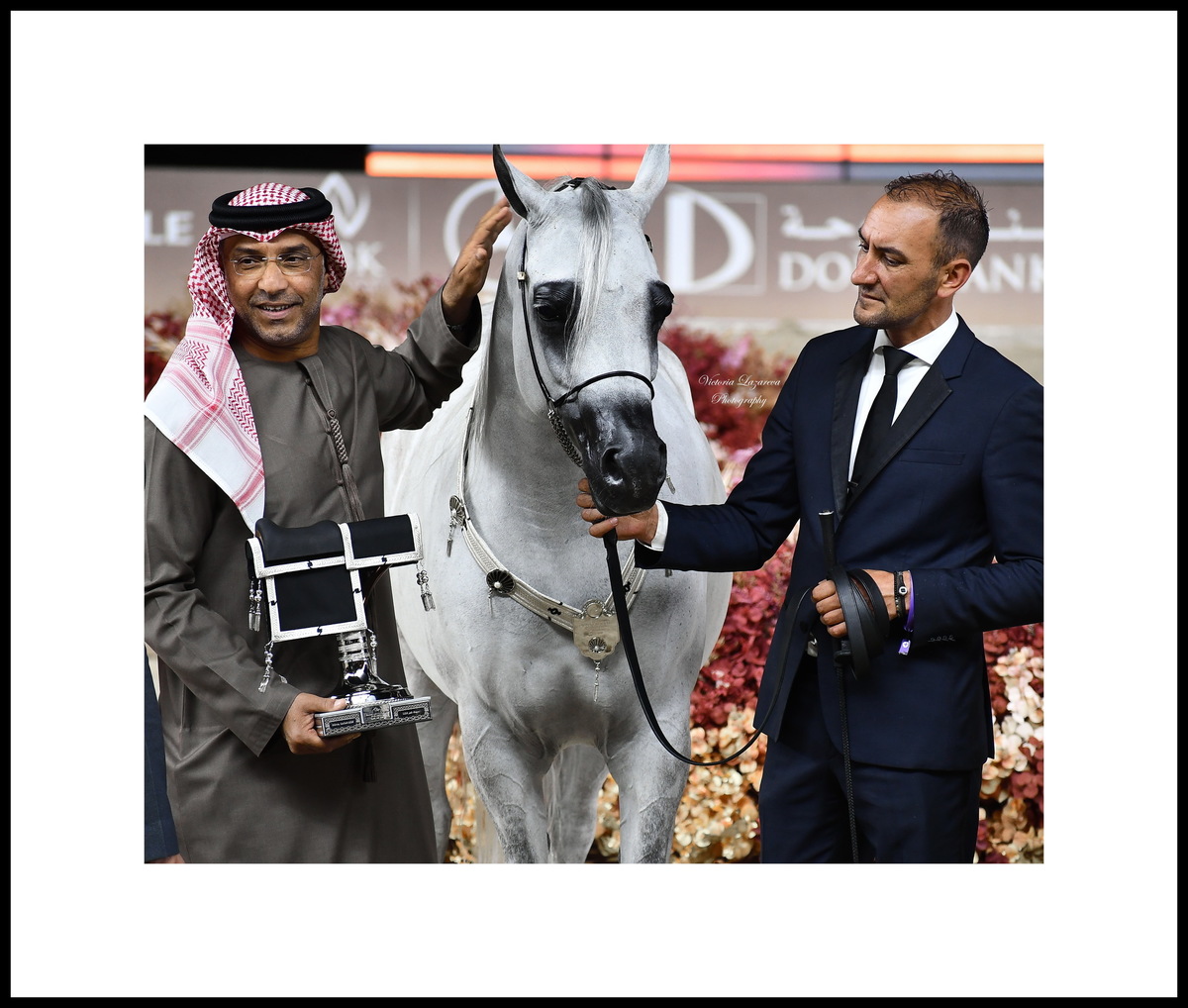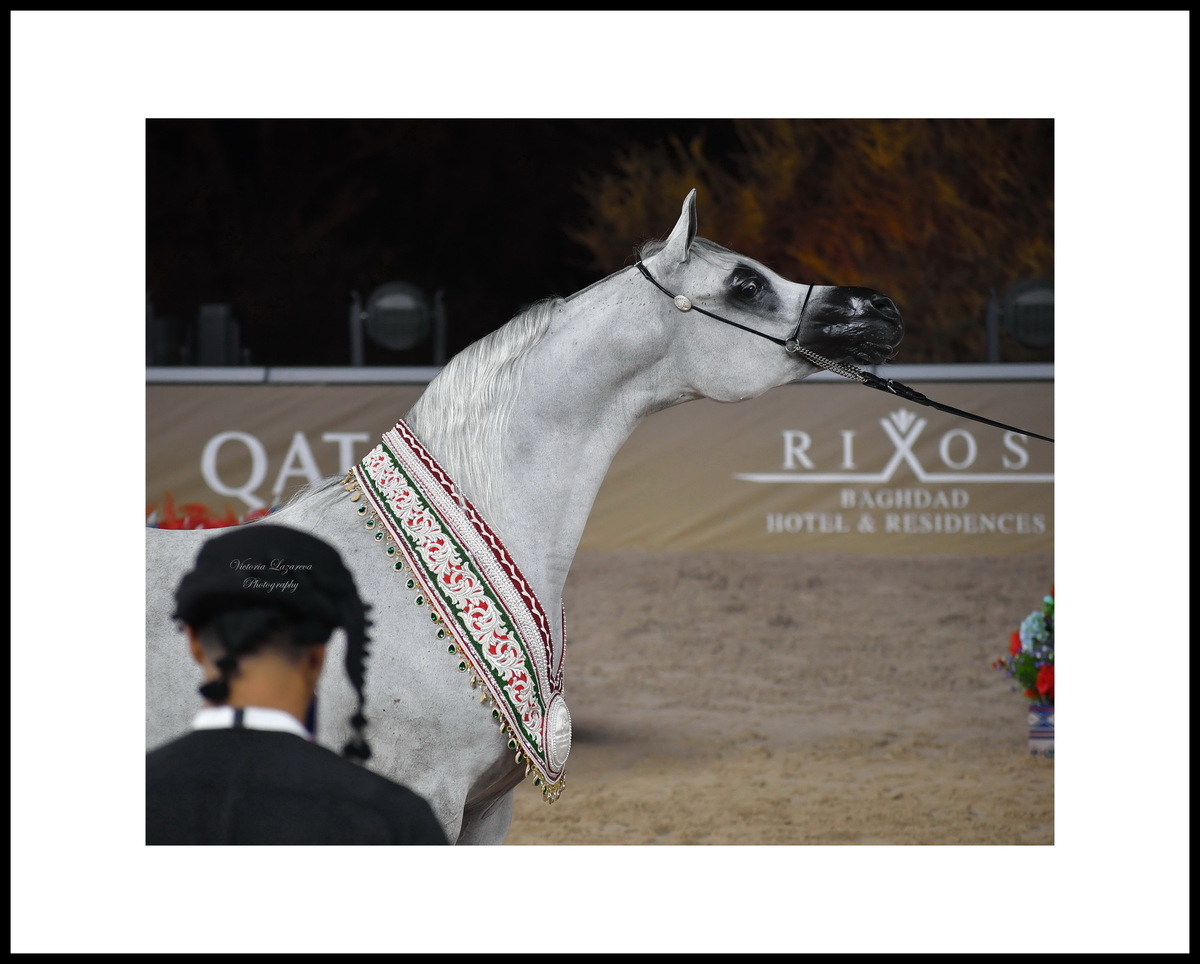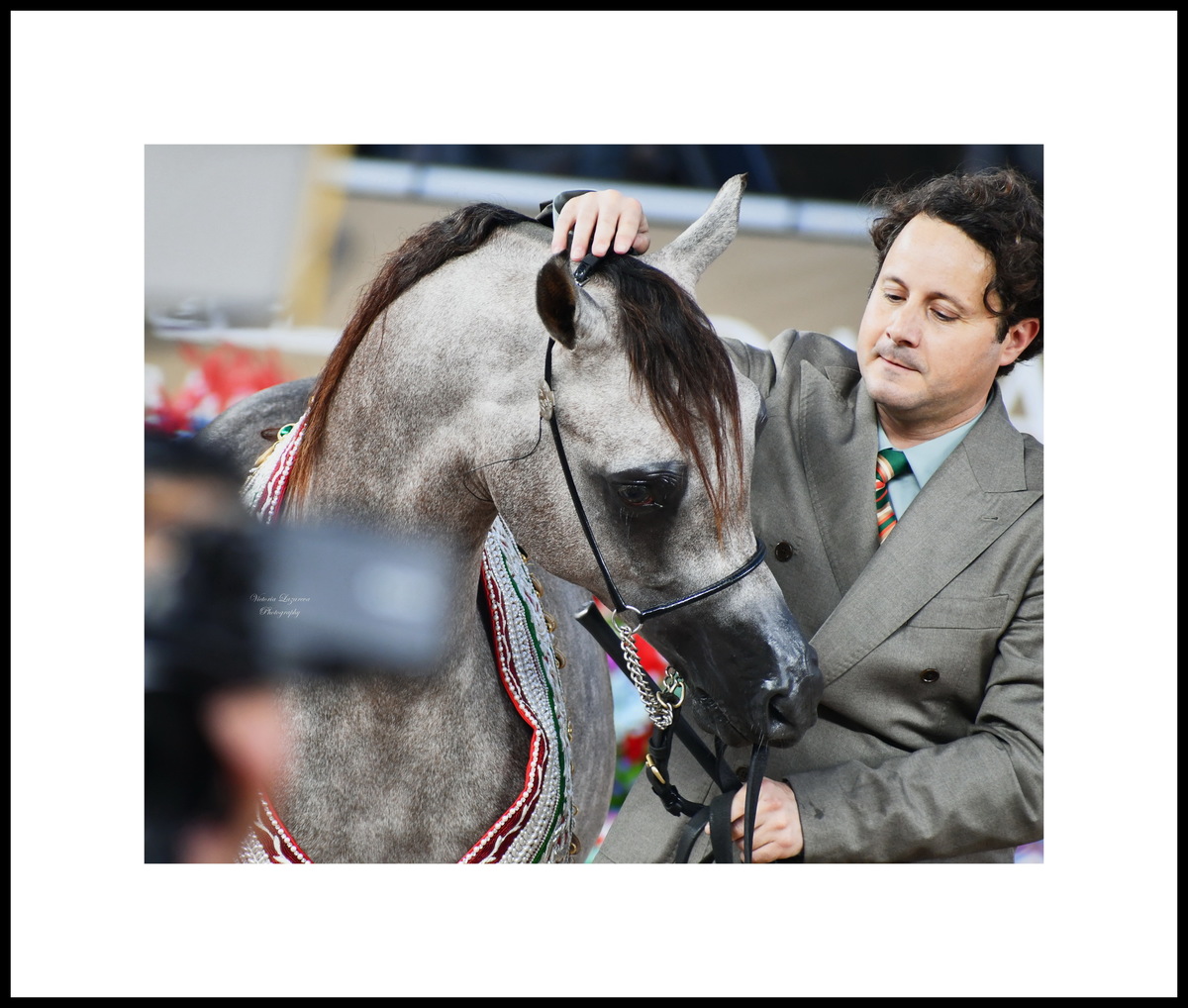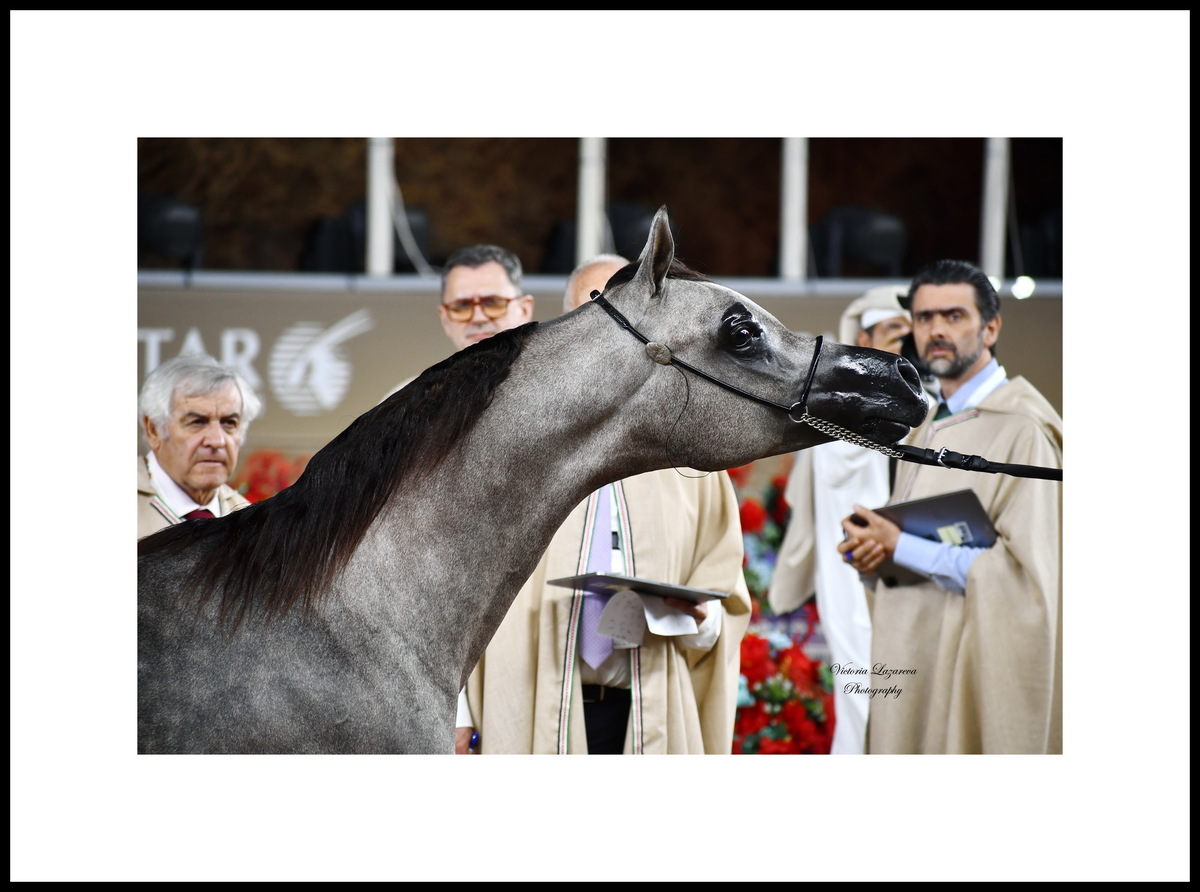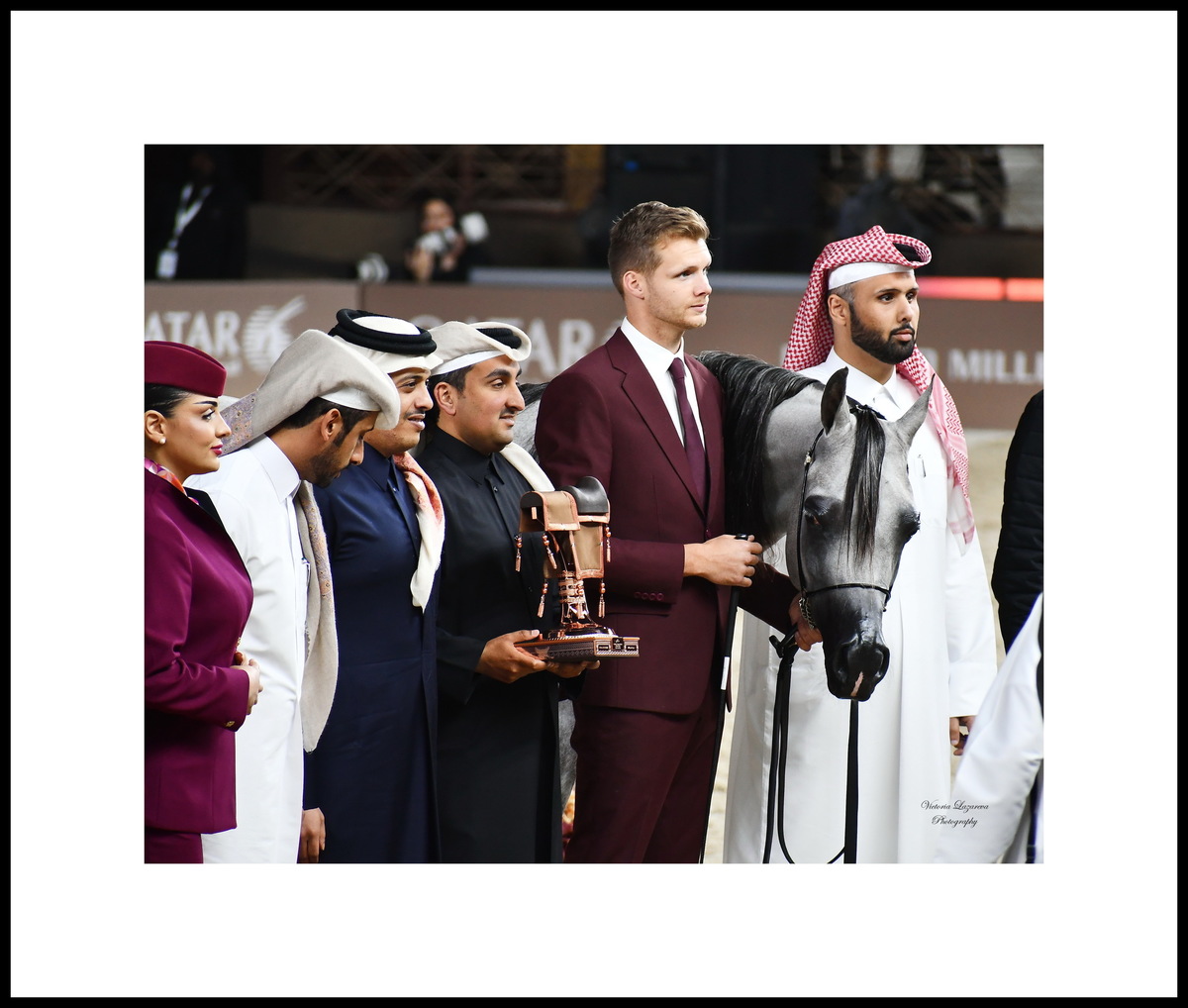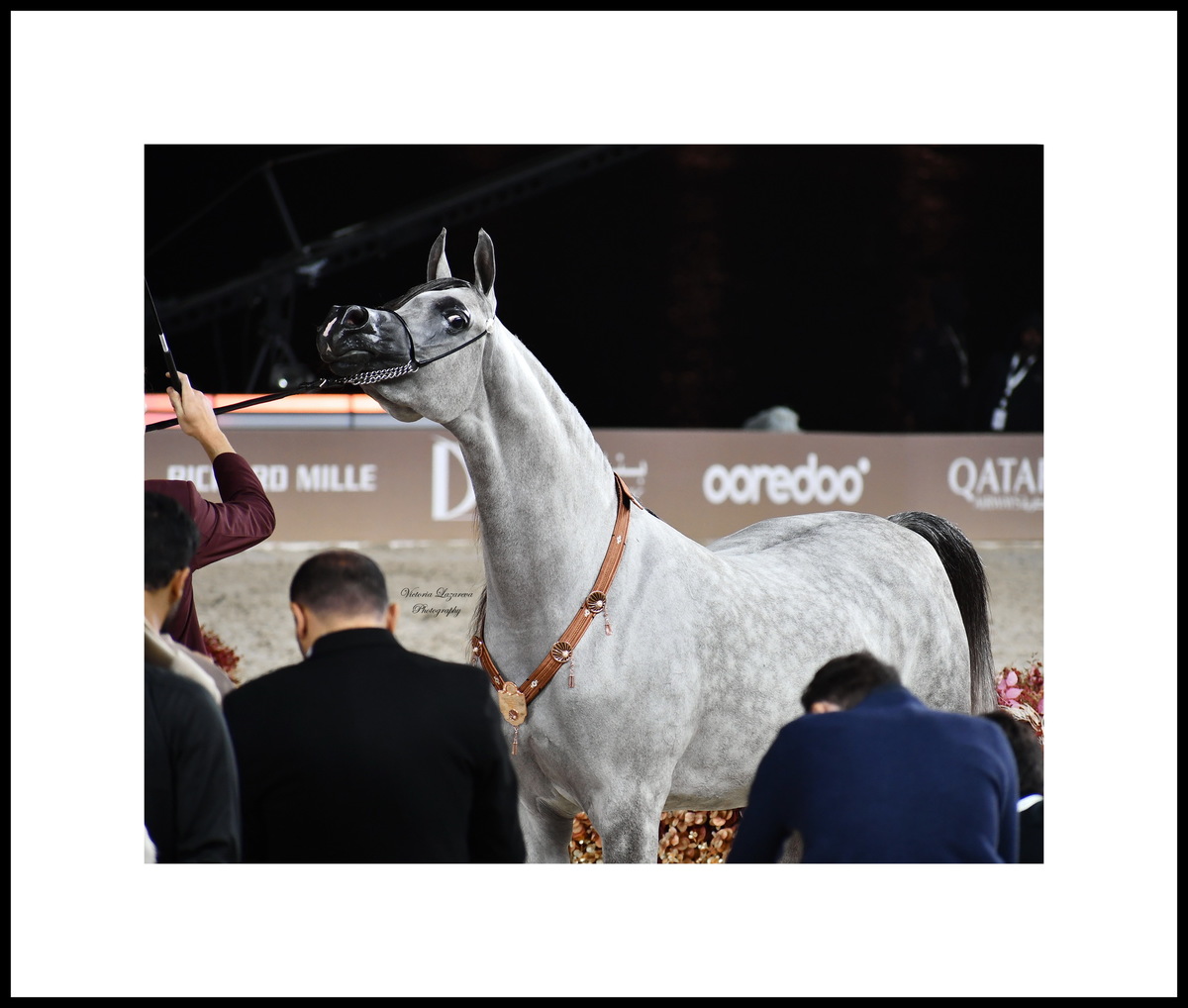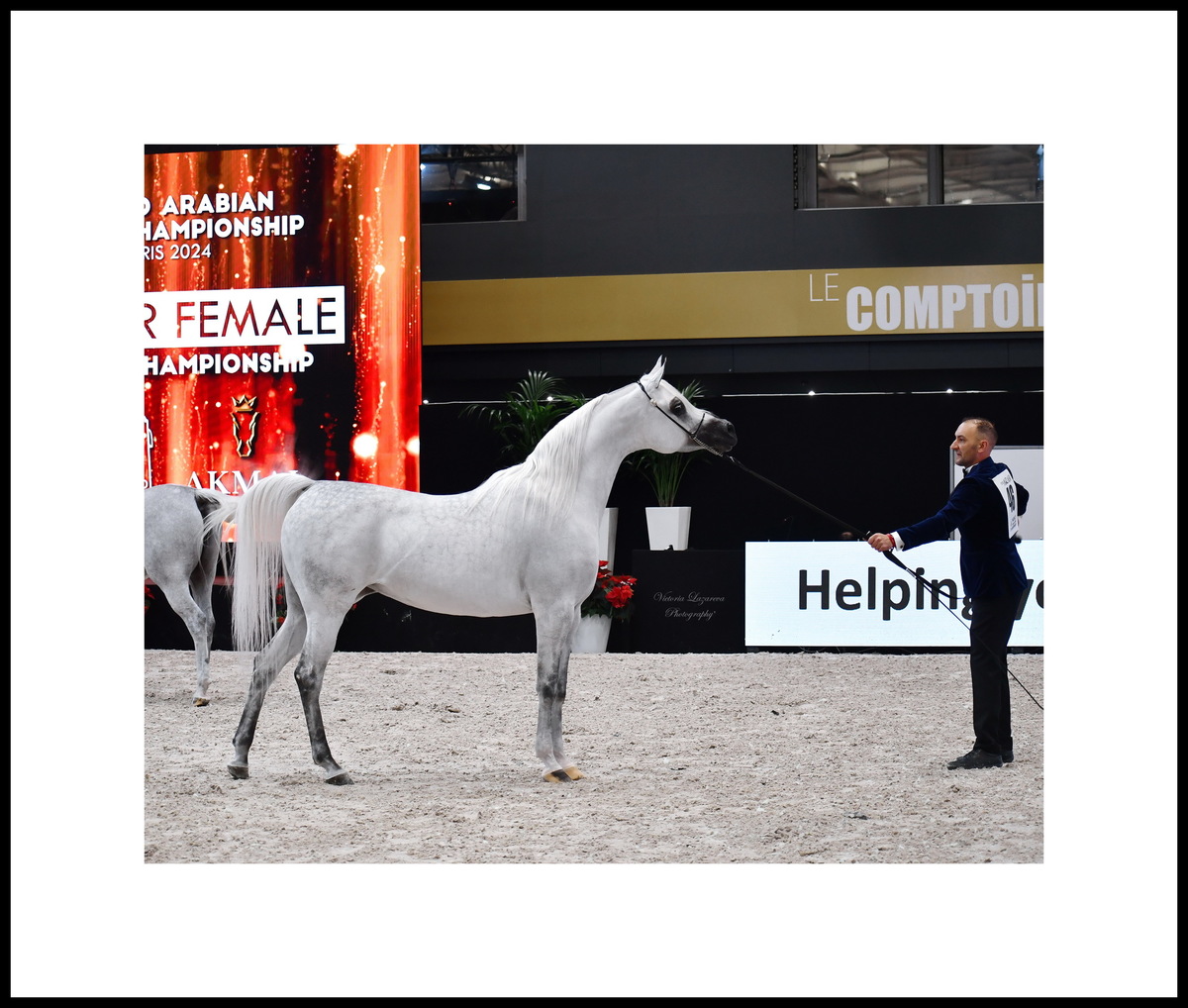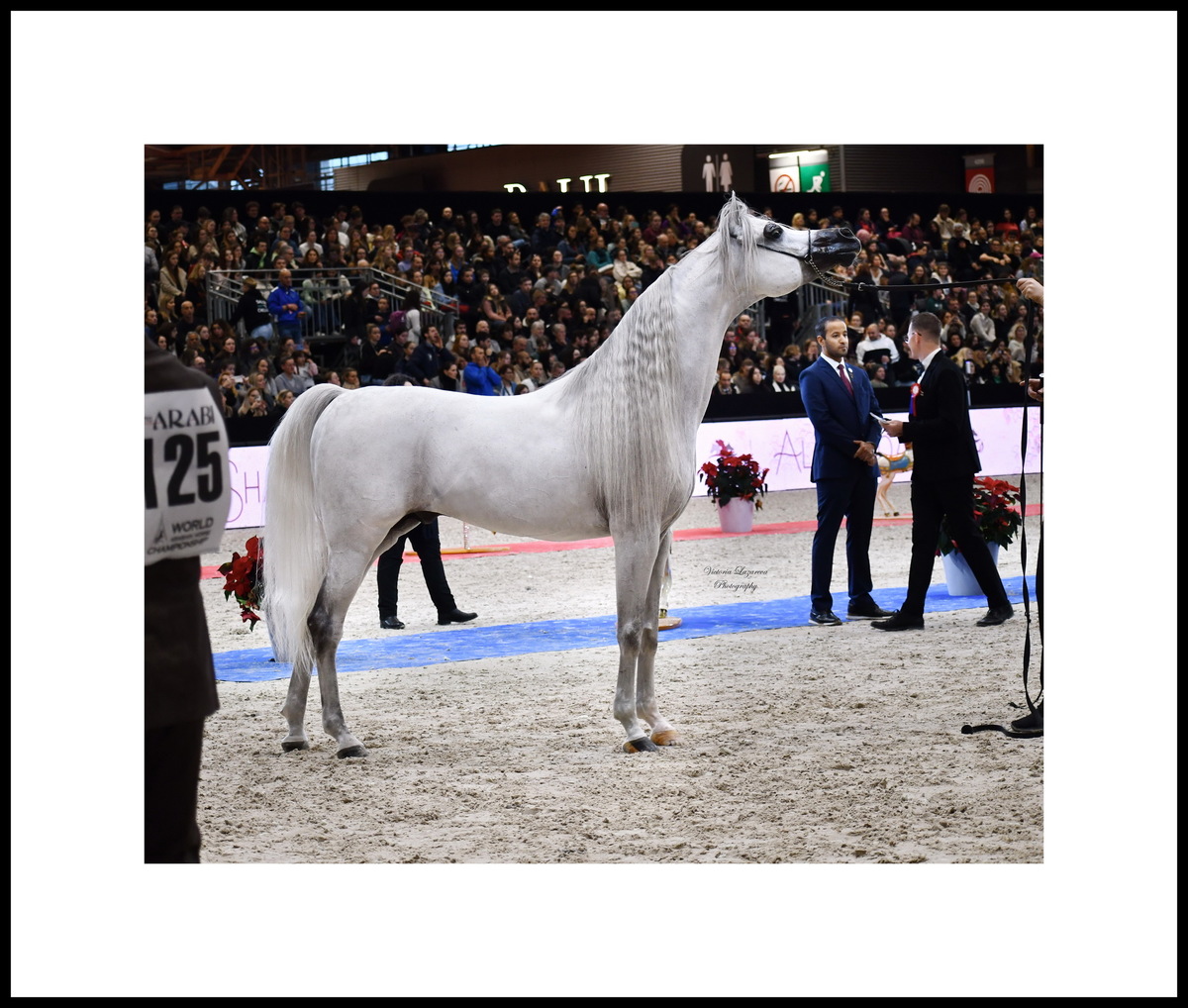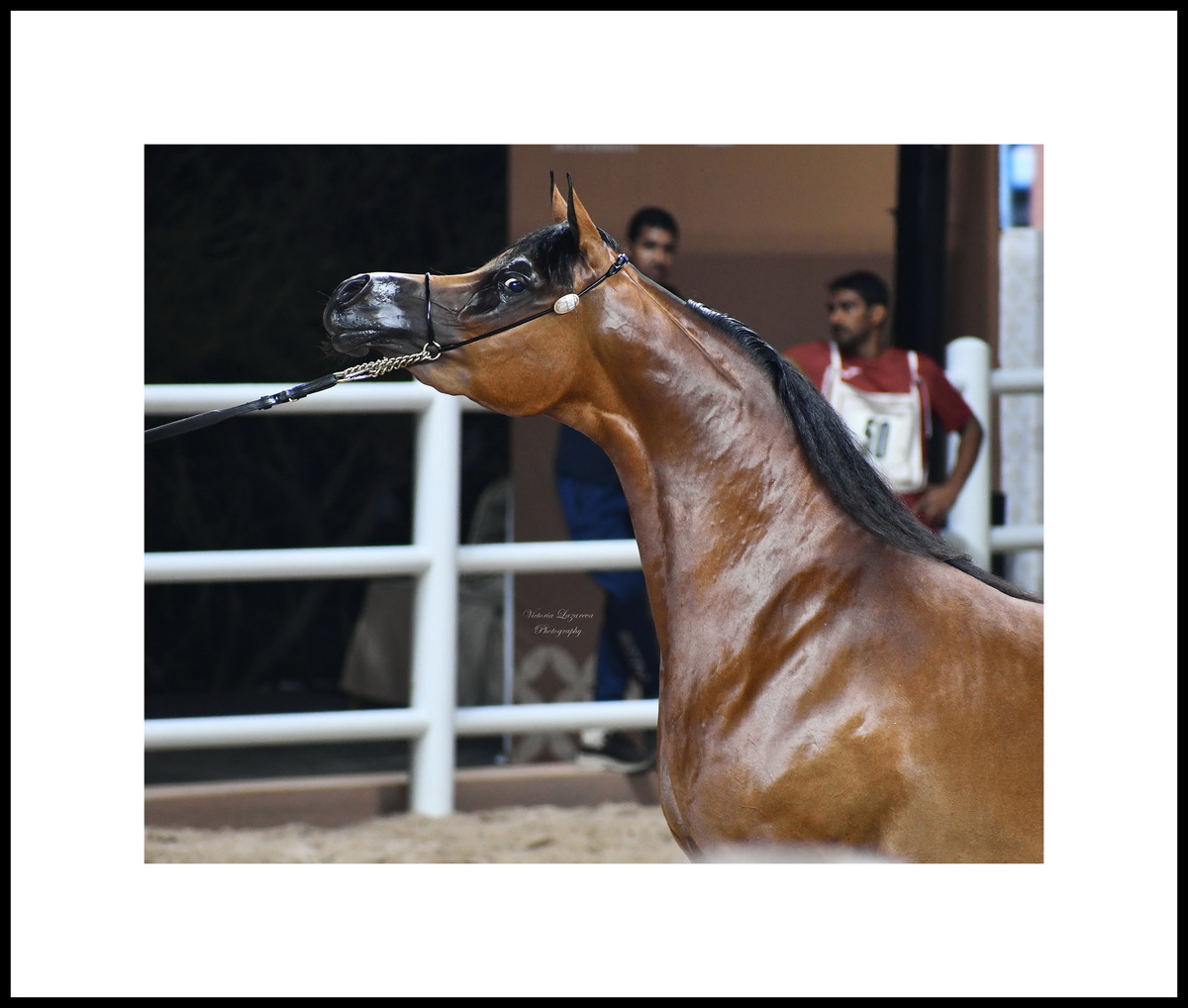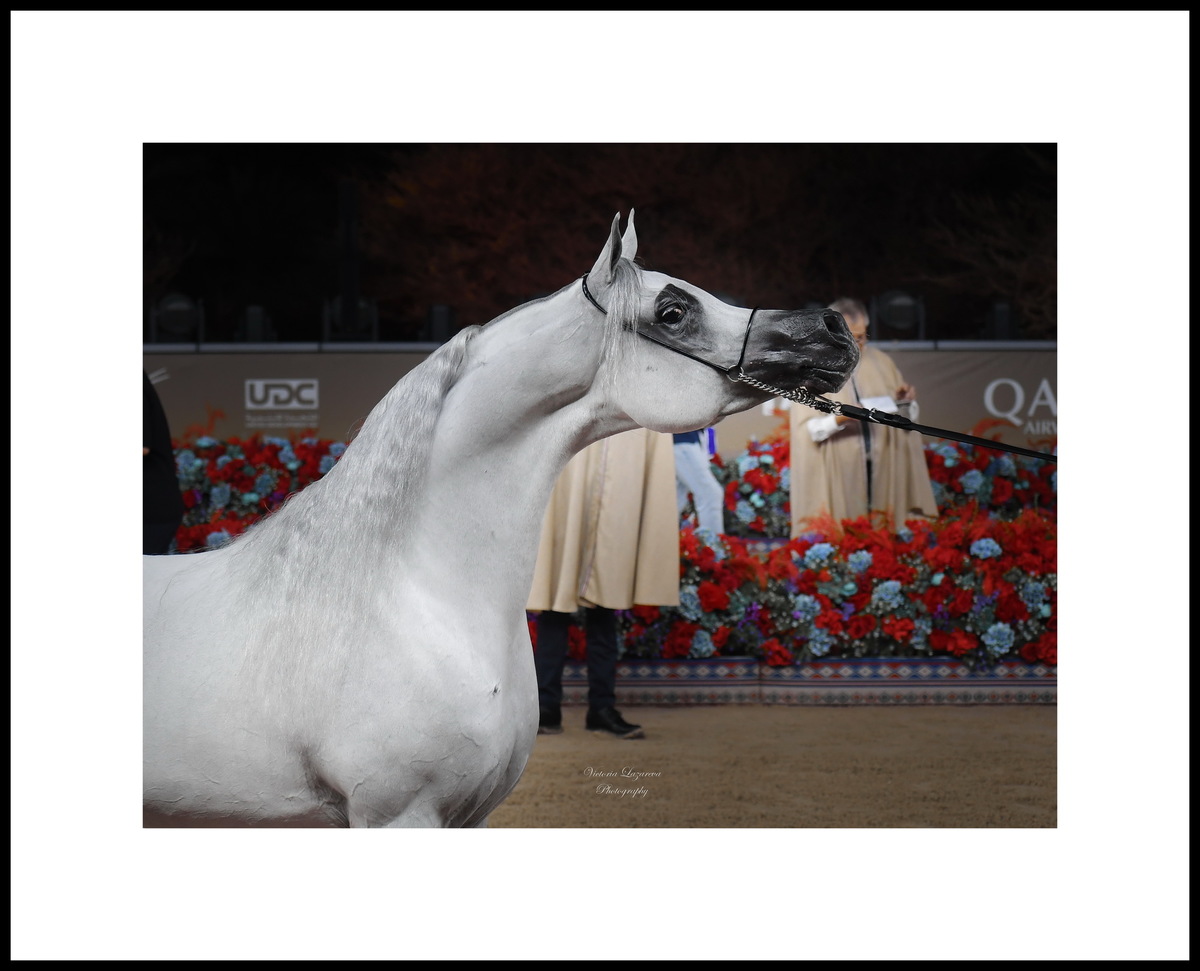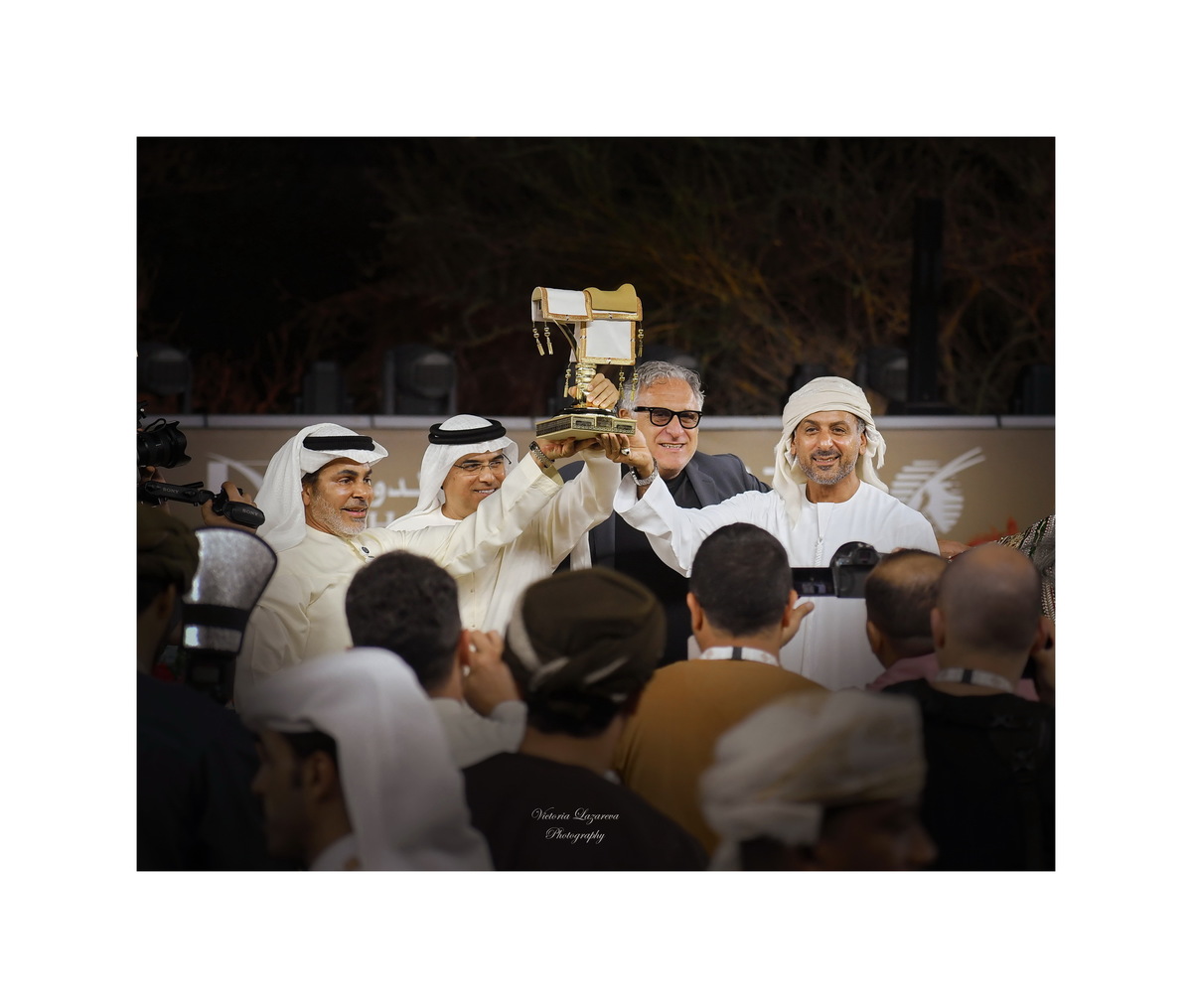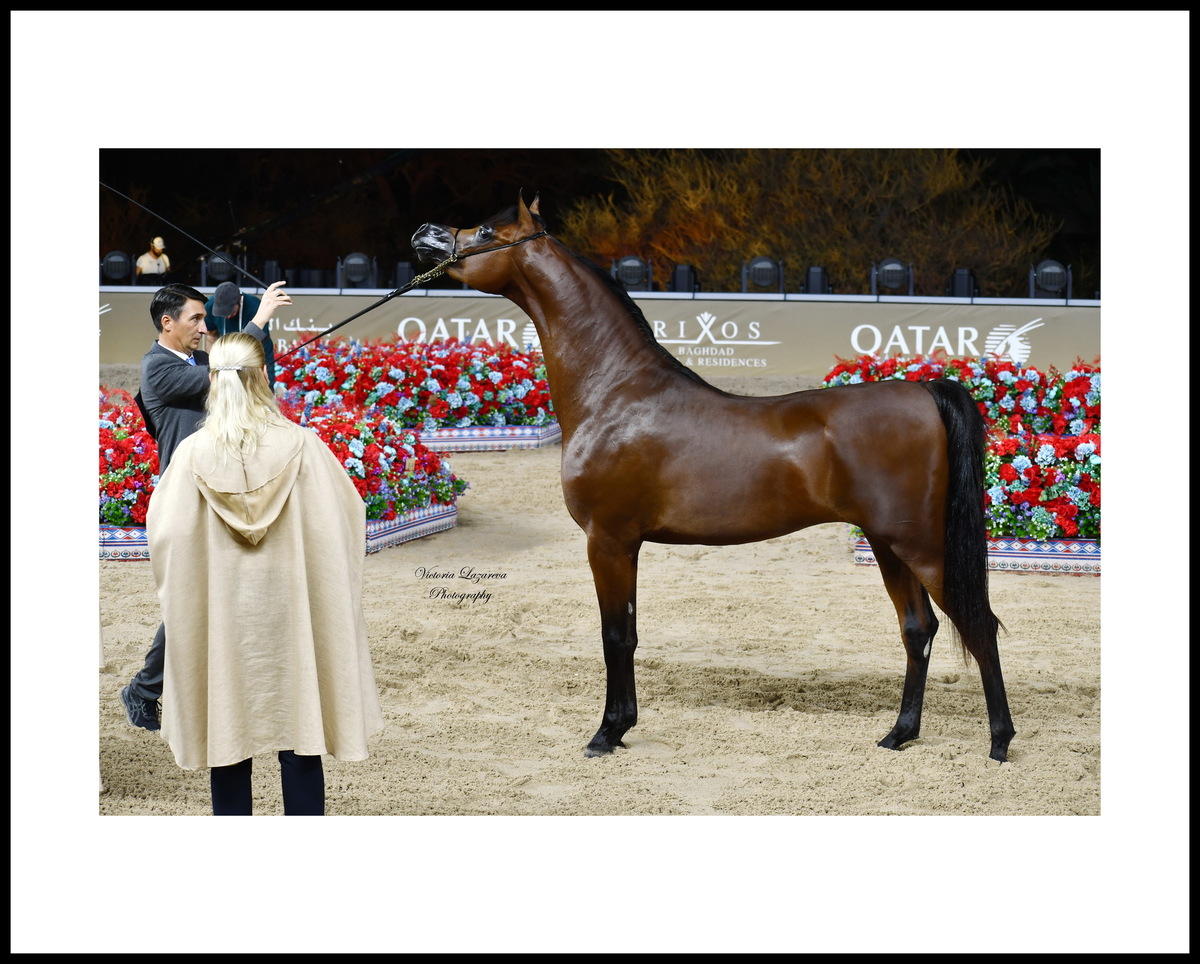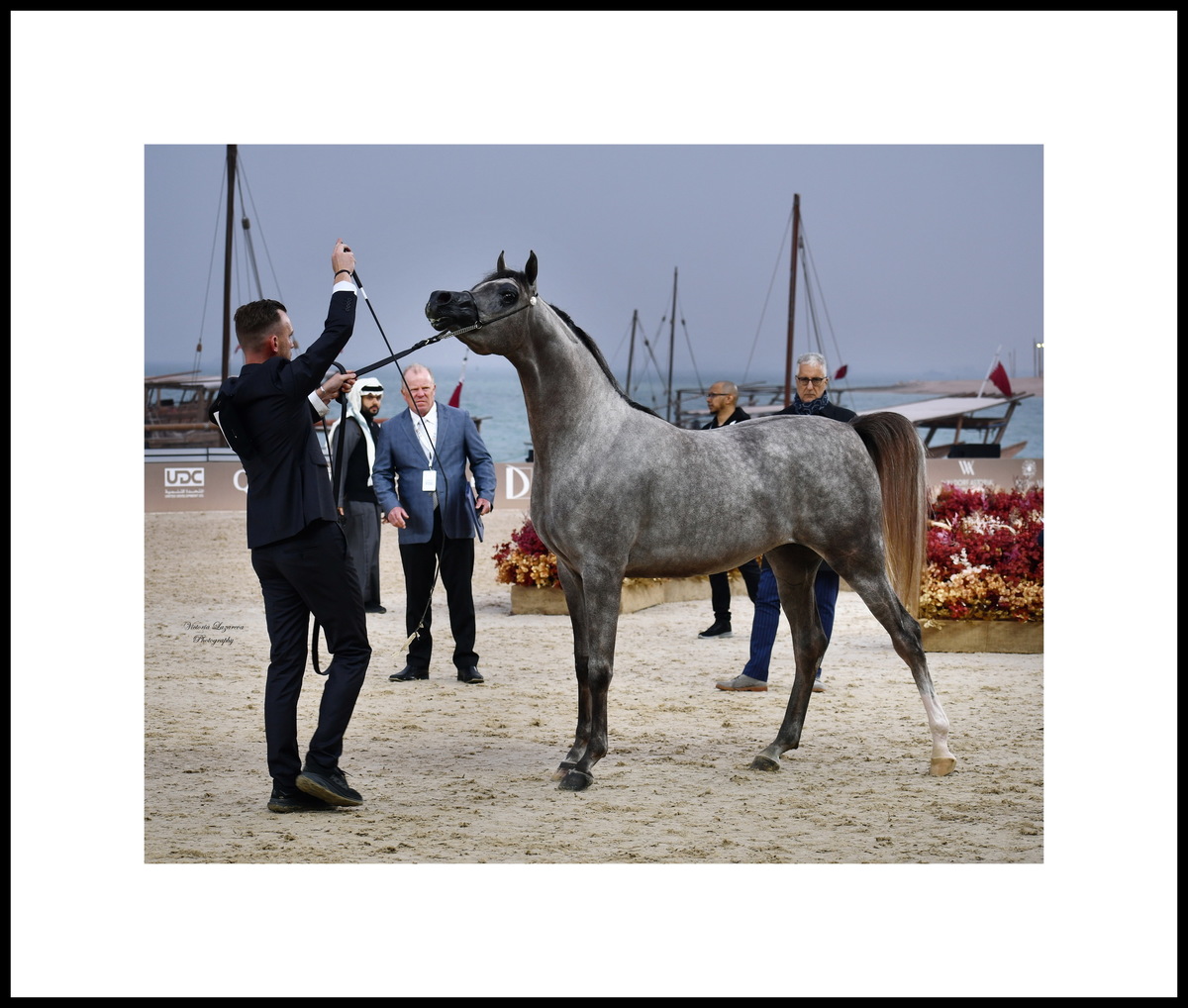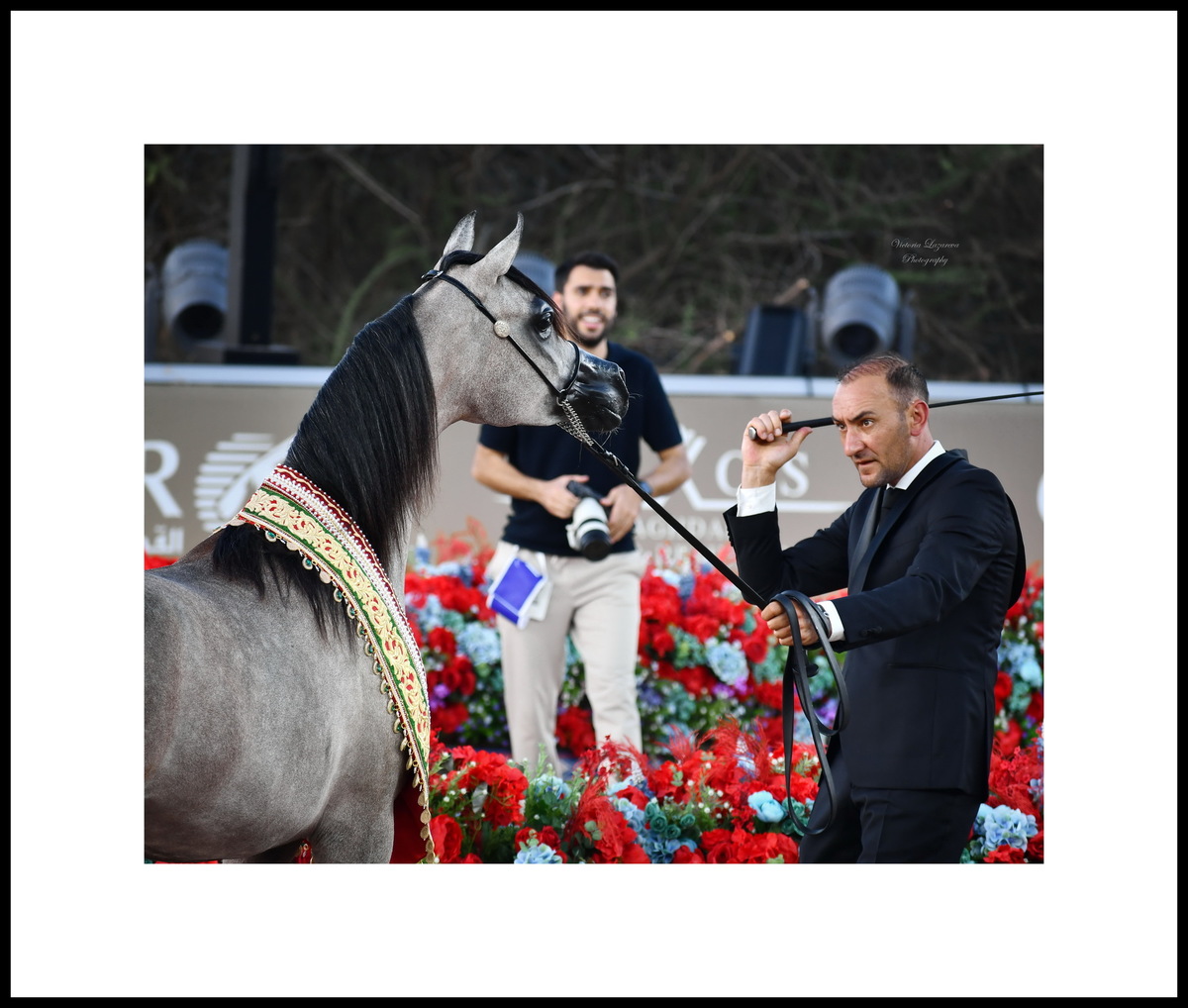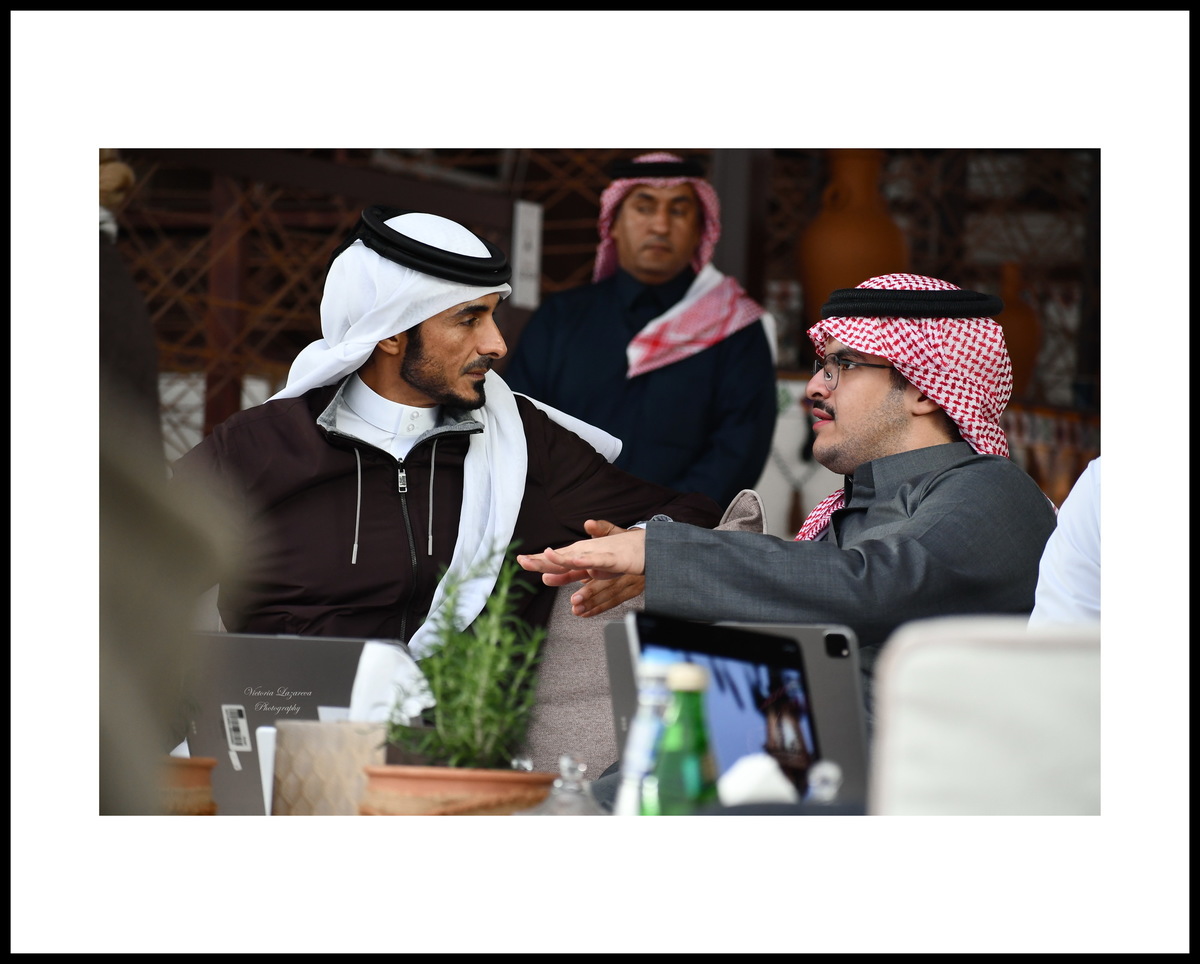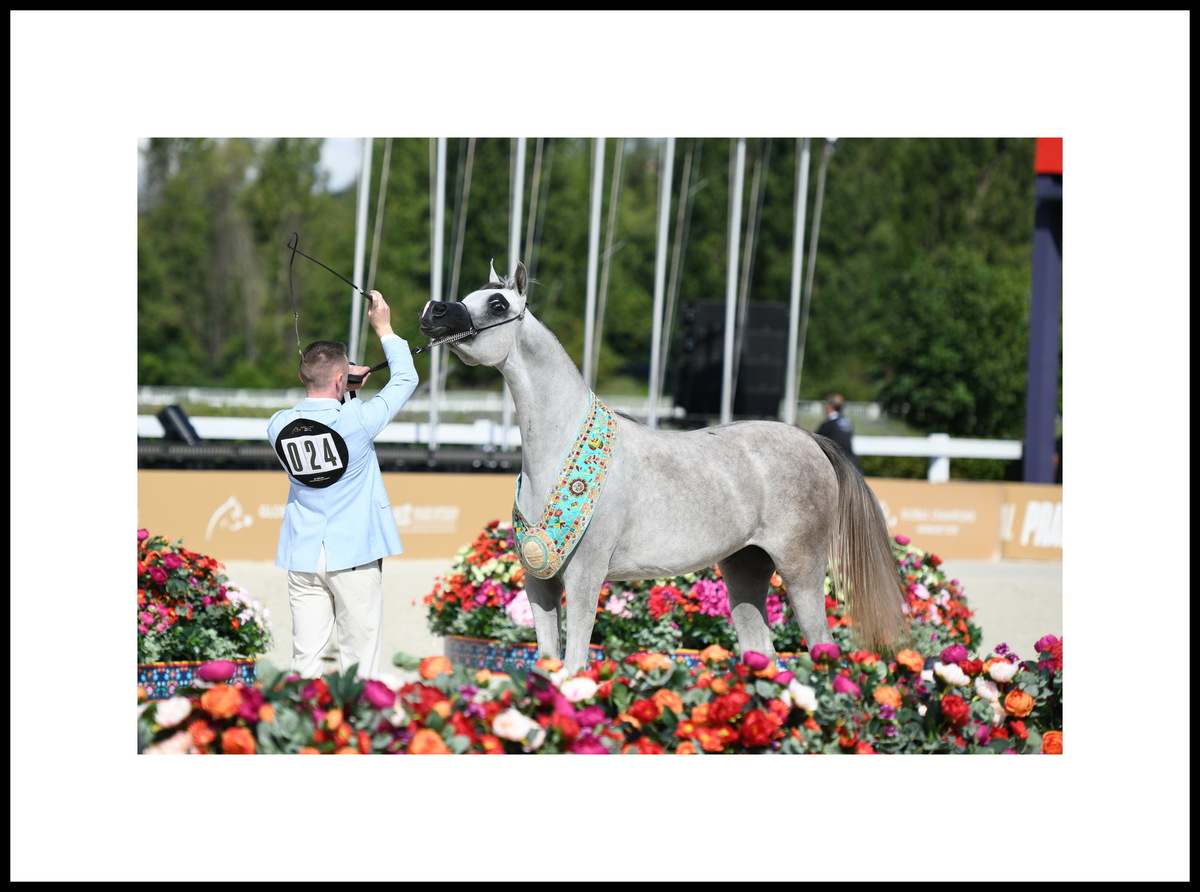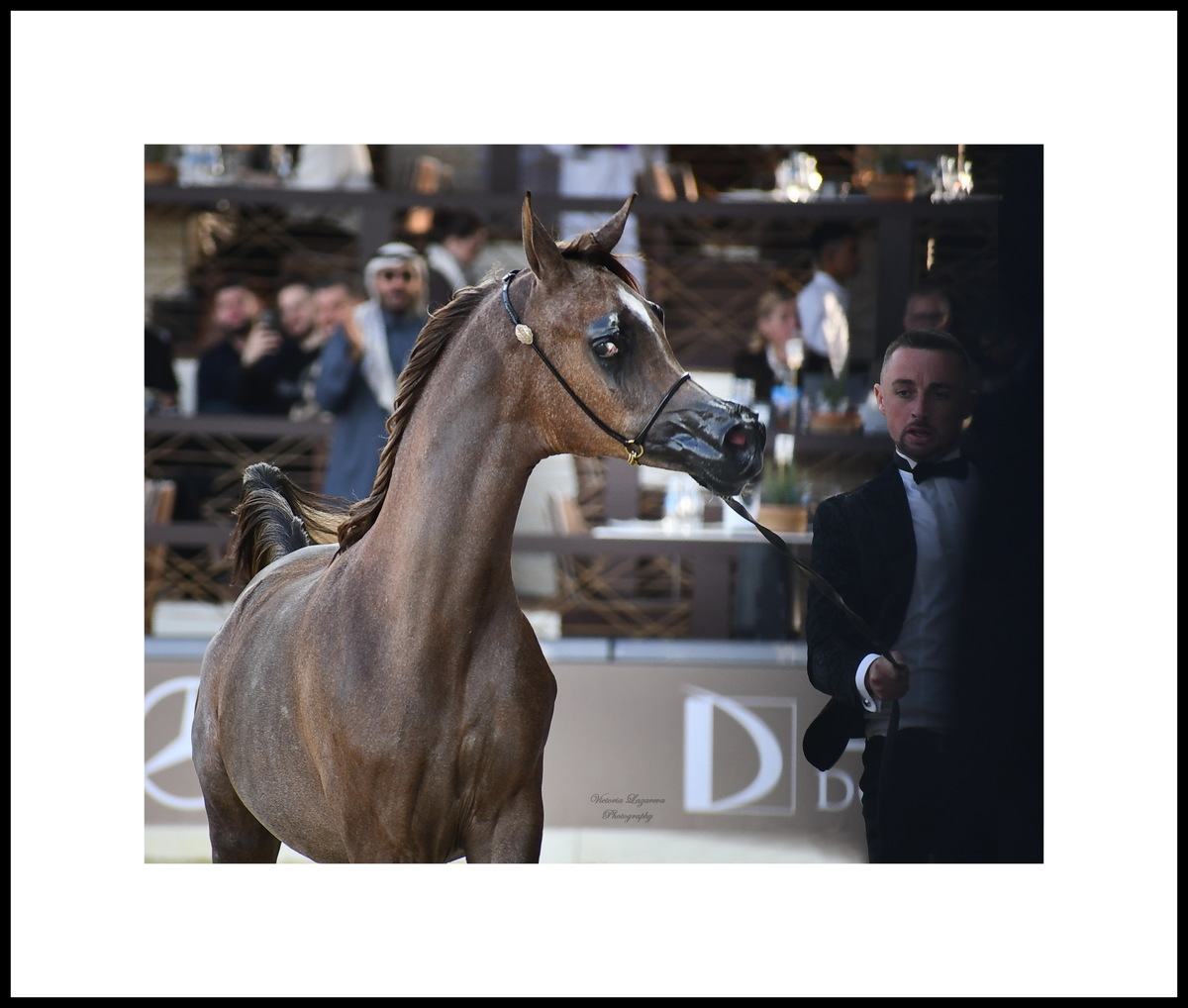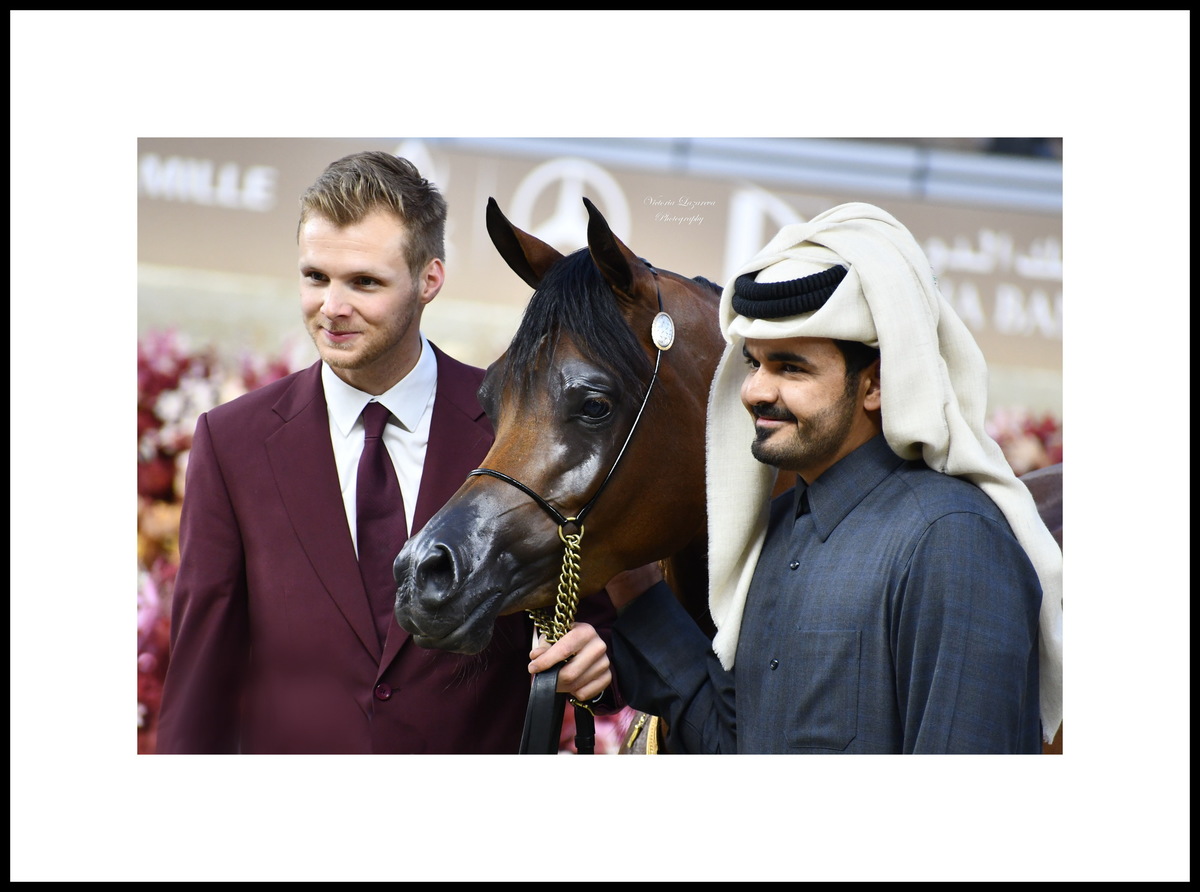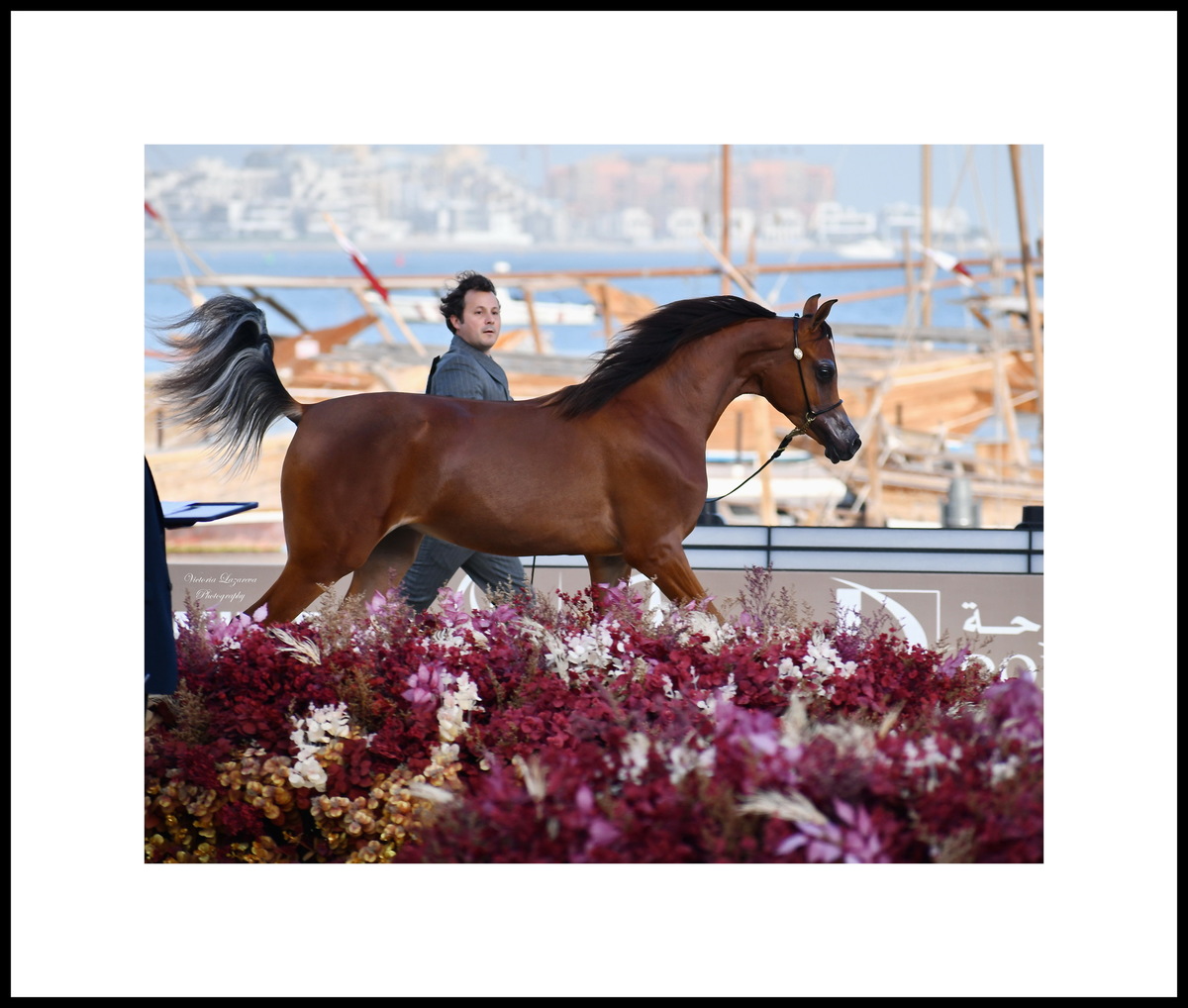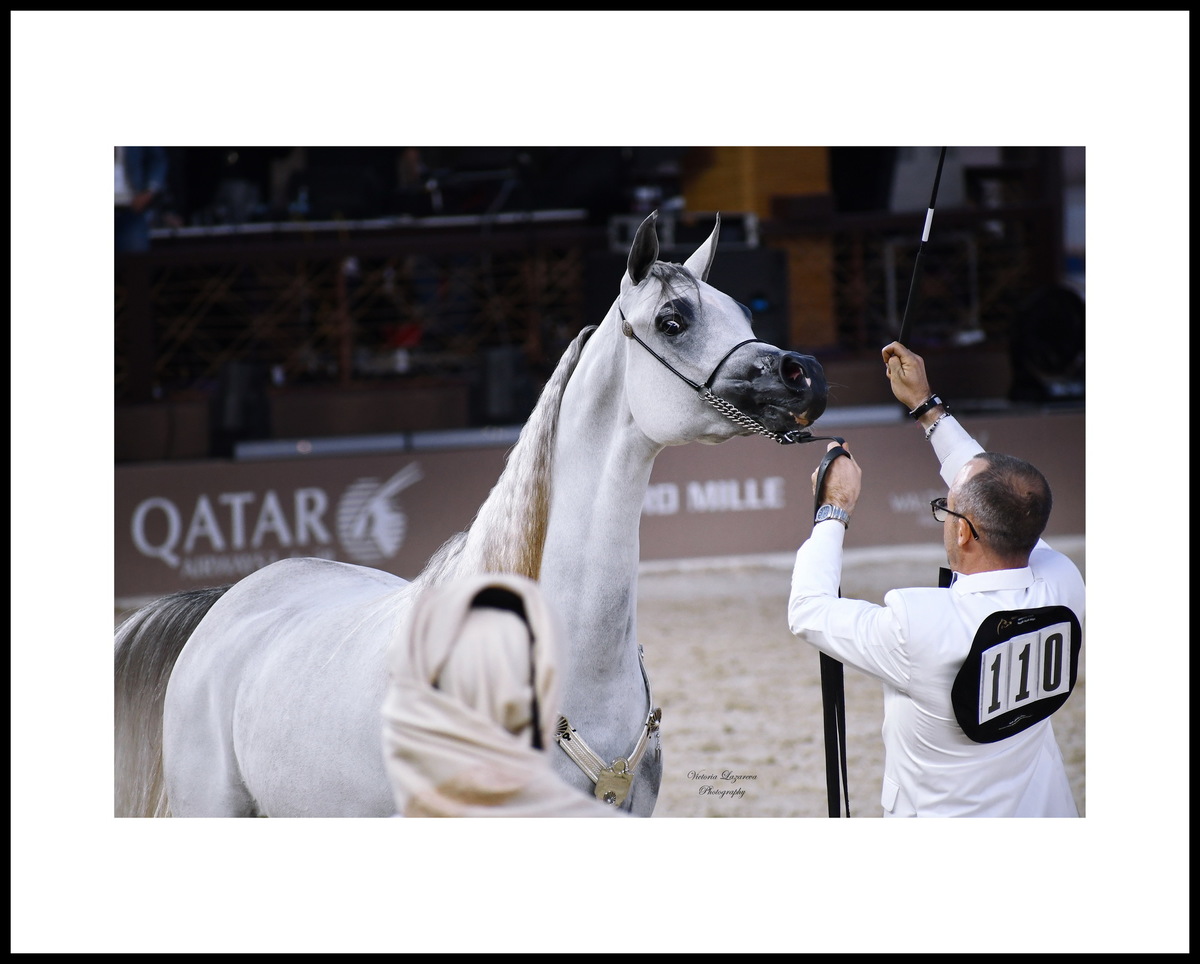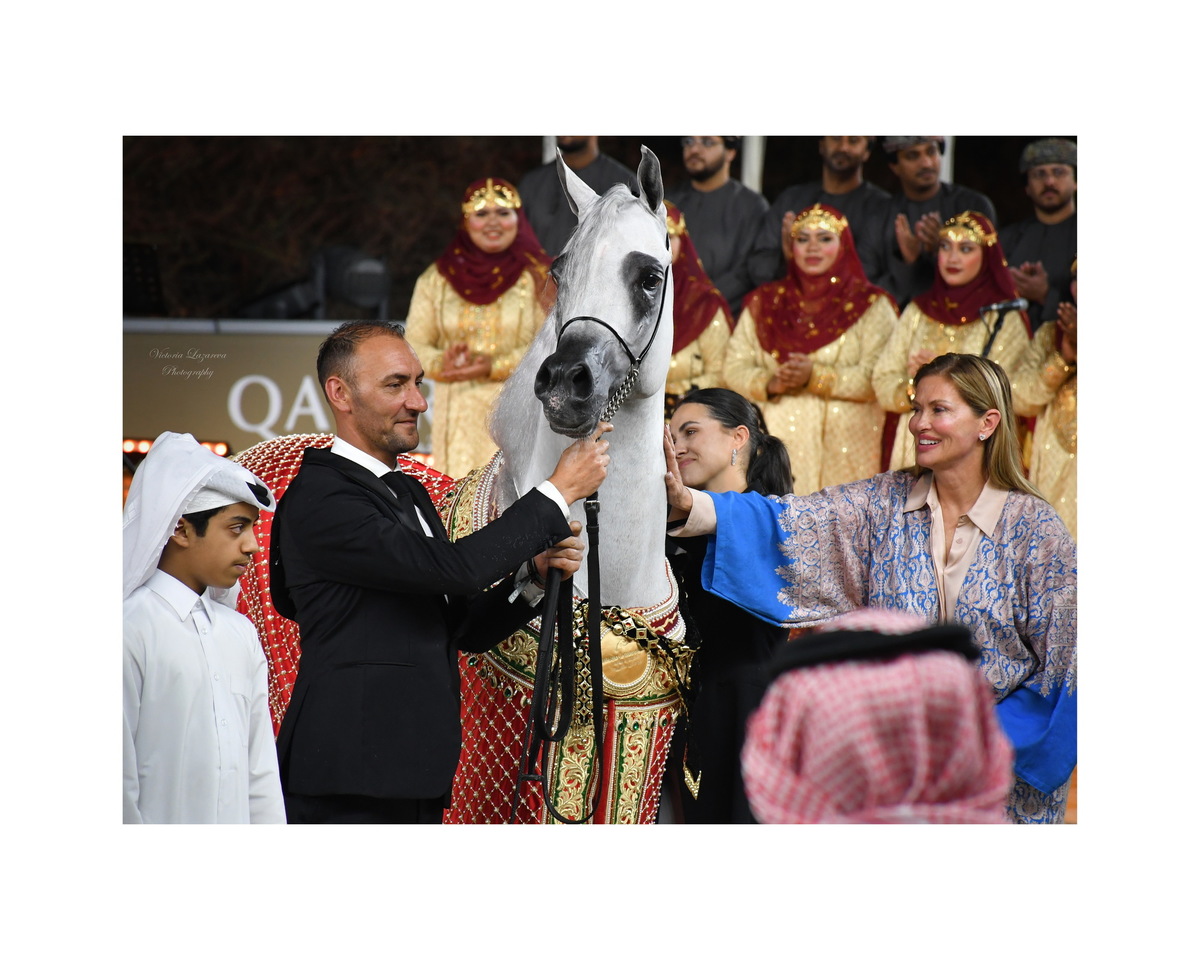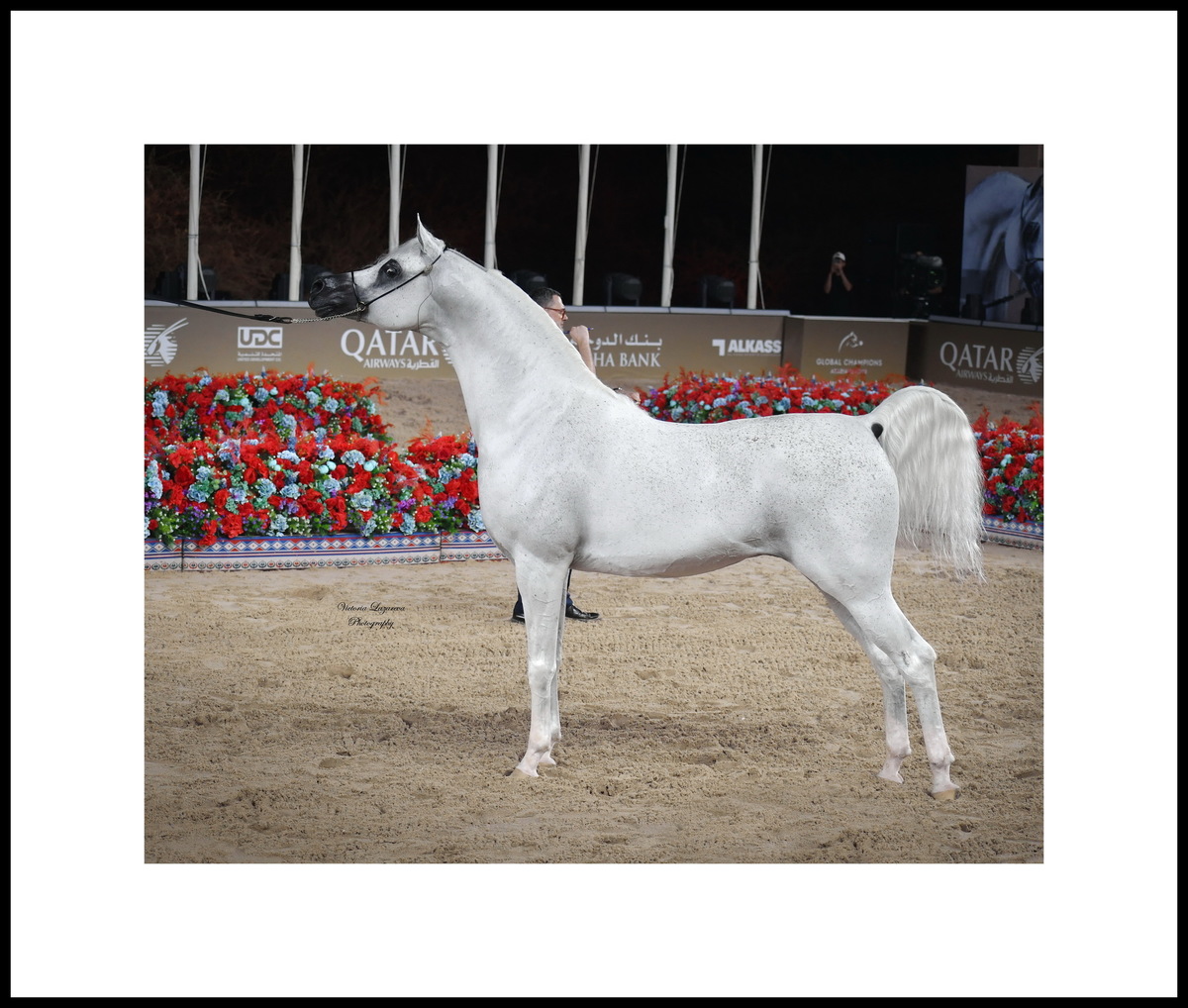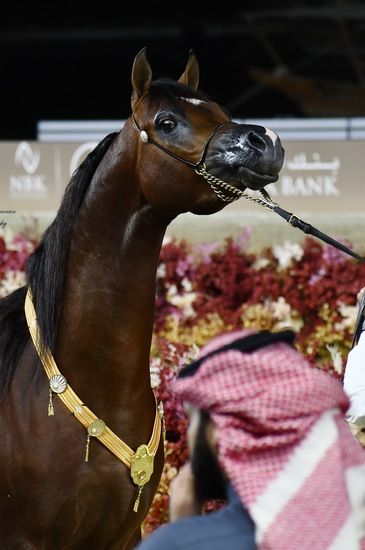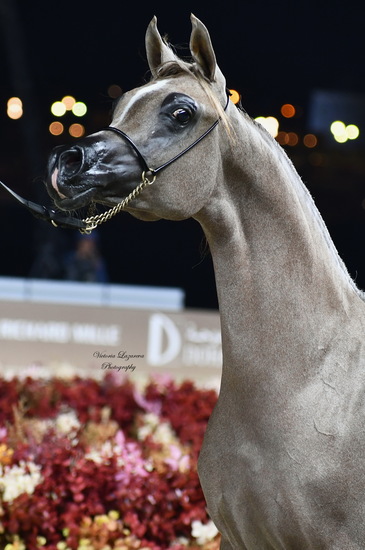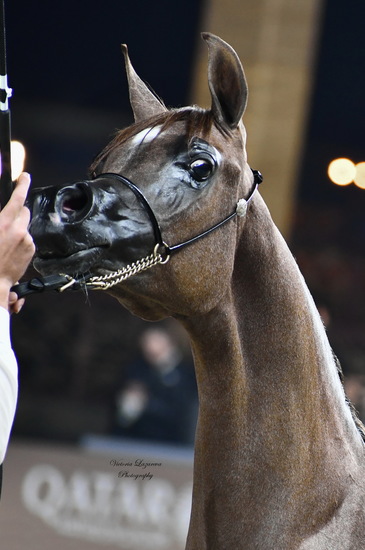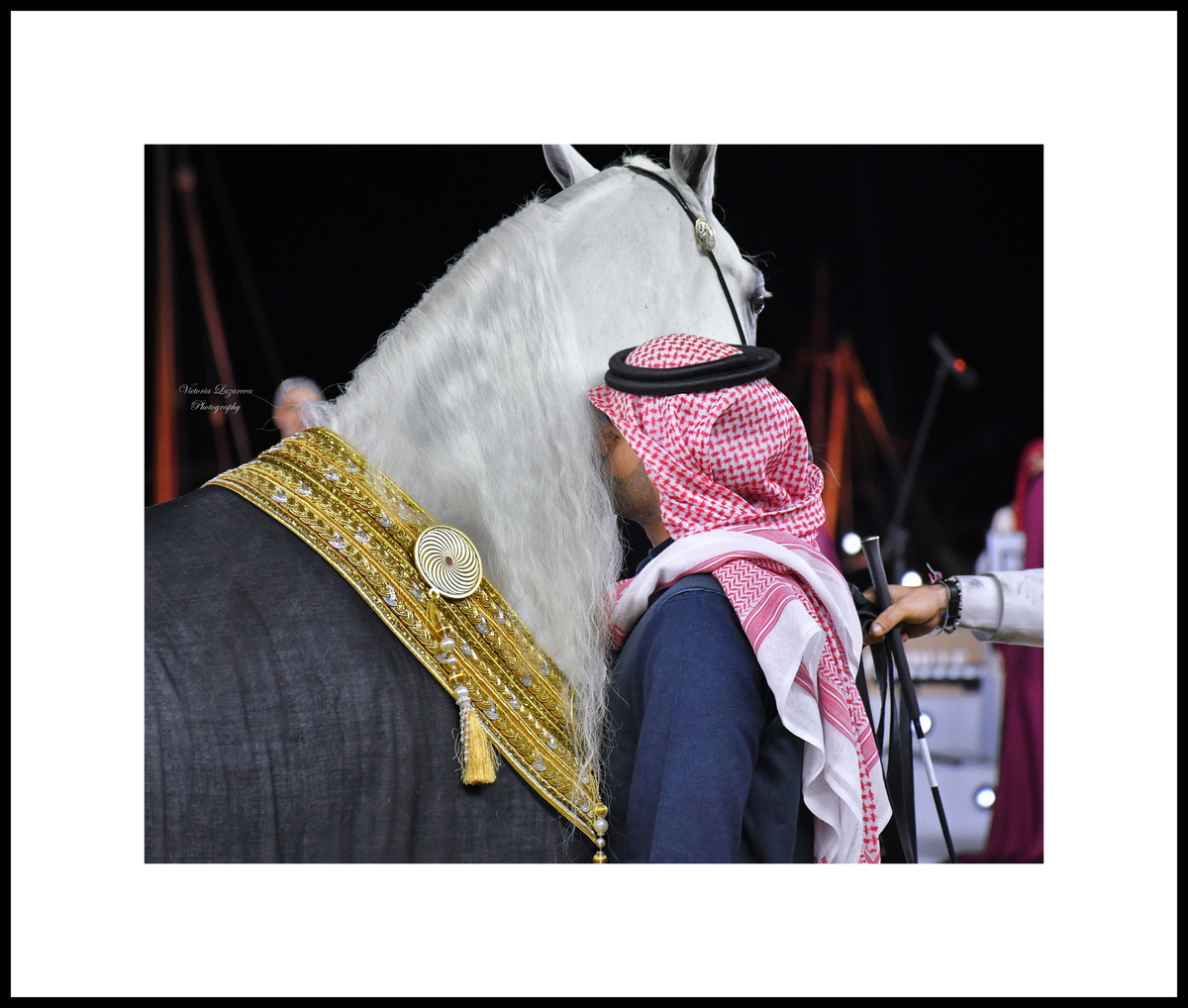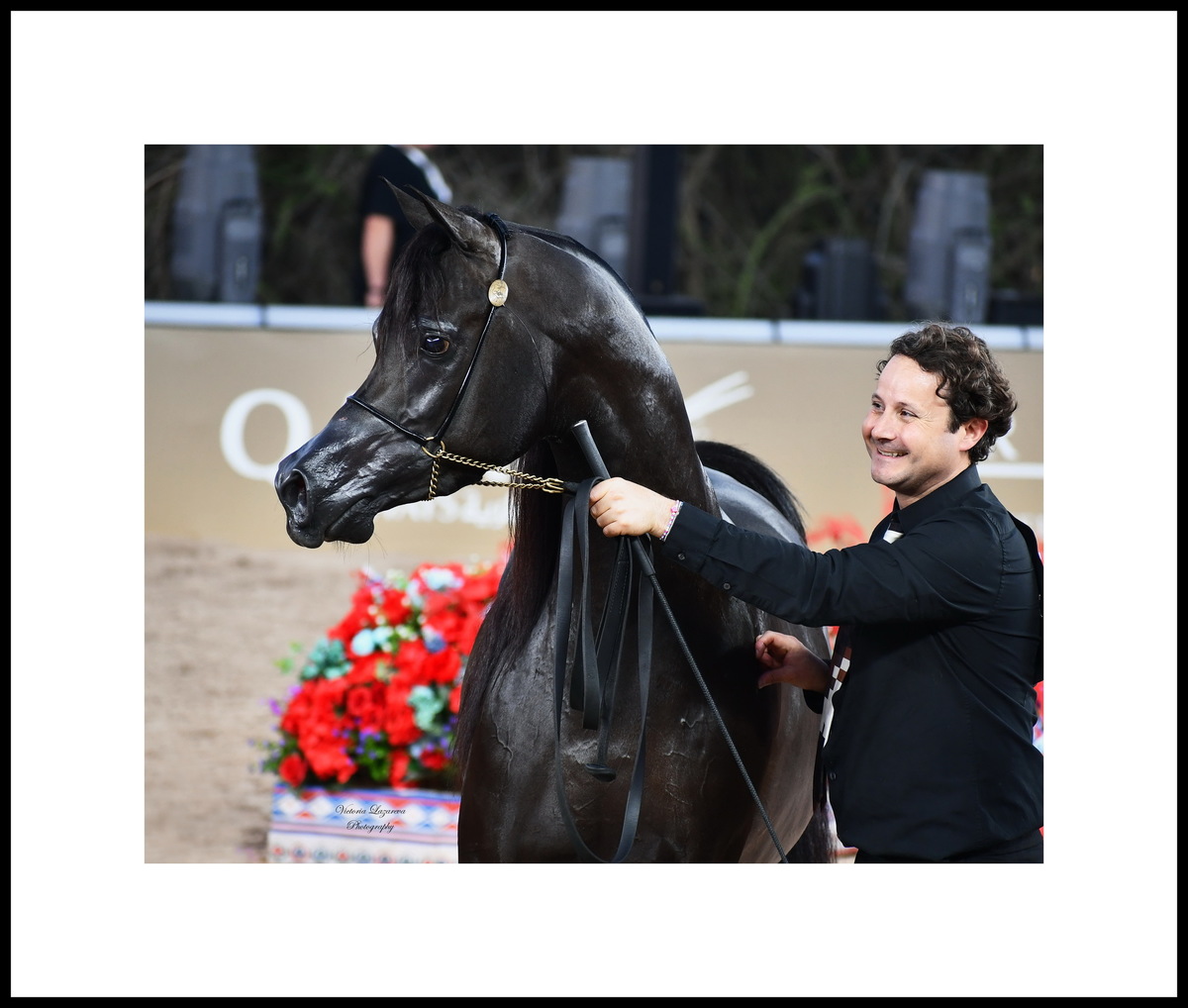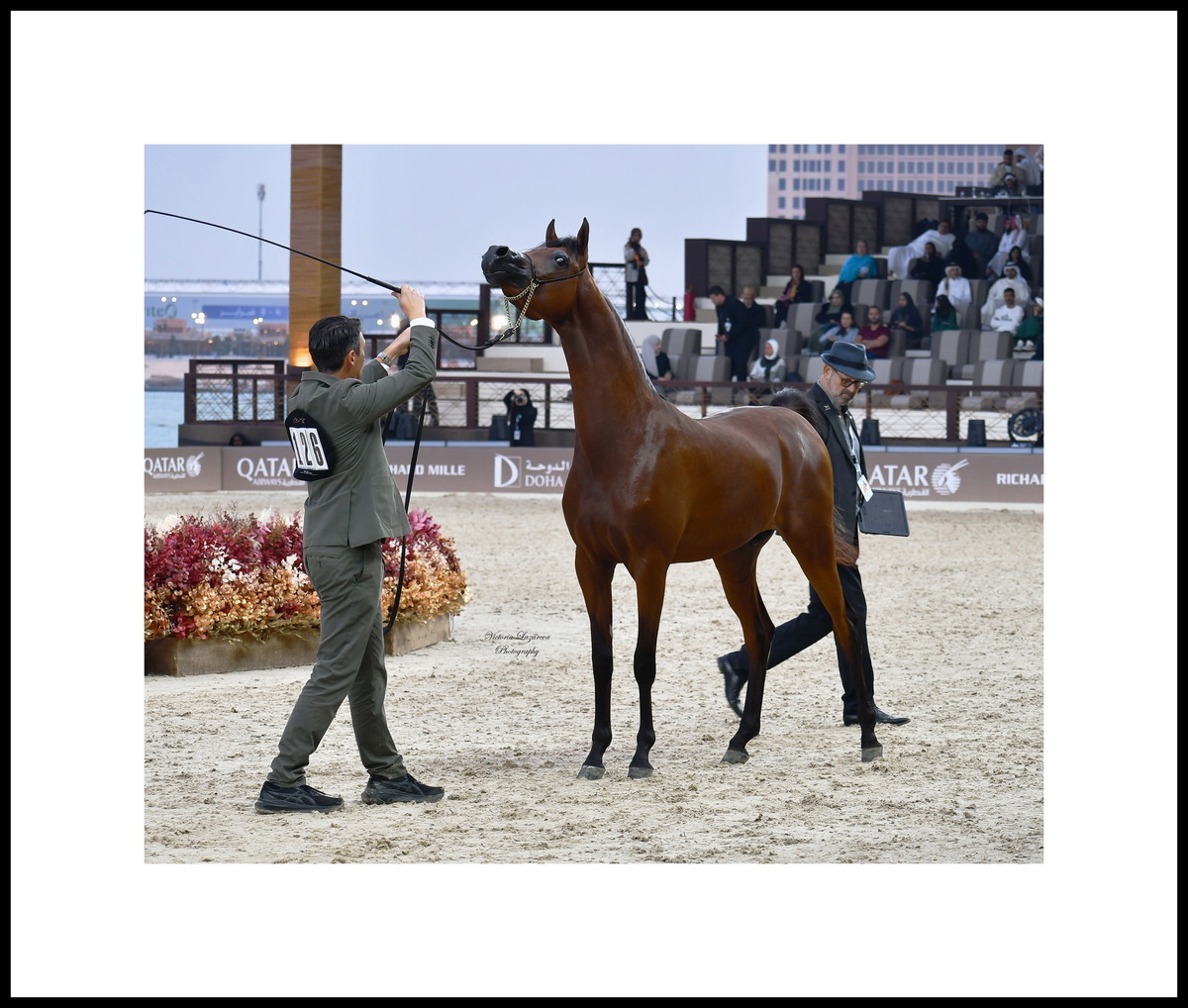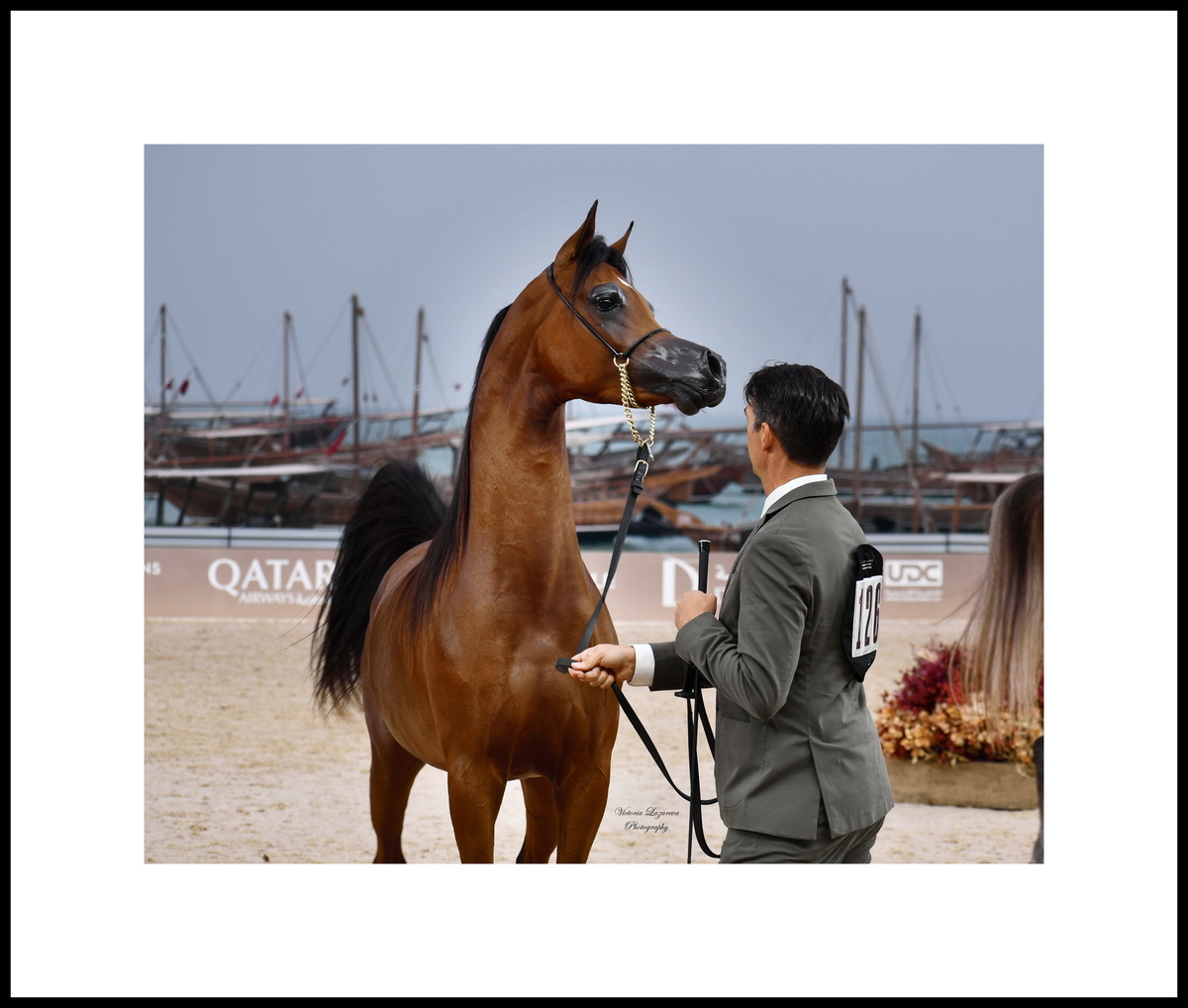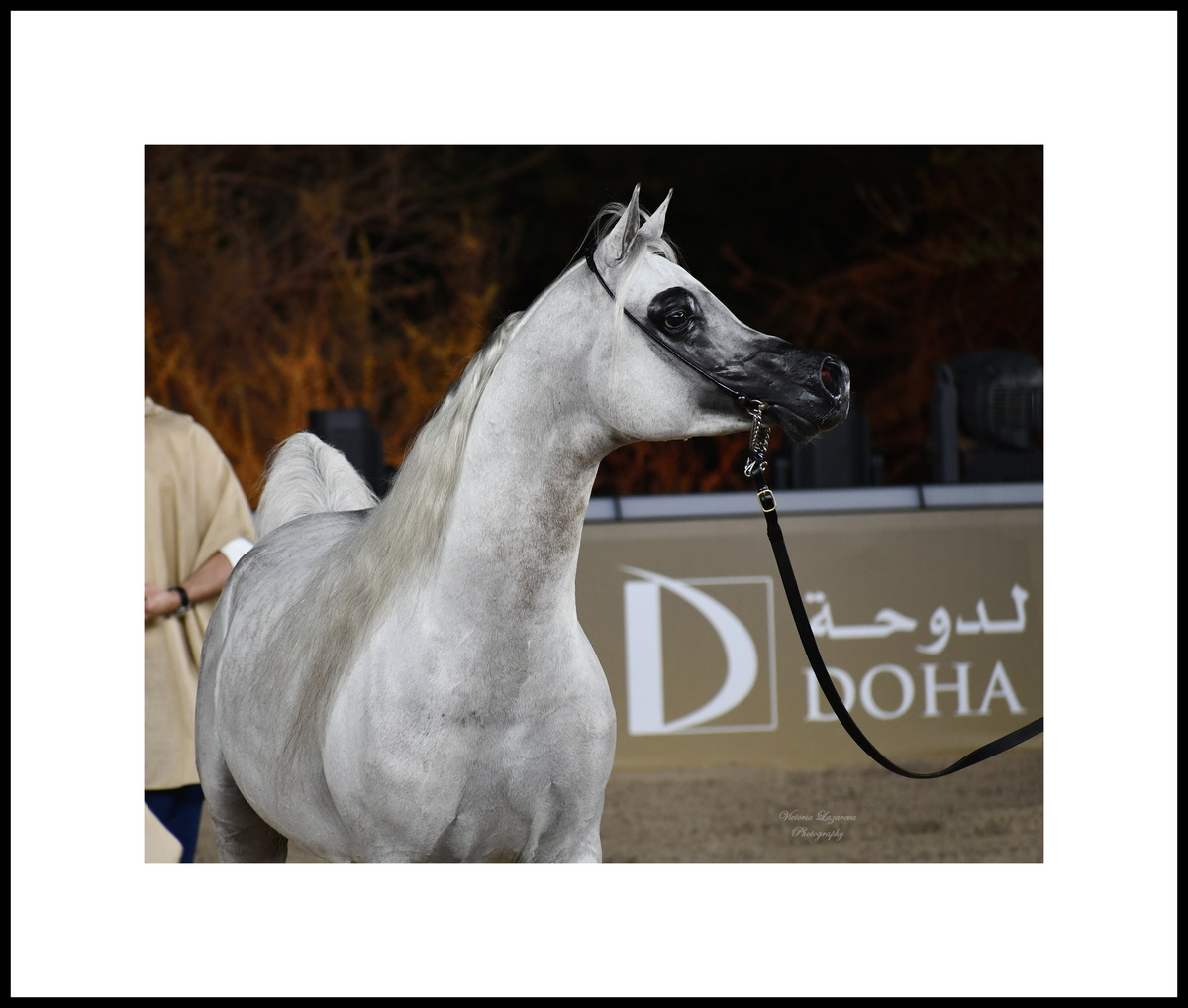2025 GCAT EUROPE AND MIDDLE EAST. ROYAL MEET
It took me a few months to write this article. I wanted to go beyond what's usually written about lavish world shows. Rhinestones and feathers, quadcopters and fireworks, limitless budgets and crazy prize money—all of that is great, of course, but I wanted to focus on something more important: the horses.
So here is what I did: I analysed the 64 champions' pedigrees in details and compiled profiles of their breeders and owners. This recently launched grand world show- The Global Champions Arabians Tour - is already making a powerful mark on the entire Arabian horse industry. So, what exactly is this event? Let's find out together.
GCAT - Global Champions Arabians Tour - is a special series of Arabian horse championships: the sport of halter horse shows; the pinnacle of breed shows.
This elite and beautiful sport is rooted in centuries-old traditions of presenting horses “in hand,” in lightweight tack, to guests or buyers, whether at private stable shows, breed shows, or auctions. Over time, these presentations of horses in lightweight halters have evolved into a highly dynamic and spectacular sport.
The main heroes are a pair: an elegant handler and a fabulously beautiful Arabian horse.
The handler’s task is to reveal the horse's beauty, grace, athletic potential to the spectators and judges in two or three minutes. The horse's task is to obey its handler.
- © Victoria Lazareva, feelingthelife.com
Paolo Capecci & Arabian mare D Shihanah
- © Victoria Lazareva, feelingthelife.com
Glenn Schoukens & Arabian mare Al Aryam Banafsaj
The horse wears an elegant thin halter attached to a long leather lead rope held by the handler. Using this simple tack, the handler demonstrates mastery of controlling the horse at two gaits—the extended trot and the walk — and then brings the horse to a standing position.
At the world show level, horse control in hand reaches such a high level that it becomes a true art. You look into the arena and see a miracle: grace, harmony, floating movements, almost like ballet. But behind all this ease lie years of skill and hundreds of training hours.
- © Victoria Lazareva, feelingthelife.com
Arnauld Mertens & yearling Arabian colt Tashaar Al Shaqab
- © Victoria Lazareva, feelingthelife.com
Giacomo Capacci & Arabian stallion Amaar
The Global Champions Arabians Tour is like the Arabian horse champions' Round-the-World Tour.
Essentially, it's an international series of competitions, moving from one country and city to the next, featuring the world's most beautiful Arabian horses. The list of competition venues and dates is announced before the start of the new Tour season.
The phrase "global (or round-the-world) tour" perfectly captures the concept of the event.
Not only the horse but also its entire entourage, including the owner, breeder, stud manager, trainer, groomer, and media representatives, travels through a pre-approved list of countries and cities.To avoid the participants being overwhelmed by the hassle of transporting horses and preparing them for competition, the GCAT organizers have transformed each stage into a grand celebration, reducing stress and instilling joy.
- © Victoria Lazareva, feelingthelife.com
Each host country highlights its strengths and values, offers a brief historical overview, and connects participants with their unique culture through the most recognizable images.
Participants literally become travellers and explorers, gaining vivid impressions and new insights into the world.

The Global Champions Arabians Tour was first announced at the World Arabian Horse Championship in Doha, Qatar,
in December 07, 2023.KEY AIMS OF THE GLOBAL CHAMPIONS ARABIANS TOUR
• Promote the Arabian horse breed
• Enhance the competition
• Develop the equestrian sport
• Connect people and cultures around the world through a shared passion
• Involve new participants, encourage mutual respect and knowledge sharing
Thus, an aesthetically beautiful sport is complemented by an entertaining, educational, and outreach program.
And, perhaps most importantly, it offers the opportunity to meet hundreds, even thousands, of members of the global Arabian horse community, exchange knowledge, and identify the best achievements in Arabian horse breeding, training, and performance.
- © Victoria Lazareva, feelingthelife.com
- © Victoria Lazareva, feelingthelife.com
Al Shaqab Stud, Dubai Stud, Fujairah International Show and Ajman Stud - General Managers
The organizers envision the entire competition chain taking place in the most beautiful, luxurious, and iconic locations in each country. These include the verdant mangroves of the Al Zorah Nature Reserve in Ajman, United Arab Emirates; the ethno-village of Doha's new fashionable district Katara, with its gigantic amphitheatre and breathtaking views of the Gulf; the five-star Ritz-Carlton Al Bustan Palace Hotel in Oman's capital, surrounded by picturesque mountains and shady palm groves; the famous Croisette promenade in Cannes, France, overlooking the dazzling sea; and many other unforgettable places.
- © Victoria Lazareva, feelingthelife.com
- © Victoria Lazareva, feelingthelife.com
- © Victoria Lazareva, feelingthelife.com
- © Victoria Lazareva, feelingthelife.com
Each championship is accompanied by a vibrant and colourful performance: thousands of quadcopters paint living pictures in the night sky, while fireworks and salutes light up the arena. Military parades march during the opening and closing ceremonies. Children's choirs, adult dance groups, symphony and folk orchestras intertwine to form a singular whole. World-class singers ignite the stands, and Circus du Soleil acts make the heart beat faster—everything is designed to dazzle, surprise, and, most importantly, highlight the unique qualities of the host country and the high significance of the event.
- © Victoria Lazareva, feelingthelife.com
Abu-Dhabi 2024
- © Victoria Lazareva, feelingthelife.com
Doha 2025
- © Victoria Lazareva, feelingthelife.com
Muskat 2025
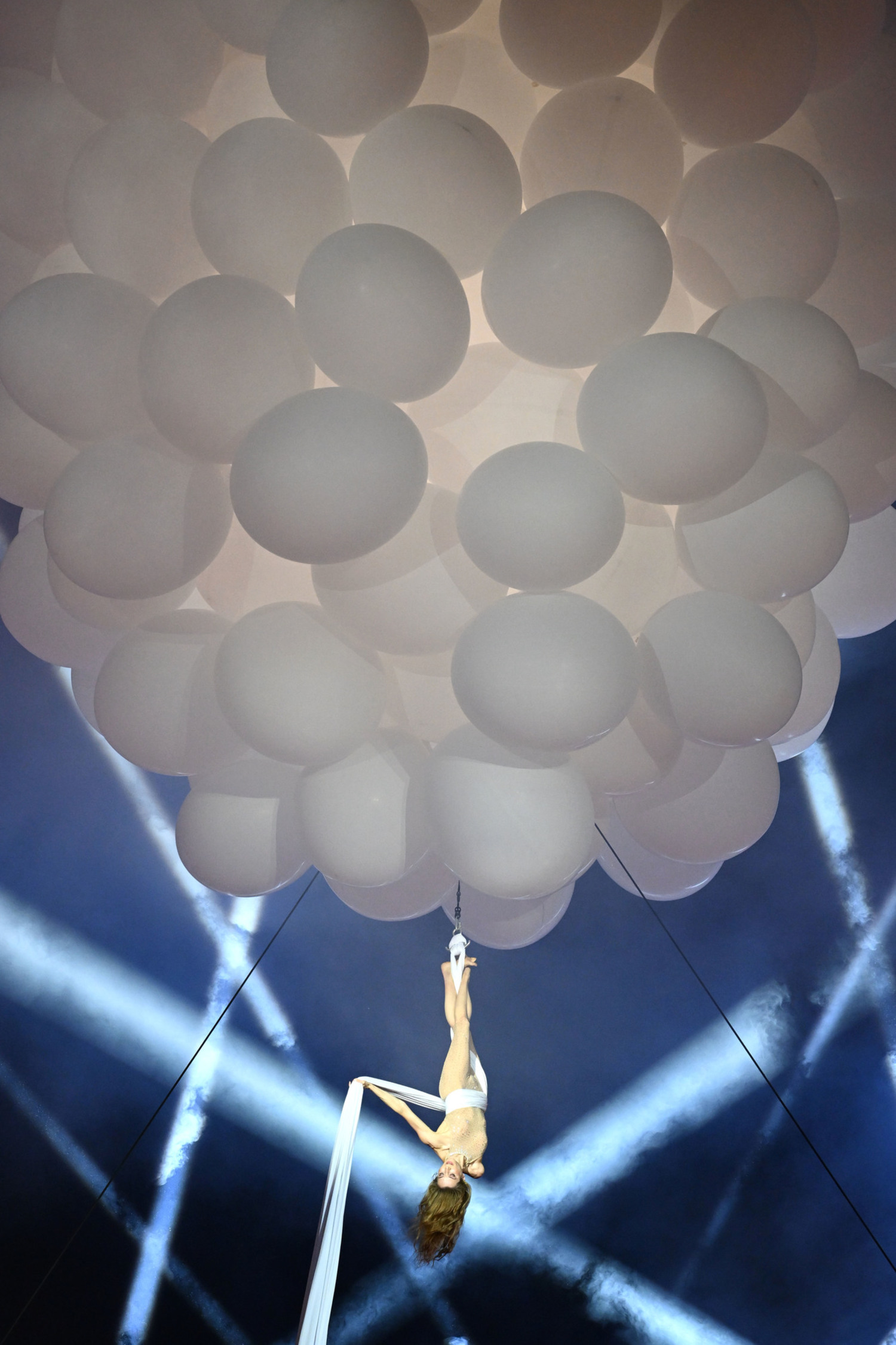

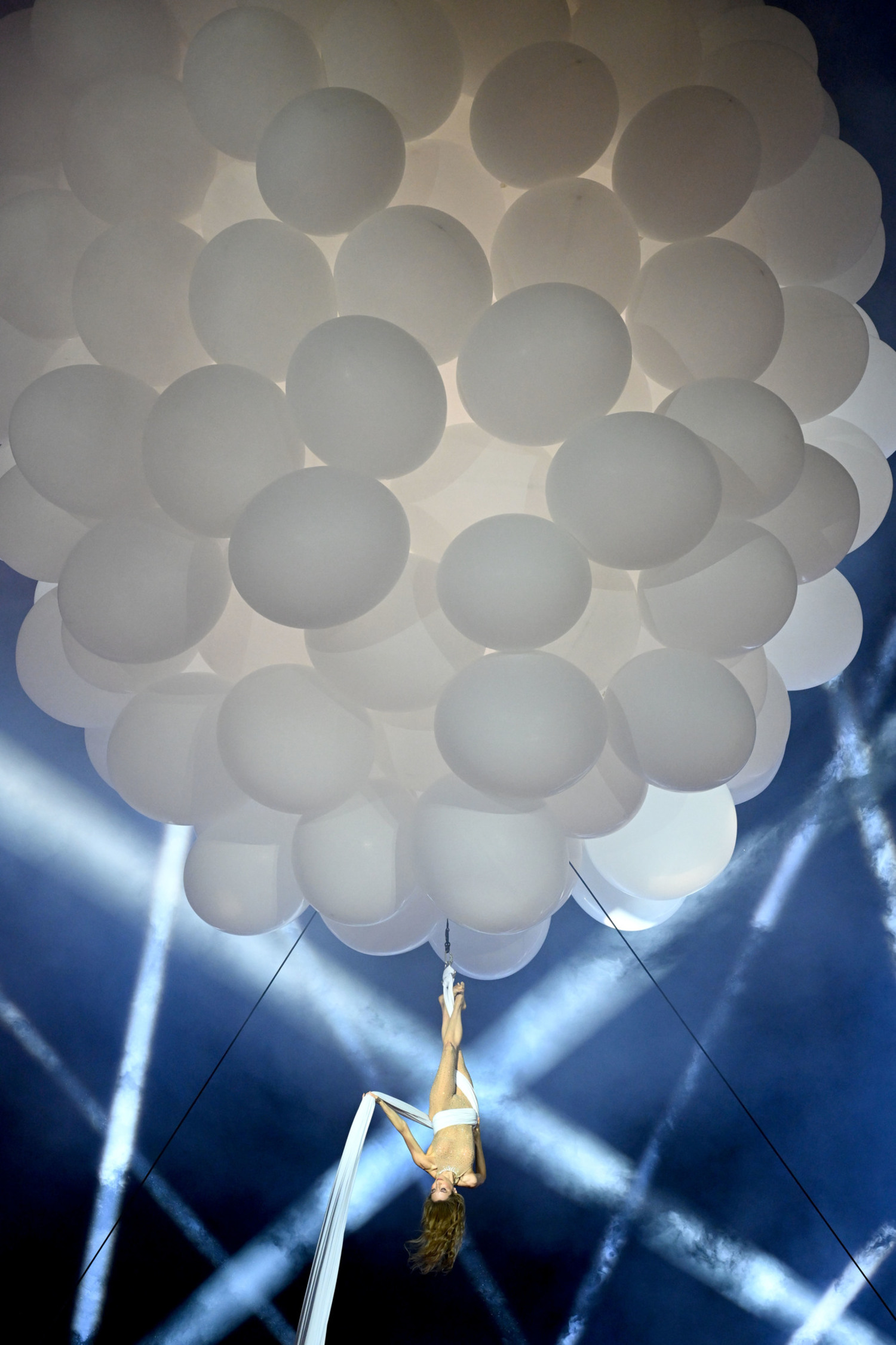
SLOGAN "RESPECTING BEAUTY WITH INTEGRITY"
As a non-native English speaker, I'll try to give my interpretation of this slogan.
The English word "Integrity" [ɪnˈtɛɡrɪtɪ] has several meanings.
The closest translation of "Integrity" in this case is honesty, completeness, and inviolability;
it also means transparency and a consistent display of moral character, even in the face of challenges and temptations.
Integrity also includes responsibility, trustworthiness, and the desire to do what is right, even when no one is watching.
Given these definitions, I understand the slogan "Respecting beauty with integrity" to mean "CONSCIENTIOUS RESPECT FOR BEAUTY".
THE ROUTE WAS BUILT
Starting in 2024, GCAT's geography includes a number of major cities in the Middle East and Europe.
Middle Eastern countries host the GCAT in winter, when the weather is most comfortable. The list of these countries in 2024 and 2025 has not changed:
• Qatar (first held in Doha, February 1-5, 2024; then February 5-8, 2025);
• United Arab Emirates (Abu Dhabi, February 22-25, 2024; Ajman, January 3-6, 2025);
• Saudi Arabia (Riyadh, November 13-16, 2024; April 9-12, 2025);
• Oman (Muscat, 30 March – 1 April 2024; 6-8 March 2025).
European countries host the Global Champions Arabians Tour during the summer time. The list of participating European countries has a little bit changed:
• France (Cannes, June 10-11, 2024; June 13-15, 2025);
• The Netherlands (Valkenswaard, July 20-21, 2024; July 18-20, 2025);
• Italy (Rome, September 3-4, 2024) – did not participate in 2025.
The following countries have been added in 2025:
• The United Kingdom (London, August 14-17, 2025);
• Czech Republic (Prague, September 4-6, 2025).
Starting in 2025, the GCAT Americas tour expanded to include countries in both North and South America. The American part of the tour was held in the following cities:
• Scottsdale, Arizona, United States (February 18 and 20, 2025);
• Miami, Florida, United States (April 17-19, 2025);
• Sao Paulo, Brazil (July 13-14, 2025);
• *Denver, Colorado, United States (August 8-9, 2025);
• Las Vegas, Nevada, United States of America (September 26-28, 2025).
* One of the championships was supposed to be held in Brandon, Canada, but was moved to Denver, USA.
«Horse of the Tour»
- © Victoria Lazareva, feelingthelife.com
Arabian mare AJ Kayya - "Horse of the Tour", GCAT 2024
- © Victoria Lazareva, feelingthelife.com
Junior Arabian filly Shahalel Al Shaqab - "Horse of the Tour", GCAT 2025
QUALIFICATIONS
Only open halter classes will be considered.
Yearlings must be weaned, and they may not be shown under the age of six (6) month.
Horses, except yearlings, should have qualified for the GCAT event as follows:
1. ECAHO affiliated Shows:
1.1. top-5 place at the World Championship, a Title, a GCAT, an A, or a B Show;
1.2. top-3 place at a National Championship, an С International or a European Show;
1.3. the 1st place at a Specific Origin or a С National Show.
2. USA Shows:
2.1. top-5 place at a GCAT Americas show;
2.2. Champion or Reserve Champion or top-10 at the US Nationals;
2.3. Champion or Reserve Champion or the 1st place in class at the Scottsdale Show;
2.4. Champion or Reserve Champion in Regional Shows;
2.5. Champion or Reserve Champion, or 1-3 place in an official National Championship;
2.6. the 1st place at the Arabian Breeders World Cup show.
3. AHO shows:
3.1. Champion or Reserve Champion or the 1st place in class at AHO International shows.
More detailed rules are published on the official GCAT website and in company catalogues:
Home - Global Champions Arabians Tour
- © Victoria Lazareva, feelingthelife.com
- © Victoria Lazareva, feelingthelife.com
BRIEFLY ABOUT THE JUDGING SYSTEM
The judging team at each GCAT Championship consists of 16 people, the majority of whom are international class judges (A, B) from the ECAHO list. In countries that are not members of the ECAHO, judges must be selected by a recognized National Arabian Horse Organization.
Judges on probation are not permitted.
Nine judges must be present in the arena during class judging, and 11 during championship judging.
Horses are judged on a 20-point scale, including half-points.
Evaluation criteria:
1) breed type,
2) head and neck,
3) back (body),
4) legs,
5) movement.
The final score for each horse is calculated by subtracting the highest and lowest scores for each criterion and summing the remaining points.
- © Victoria Lazareva, feelingthelife.com
- © Victoria Lazareva, feelingthelife.com
- © Victoria Lazareva, feelingthelife.com
Arabian mare Nada Al Shahania - Evaluation of the head and neck
- © Victoria Lazareva, feelingthelife.com
Arabian mare Nada Al Shahania - Evaluation of the back
BRIFLY ABOUT CLASSES AND CHAMPIONSHIPS
Before the competition, horses are divided into classes by gender and age:
1. Yearlings (born this year, at least six months old, fully weaned),
2. Juniors (born in the previous two years),
3. Seniors (three years and older).
The top three winners in their class advance to the championship:
1. Yearling Fillies Championship,
2. Yearling Colts Championship,
3. Junior Fillies Championship,
4. Junior Colts Championship,
5. Mares Championship,
6. Stallions Championship.
Judges select three winners in each championship – the Gold, Silver, and Bronze Champions.
In total, there are 18 medal winners (6 Gold, 6 Silver and 6 Bronze champions) based on the results of each GCAT series.
- © Victoria Lazareva, feelingthelife.com
Arabian mare Al Aryam Banafsaj
EACH MONTH
• Qualified Arabian horses for the GCAT Europe and Middle East participate in the Middle East & Europe series.
Eight championships (four in the Middle East, four in Europe) are scheduled for 2025.
• Qualified Arabian horses for the GCAT Americas participate in championships within specified North and South American countries. Five championships are scheduled for 2025.
During the current year of the Global Tour, an Arabian horse
• may compete in all serial competitions
(8 or 5 championships, depending on which part of the Global Tour it was selected for);
• a horse may compete in some of GCAT championships;
• a horse may compete in one of GCAT championships.
* The owner decides how often a horse participates in competitions.
For an Arabian horse to be included in the overall ranking, which is used to calculate the prize money, it must take part in at least 80% of the competitions in its part of the Tour.
Results of the 2025 GCAT Europe and Middle East: 64 champion horses, 144 medals.
Just under a third of all medals (40 of 144; 28%) were won by six champion horses:
• 2 horses have 8 medals out of 8 (16)
• 1 horse has 7 medals out of 8 (7)
• 2 horses have 6 medals out of 8 (12)
• 1 horse has 5 medals out of 8 (5)A third of the medals (49 of 144; 34%) were won by 14 horses:
• 7 horses have 4 medals out of 8 (28)
• 7 horses have 3 medals out of 8 (21)About 40% of the medals were won by 44 horses (55 medals out of 144; 38%):
• 11 horses have 2 medals out of 8 (22)
• 33 horses have 1 medal out of 8 (33)
Eight medals out of eight
- © Victoria Lazareva, feelingthelife.com
Breeder Mindy Peters (USA), handler Glenn Schoukens, the Hleetan stud team & the winner Arabian stallion Berlin MP, QATAR
- © Victoria Lazareva, feelingthelife.com
Glenn Schoukens & stallion Berlin MP, QATAR
- © Victoria Lazareva, feelingthelife.com
Al Shaqab stud manager Khalid Al Jehani, handler Arnauld Mertens & the winner junior Arabian filly Shahalel Al Shaqab, QATAR
- © Victoria Lazareva, feelingthelife.com
Arnauld Mertens & junior filly Shahalel Al Shaqab, QATAR
Seven medals out of eight
- © Victoria Lazareva, feelingthelife.com
Dubai stud managers Mohammed Al Tawhidi and Abdelaziz Al Marzooqi, trainer Paolo Capecci with his wife and the triumphant junior Arabian colt D Borkan, UAE
- © Victoria Lazareva, feelingthelife.com
Junior Arabian colt D Borkan, UAE
Six medals out of eight
- © Victoria Lazareva, feelingthelife.com
Ajman Stud General Manager Khalid bin Ghanem Al Omairi, trainer Glenn Schoukens & Arabian mare Al Aryam Banafsaj, UAE
- © Victoria Lazareva, feelingthelife.com
Arabian mare Al Aryam Banafsaj, UAE
- © Victoria Lazareva, feelingthelife.com
Giacomo Capacci & Arabian yearling colt Sharar Al Manhal, QATAR
- © Victoria Lazareva, feelingthelife.com
Arabian yearling colt Sharar Al Manhal, QATAR
- © Victoria Lazareva, feelingthelife.com
SK Arabians team, the owner of Arabian yearling colt Sharar Al Manhal, QATAR
Five medals out of eight
- © Victoria Lazareva, feelingthelife.com
Al Shaqab stud manager Khalid Al Jehani, the Al Shaqab team and the triumphant Arabian mare D Beisan, QATAR
- © Victoria Lazareva, feelingthelife.com
Arabian mare D Beisan, QATAR
AT THE END OF THE YEAR
In 2024, the pinnacle of the Global Champions Arabians Tour was the World Arabian Horse Championships in Paris, France. Among the other participants were the stars of the 2024 GCAT, including the snow-white mare AJ Kayya of the Ajman Stud, UAE and the silver-white stallion D Seraj of the Dubai Stud, UAE.
In 2025, the World Arabian Horse Championships will be held in Doha, Qatar. This time, only those Arabian horses that have participated in the 2025 GCAT (the GCAT Europe and Middle East and the GCAT Americas) and have won gold, silver, and bronze titles at least once will be eligible to compete in this major global competition.
- © Victoria Lazareva, feelingthelife.com
Glenn Schoukens & Arabian mare AJ Kayya — WAHC 2024, Paris
- © Victoria Lazareva, feelingthelife.com
Arabian stallion D Seraj — WAHC 2024, Paris
GETTING TO THE POINT
At the time of writing, the 2025 GCAT has reached its super final stage. It has completed a remarkable 14-championship run:
1) 4 in the Middle East, 4 in Europe,
2) 6 in the Americas.
It is already known that 124 Arabian horses have been selected for competing in the 2025 World Championship:
• 64 Arabian horses from the GCAT Europe and Middle East;
• 60 Arabian horses from the GCAT Americas.
The World Arabian Horse Championship Supreme, featuring over 100 of the world's best Arabian horses, will take place in Doha, Qatar, from December 5–6, 2025.
It is the grand finale of the Global Champions Arabians Tour (GCAT) and boasts an unprecedented €4.98 million prize fund, the highest in Arabian horse competition history.
Below, we will take a detailed look at the 64 champions from the GCAT Europe and Middle East, selected to the WAHC Supreme 2025.
A separate article will be devoted to the GCAT Americas champions.
List of participants and results can be found here: Results - Global Champions Arabians Tour
- © Victoria Lazareva, feelingthelife.com
Junior Arabian filly Shahalel Al Shaqab - "Horse of the Tour 2025", "The Best Female Horse of the Tour" for the 2025 GCAT Europe & Middle East series
- © Victoria Lazareva, feelingthelife.com
Arabian stallion Berlin MP - "The Best Male Horse of the Tour" for the 2025 GCAT Europe & Middle East series
2025 GCAT
EUROPE AND MIDDLE EAST
64 CHAMPIONS, 144 MEDALS
THE BREEDER’S PROFILE: A DEEPER LOOK
- © Victoria Lazareva, feelingthelife.com
Junior colt D Borkan
The breeding success for the 2025 GCAT Europe and Middle East champions is notably concentrated, emerging from a select group of only 14 countries.
COUNTRIES OF CHAMPION BREEDERS
1. United Arab Emirates – 6 successful breeders: 21 champions, 57 medals
2. Saudi Arabia – 10 successful breeders: 12 champions, 22 medals.
3. Qatar – 7 successful breeders: 11 champions, 26 medals.
4. United States of America – 4 successful breeders: 4 champions, 14 medals.
5. Kuwait – 4 successful breeders: 4 champions, 7 medals.
6. South Africa – 2 successful breeders: 2 champions, 5 medals.
7. Uruguay – 1 successful breeder: 2 champions, 2 medals.
8. Poland – 2 successful breeders: 2 champions, 2 medals.
9. Brazil – 1 successful breeder: 1 champion, 4 medals.
10. Belgium – 1 successful breeder: 1 champion, 1 medal.
11. Germany – 1 successful breeder: 1 champion, 1 medal.
12. Jordan – 1 successful breeder: 1 champion, 1 medal.
13. Oman – 1 successful breeder: 1 champion, 1 medal.
14. Spain – 1 successful breeder: 1 champion, 1 medal.
Totally 42 successful breeders from 14 countries.
The lion's share of champions and medals go to the top three countries — the UAE, Saudi Arabia, and Qatar (23 breeders): a combined 44 champions out of 64 (69%), and a combined 105 medals out of 144 (73%).
Much of this success is concentrated in the Middle East, highlighting its key role in the world of Arabian horse breeding.
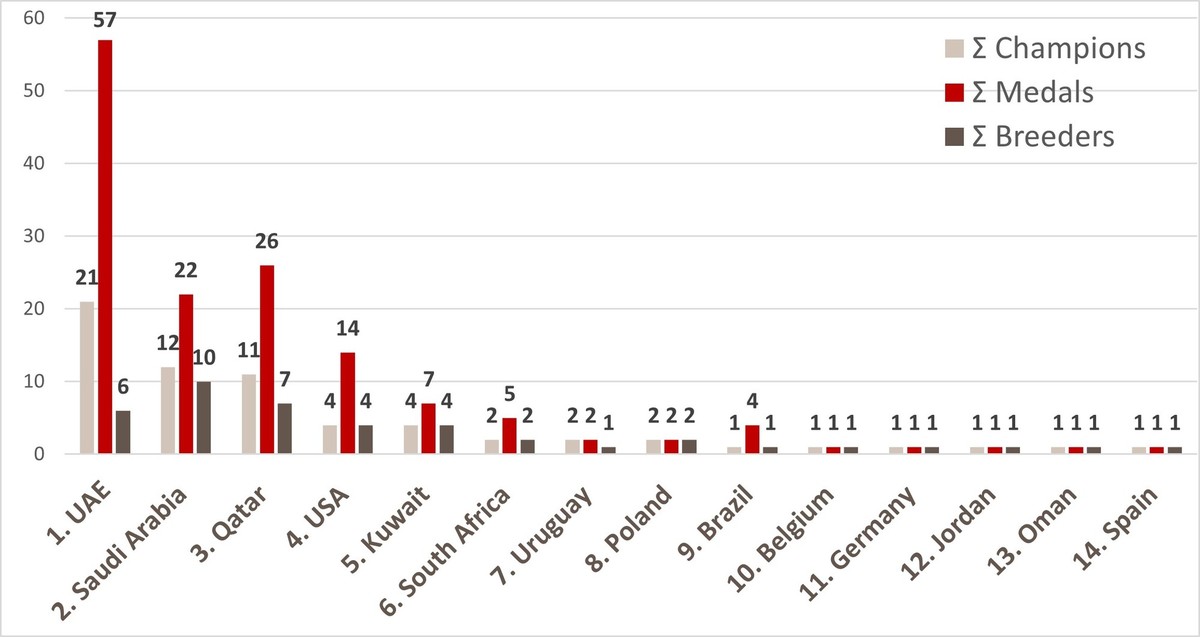 © Victoria Lazareva, feelingthelife.com
© Victoria Lazareva, feelingthelife.com
1. The UAE champion breeders
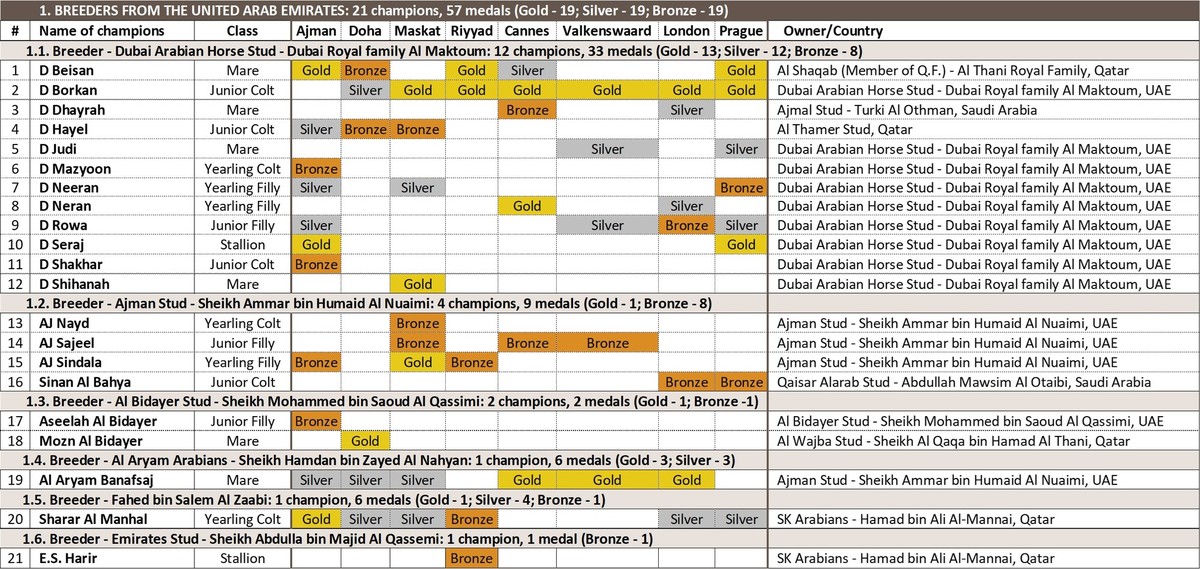 © Victoria Lazareva, feelingthelife.com
© Victoria Lazareva, feelingthelife.com
1. THE UNITED ARAB EMIRATES is by far the leading producer of champion horses.
Notably, the majority of champion horses (20 out of 21) bred in the UAE were born in the "royal stables" owned by members of the UAE's ruling families.
- © Victoria Lazareva, feelingthelife.com
Dubai Stud Team, UAE
♘ DUBAI STUD. Twelve champions were born at the Dubai Stud, owned by the Al Maktoum family, the ruling family of the Emirate of Dubai and led by Sheikh Mohammed bin Rashid Al Maktoum. Horses from the Dubai Arabian horse stud have the world-famous prefix D.
The GCAT Europe and Middle East 2025 saw an all-time record for a single stud farm, with Dubai Stud's 12 champions earning 33 medals (23% of the total, or almost a quarter). No other breeder can come close to these figure.
Among the brightest stars born at the Dubai Stud and shining throughout the Global Tour, the multiple-titled silver-grey mare D Beisan stands out. Now she is the property and jewel of the Qatari Al Shaqab Stud.
D Beisan has won five medals, including three golds – in Ajman, Riyadh, and Prague.
- © Victoria Lazareva, feelingthelife.com
Arabian mare D Beisan
The charismatic junior bay colt D Borkan, a crowd favorite and owned by the Dubai Stud, became the center of heated discussion after winning silver in Doha. Since his time in Oman, D Borkan has won nothing but gold: Muscat, Riyadh, Cannes, Valkenswaard, London, and Prague.
The pearl-white stallion D Seraj, the priceless jewel of the Dubai Stud, also delighted the public with his appearance twice. Taking a part at the start of the Tour in Ajman and in the final in Prague, D Seraj easily took his gold and promised to see him in December in Doha.
It is perhaps worth mentioning two champion yearling fillies with virtually identical names, D Neeran and D Neran, who together brought Dubai Stud five medals.
And, of course, it should be mentioned the titled mare D Shihanah, who took gold in Muscat.
- © Victoria Lazareva, feelingthelife.com
Paolo Capecci and junior Arabian colt D Borkan
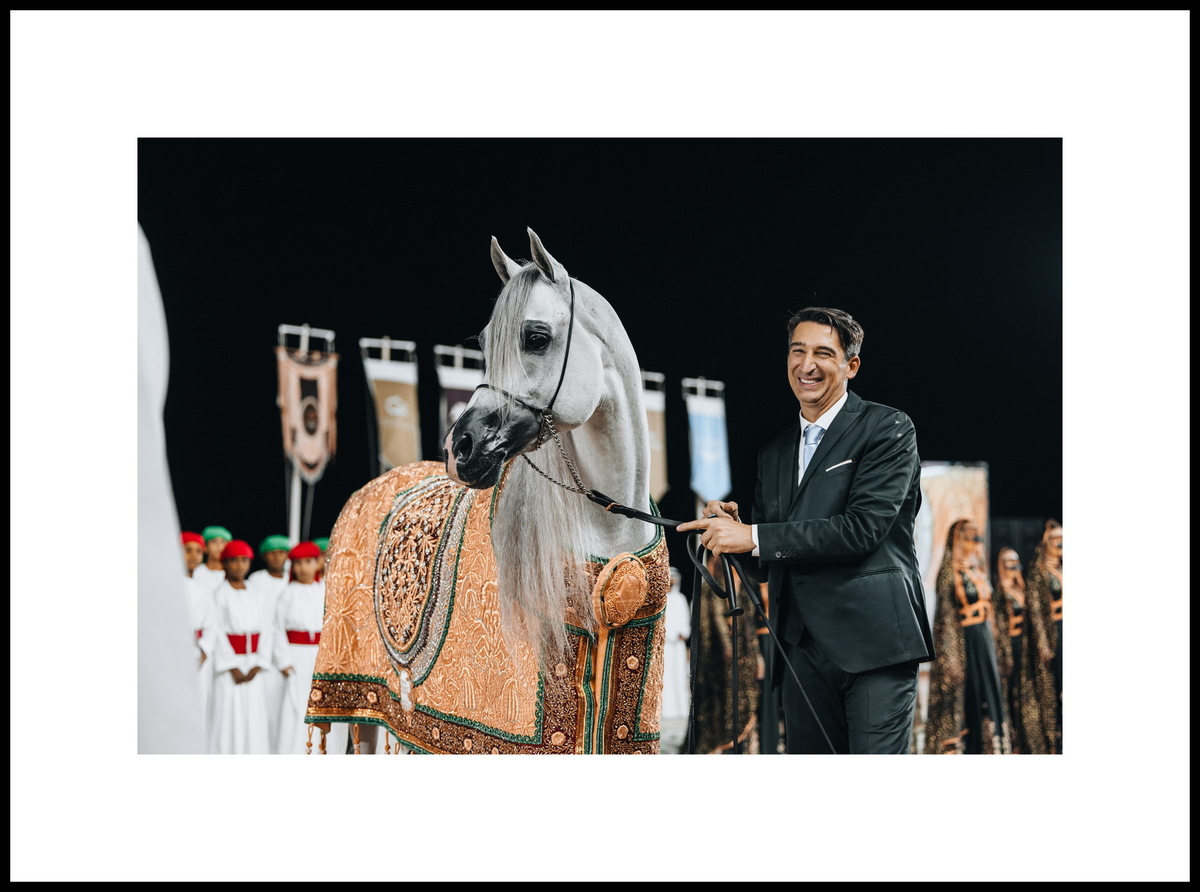 © Victoria Lazareva, feelingthelife.com
© Victoria Lazareva, feelingthelife.comPaolo Capecci and Arabian stallion D Seraj, photo credit by gcarabianstour.com ©
- © Victoria Lazareva, feelingthelife.com
Paolo Capecci & yearling Arabian filly D Neeran
- © Victoria Lazareva, feelingthelife.com
Paolo Capecci & Arabian mare D Shihanah
♘ AJMAN STUD. Four champions were born at the Ajman Stud, owned by Sheikh Ammar bin Humaid Al Nuaimi, the Crown Prince of the Emirate of Ajman. A special story should be devoted to this outstanding stud farm. The Ajman stud horses have the world-famous prefix AJ (also "Al Bahya" and some others).
♘ AL BIDAYER STUD. Two champions were born at the Al Bidayer Stud, owned by Sheikh Mohammed bin Saoud Al Qassimi, a member of Sharjah's ruling family. One is the junior filly Asila Al Bidayer, and the second is the snow-white gorgeous mare Mozn Al Bidayer.
♘ AL ARYAM ARABIANS. One champion - the very beautiful snow-white mare Al Aryam Banafsaj, one of the most titled Arabian mares in the world, was born at the Al Aryam Arabians, owned by Sheikh Hamdan bin Zayed Al Nahyan, a brother of the UAE President and a member of Abu Dhabi's ruling family.
♘ EMIRATES STUD. One champion - the stallion E.S. Harir, having the prestige title Platinum World Champion, was born at the Emirates Stud, which belongs to Sheikh Abdullah bin Majid Al Qassimi, a member of Sharjah's ruling family. The Emirates stud focuses on both flat racing and Arabian show horses.
- © Victoria Lazareva, feelingthelife.com
Arabian mare Mozn Al Bidayer
- © Victoria Lazareva, feelingthelife.com
Tom Oben & junior Arabian colt Sinan Al Bahya
- © Victoria Lazareva, feelingthelife.com
Glenn Schoukens & yearling Arabian filly AJ Sindala
- © Victoria Lazareva, feelingthelife.com
Arabian mare Al Aryam Banafsaj
 © Victoria Lazareva, feelingthelife.com
© Victoria Lazareva, feelingthelife.comTom Oben & Arabian stallion E.S. Harir, photo credit by gcarabianstour.com ©
It should be noted that all the aforementioned UAE stud farms belong to passionate Arabian horse lovers and great enthusiasts of the breed.
They were all at the inception of the Arabian equestrian industry in the Emirates.
And the contribution of each of them to the development of Arabian horse shows in their country and abroad is immense.
♘ AL MANHAL STUD. One champion was born at the Al Manhal Stud in Abu Dhabi, UAE. This stud farm owned by Mr. Fahed bin Salem Al Zaabi. It is unknown whether he is a member of the ruling family, but this gentleman is certainly a noble man and a very talented breeder.
ألف مبروك
- © Victoria Lazareva, feelingthelife.com
Giacomo Capacci and yearling colt Sharar Al Manhal
- © Victoria Lazareva, feelingthelife.com
Giacomo Capacci and yearling colt Sharar Al Manhal
2-3. KINGDOM OF SAUDI ARABIA AND QATAR, as breeding countries, are neck-to-neck running in terms of the number of champions produced: 12 and 11 horses, respectively. However, Qatar edged out Saudi Arabia in the medal count by four, with 26 to Saudi Arabia's 22.
- © Victoria Lazareva, feelingthelife.com
Sheikh Jassim bin Hamad Al Thani (Royal Family of Qatar) and Prince Abdulmajeed bin Sultan Al Saud (Royal Family of Saudi Arabia)
2. Saudi Arabia Champion Breeders
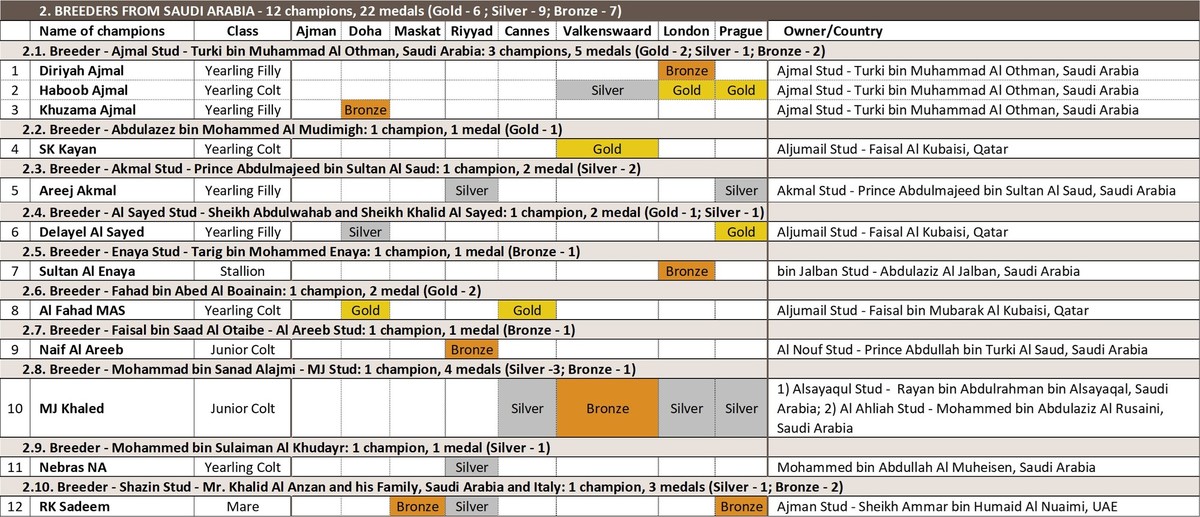 © Victoria Lazareva, feelingthelife.com
© Victoria Lazareva, feelingthelife.com
- © Victoria Lazareva, feelingthelife.com
Philippe Hossay & yearling Arabian filly Khuzama Ajmal
2. From SAUDI ARABIA, ten different breeders contributing to the medal tally at the GCAT Middle East and Europe.
♘ AKMAL STUD. One champion, the yearling filly Areej Akmal, a two-time silver medalist in Riyadh and Prague, was born at the Akmal Stud, owned by Prince Abdulmajeed bin Sultan Al Saud, a young and talented breeder from the kingdom's ruling family.
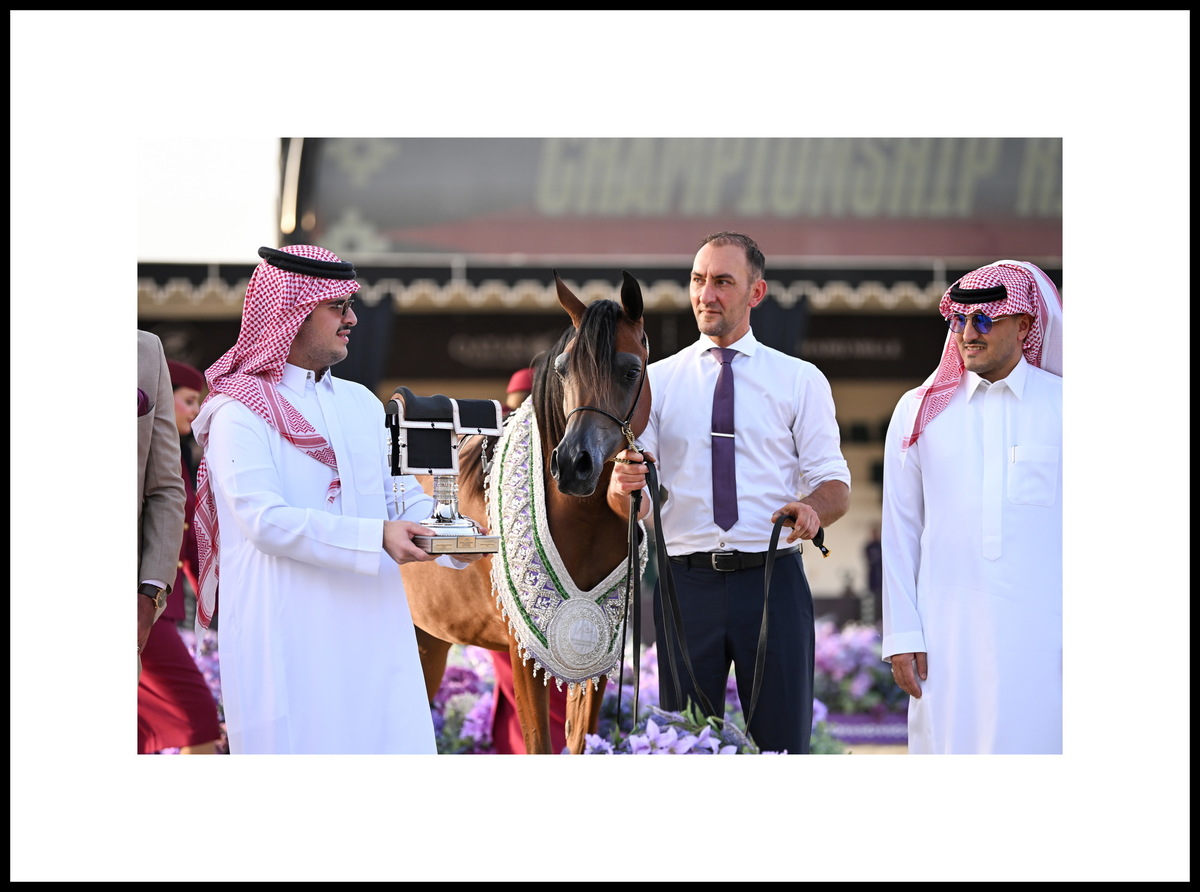 © Victoria Lazareva, feelingthelife.com
© Victoria Lazareva, feelingthelife.comPrince Abdulmajeed bin Sultan Al Saud alongside the manager of Akmal Stud Fahad Alghofaily, trainer Glenn Schoukens and the triumphant yearling filly Areej Akmal. Photo credit by gcarabianstour.com ©
♘ AJMAL STUD. Mr. Turki Al Othman's Al Ajmal stud topped the Saudi standings with three champions and five medals, including two golds. He is the breeder of two yearling fillies, Diriyah Ajmal (bronze medal in London) and Khuzama Ajmal (bronze medal in Doha), as well as two-time gold champion (London, Prague) and silver champion (Valkenswaard) - yearling colt Haboob Ajmal.
♘ AL SAYED STUD. One champion, the yearling filly Delayel Al Sayed, who took silver in Doha and gold in Prague, was born at the renowned Al Sayed Stud, owned by Sheikh Abdulwahab and Sheikh Khalid Al Sayed.
- © Victoria Lazareva, feelingthelife.com
Yearling filly Delayel Al Sayed, photo credit by gcarabianstour.com ©
 © Victoria Lazareva, feelingthelife.com
© Victoria Lazareva, feelingthelife.comYearling filly Haboob Ajmal, photo credit by gcarabianstour.com ©
The remaining seven Saudi breeders each produced one champion. Their names in the table are listed alphabetically. However, in the text descriptions, it makes sense to list the breeders with the most medals and gold medals first.
♘ Mohammad bin Sanad Al Ajmi, MJ Stud - breeder of junior colt MJ Khaled, 4 medals (Silver- 3; Bronze- 1).
♘ Shazin Stud, Khalid Al Anzan and Family - breeder of mare RK Sadeem, 3 medals (Silver- 1; Bronze- 2).
♘ Fahad bin Abed Al Boainain - breeder of yearling colt Al Fahad MAS, 2 medals (Gold- 2).
♘ Abdulazez bin Mohammd Al Mudimigh - breeder of yearling colt SK Kayan, 1 medal (Gold).
♘ Mohammed bin Sulaiman Al Khudayr - breeder of yearling colt Nebras NA, 1 medal (Silver).
♘ Faisal bin Saad Al Otaibe, Al Areeb Stud - breeder of junior colt Naif Al Areeb, 1 medal (Bronze).
♘ Tarig bin Mohammed Enaya, Enaya Stud - breeder of stallion Sultan Al Enaya, 1 medal (Bronze).
- © Victoria Lazareva, feelingthelife.com
Glenn Schoukens & Arabian mare RK Sadeem
- © Victoria Lazareva, feelingthelife.com
Miles Buckley & yearling colt Al Fahad MAS
3. Qatar Champion Breeders
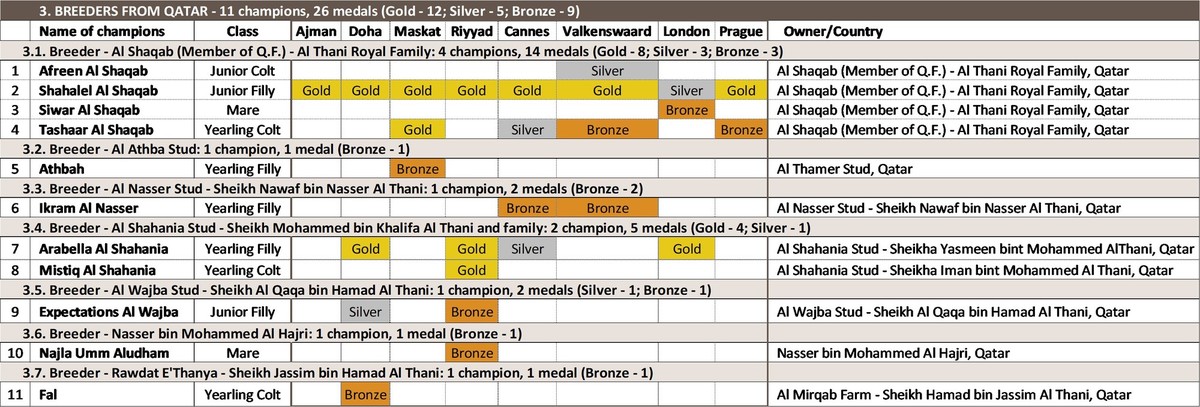 © Victoria Lazareva, feelingthelife.com
© Victoria Lazareva, feelingthelife.com
3. QATAR - Seven Qatari breeders have produced eleven champions.
Most of breeders are members of Qatar's ruling family, the Al Thani.
♘ AL SHAQAB STUD. Al Shaqab tops the list of successful Qatari breeders, producing four GCAT Europe and Middle East champions with 14 medals, including eight gold.
As one of the world's largest stud farms, Al Shaqab was founded in 1992 by the Emir of Qatar, Sheikh Hamad bin Khalifa Al Thani. In 2004, Al Shaqab joined the Qatar Foundation (QF).
Al Shaqab has gifted the world with many outstanding horses of the century, including Gazal Al Shaqab, Marwan Al Shaqab, Hariri Al Shaqab, Kahil Al Shaqab, along with many other stars.
This season, the GCAT Europe and Middle East bore witness to the breathtaking ascent of the junior bay filly, Shahalel Al Shaqab. Sweeping the tour with a full set of medals — eight in total, seven of them gold — she left an indelible mark on the competition.
Al Shaqab is a very successful breeder, second only to Dubai Stud in the number of champion horses they have produced. While Al Shaqab and Ajman Stud each produced four champions, Al Shaqab won more medals overall.
- © Victoria Lazareva, feelingthelife.com
Sheikh Joaan bin Hamad Al Thani alongside trainer Arnauld Mertens and the triumphant Shahalel Al Shaqab
- © Victoria Lazareva, feelingthelife.com
Al Shaqab Team and the triumphant Shahalel Al Shaqab
- © Victoria Lazareva, feelingthelife.com
Al Shaqab stud manager Khalid Al Jehani and the triumphant Shahalel Al Shaqab
In fact, as a breeder, Al Shaqab is only surpassed by Dubai Stud when it comes to total medals, including gold:
• Dubai Stud (UAE): 12 champions, 33 medals (13 gold)
• Al Shaqab Stud (Qatar): 4 champions, 14 medals (8 gold)
- © Victoria Lazareva, feelingthelife.com
Junior filly Shahalel Al Shaqab - "Horse of the Tour 2025", "The Best Female Horse of the Tour" for the 2025 GCAT Europe & Middle East series
♘ AL NASSER STUD. One champion (the yearling chestnut filly Ikram Al Nasser, with two bronze medals of the Tour) was born at the Al Nasser Stud, owned by Sheikh Nawaf bin Nasser Al Thani. The Al Nasser Stud is known for its successful breeding program, particularly of straight Egyptian Arabians, as well as International lines. Sheikh Nawaf is one of the leading breeders who has revived the traditions of the Arabian breed in the Gulf. Over the years, the Al Nasser Stud has produced numerous champions and winners, significantly contributing to the reputation of Arabian horses in Qatar and beyond.
♘ RAWDAT E'TANIYA STUD. This stud farm is owned by Sheikh Jassim bin Hamad Al Thani, the brother of Qatar's Emir. Sheikh Jassim is a prominent Qatari royal, banker, and businessman.
Sheikh Jassim bin Hamad Al Thani is a driving force behind international Arabian horse shows and is known for his impressive collection of Arabian horses, including the legendary Baanderos, a symbol of Peace and Unity.
This season, one of the Rawdat E'taniya's horses, the bay yearling colt Fal, won a bronze medal at the GCAT in Doha.
- © Victoria Lazareva, feelingthelife.com
Giacomo Capacci and yearling Arabian colt Fal
♘ AL SHAHANIA STUD. Two champions of the Tour were born there. The Al Shahania stud is a leading Arabian horse racing operation globally, with a long history of breeding and racing Group 1 winners, including multiple Amir's Sword champions. Also, the Al Shahania Stud is a successful member of Arabian horse show industry.
Founded in the early 1980s, by Sheikh Mohammed Bin Khalifa Al Thani and remains a family-owned operation. Sheikh's young daughters support his passion and love for horses: Sheikha Yasmeen bin Mohammed Al Thani bred the very beautiful yearling filly Arabella Al Shahania (won 4 medals of the Tour - 3 golds,1 silver),
Sheikha Iman bin Mohammed Al Thani bred the yearling grey colt Mistiq Al Shahania (won a gold medal in Riyyad).
♘ AL WAJBA STUD. One champion (the junior grey filly Expectations Al Wajba, with two medals — silver and bronze of the Tour) was born at the Al Wajba Stud, owned by Sheikh Al Qaqa bin Hamad Al Thani.
Sheikh Al Qaqa is a member of Qatar's ruling family, a son of the former Qatar's Emir Sheikh Hamad bin Khalifa Al Thani, and the half-brother of the current Qatar's Emir.
- © Victoria Lazareva, feelingthelife.com
Raphael Curti & junior filly Expectations Alwajba
There are two more Qatari breeders of the GCAT champions:
♘ UMM ALUDHAM STUD. One champion, the beautiful snow-white mare Najla Umm Aludham was born there. The breeder and owner: Mr. Nasser Mohammed Mesfer Al Hajri.
♘ AL ATBA STUD. The stud farm of the same name is located in Saudi Arabia and is owned by a member of the royal family, Prince Abdulaziz bin Ahmed bin Abdulaziz Al Saud. This stud specializes in breeding the Saudi Desert Breed horse.
Probably, the show catalogue lists the Qatar branch of that stud farm, which is owned by Sheikh Al Zubair bin Mohammed Al Thani and Sheikh Meshal bin Eissa Al Thani.
Their only champion, the yearling filly Atbah, is of great interest. We'll discuss her pedigree a little later. Remember her name.
- © Victoria Lazareva, feelingthelife.com
Yearling Arabian filly Athbah
4. The USA Champion Breeders
 © Victoria Lazareva, feelingthelife.com
© Victoria Lazareva, feelingthelife.com
4. UNITED STATES OF AMERICA – there are four the US breeders of 2025 GCAT Europe and Middle East champions. All American breeders are represented by private farms.
♘ MP ARABIANS. One champion, but the special one, – “Best Male Horse of the 2025 GCAT Europe and Middle East” – the snow-white stallion Berlin MP has amassed a full collection of eight medals (two gold – Muscat and Valkenswaard, four silver – Riyadh, Cannes, London, Prague, and two bronze – Ajman and Doha). Before heading overseas and conquering the Middle East, Berlin MP became a star in his home country, the United States. In 2022, he won gold at the International Championship in Scottsdale.
Berlin MP was foaled in 2018 at the private stud farm "MP Arabians" in Arizona, USA. His breeder, experienced horse owner Mrs. Mindy Peters (the initials became the prefix for her horses' names - MP), has bred over 150 Arabian horses in her lifetime. After several years working in the Santa Ynez Valley, she rented a farm in Cave Creek, Arizona.
- © Victoria Lazareva, feelingthelife.com
Arabian stallion Berlin MP
♘ BUTLER FARMS TRAINING CENTER. One champion, but what a champion! – the brightest star and crowd favourite, the snow-white stallion Alexxanderr, was bred in 2014 through the joint efforts of Mrs. Frances Butler and Mrs. Brandi Carson.
Frances Butler and her husband, C.A. Butler, own the private stud farm Butler Farms in White Oak, North Carolina, USA. The couple also owns the Butler Farms training centre (co-owned by Ted Carlson, Ted Carlson Arabians). Butler Farms has evolved over time into a world-class breeding, training, and marketing centre. It is associated with the names of its breeding partners: Francis Butler and Brandi Carson.
- © Victoria Lazareva, feelingthelife.com
Raphael Curti & Arabian stallion Alexxanderr
♘ ALGHAZALI ARABIANS. One champion, the junior filly Sedra Al Ghazali, who took bronze in Prague, was foaled at the private stud farm of Mr. Baraa Alghazali. The Alghazali Arabians Stud is located in California, USA. Sedra Al Ghazali won a gold medal at the 2024 International Championship in Scottsdale, USA, and, after several owners, crossed the ocean and landed in the caring hands of Mrs. Neila Hayek, owner of the renowned Hanaya stud farm in Switzerland.
♘ SHELLBIRD INC. One champion, the junior filly Vivia SB, was bred on the private stud farm of Mrs. Michelle Pfeifer (the name sounds similar to the famous Hollywood actress, but she is a different person). Michelle Pfeifer is the owner of Shellbird Inc, which operates Rising Hearts Ranch near Aspen, Colorado, USA. The company specializes in breeding world-class Arabian horses. Michelle Pfeifer began breeding Arabian horses in 1978 and has been actively involved in various equestrian sports since then; she acquired the ranch in 1999.
5. Kuwait Champion Breeders
 © Victoria Lazareva, feelingthelife.com
© Victoria Lazareva, feelingthelife.com
5. KUWAIT is another Arabian Peninsula country in the list of champion breeders. Kuwait has four private breeders, each with one champion.
♘ ABHAA ARABIANS. One champion – the yearling colt AB Razeen, who won a bronze medal in London, was born at the Abhaa Arabians Stud, founded in 2012 by Mr. Ahmad Abdulaziz Al Babtain in Wafra, Kuwait. The Abhaa Arabians focused on Straight Egyptian bloodlines, but also has a breeding program for international lines.
♘ AL ADWANI STUD. One champion – the stallion Harbi Al Adwan, who won a bronze medal in Valkenswaard, was born in Al Adwani Stud, owned by Mr. Adwan Al Adwani. The breeding locations are based in both Kuwait and Belgium. The stallion Harbi Al Adwan was Bronze Champion Senior Stallion at the 2021 World Championship in Paris and has earned other titles in Europe.
♘ AL JUMAN STUD. One champion, but "oh my god, he’s so perfect' – Amaar! The snow-white stallion, a shining star of the GCAT was born at the Al Juman Stud. This stud was founded in 2012 by two friends, Mr. Jasim Al Mesbah and Mr. Mohammad Al-Awadhi. Breeding philosophy: “Set high standards from the beginning, focusing on acquiring top Arabian horses from around the world”.
♘ AL SAQRAN STUD. One champion – the yearling filly SQ Ghandoura, an Ajman gold medalist, was born in the Al Saqran Stud, owned by Mr. Bassam Al Saqran. The Al Saqran stud has multiple farms in Kuwait, Dubai, and Scottsdale (USA), allowing them to compete on two continents.
- © Victoria Lazareva, feelingthelife.com
Arabian stallion Amaar
6. South Africa Champion Breeders
 © Victoria Lazareva, feelingthelife.com
© Victoria Lazareva, feelingthelife.com
6. SOUTH AFRICAN breeders are represented by two stud farms, each with one champion.
♘ AL AMAL ARABIANS. One champion, the junior colt Azzam Al Amal, who won gold in Ajman, silver in Muscat, and bronze in Cannes, was born at the Al Amal Arabians stud farm in South Africa, founded by Mr. Bilal Bassiouni. The Arabesque Arabians stud farm was a partner breeder. The colt, Azzam Al Amal, the bronze World Champion Arabian Horse in Paris in 2024, is owned by Sheikh Mohammed bin Saud Al Qasimi, Al Bidayer Stud Farm, Sharjah, UAE.
♘. ELKASUN ARABIAN HORSE STUD. One champion stallion, EKS Sirajj, winner of the silver medal at Valkenswaard and bronze medal at Cannes, was born at the private stud Elkasun Arabian, located in the Franschhoek wine region of the Western Cape, South Africa. The stud was founded in 1998 by Willie Brown and his wife, Lisa. The Browns focus on breeding "for purpose," producing a "complete horse" with correct conformation, excellent movement, and a usable disposition. Initially, the breeding program was based primarily on American lines, but was later expanded and supplemented by Spanish, Egyptian, and Polish lines. Elkasun Arabians has produced world champion horses, including EKS Farajj and EKS Alihandro.
In 2022, Elkasun Arabian moved to a new, state-of-the-art 30-hectare farm.
7. Uruguay Champion Breeders
 © Victoria Lazareva, feelingthelife.com
© Victoria Lazareva, feelingthelife.com
7. URUGUAY is represented by one special breeder with two champions.
♘. LAS ROSAS ESTANCIA S.R.L. Two champions were born at the La Rosas Estancia: the Gold Champion of Doha, the junior colt LR Anselmo, and the Bronze Champion of Valkenswaard, the mare LR Altagracia. The La Rosas Estancia is a large, multi-profile farm in Uruguay owned by Princess Laetitia d’Arenberg, a member of European nobility. Princess Laetitia acquired the farm in 1973. The farm occupies 3,500 hectares of land and, in addition to purebred Arabian horses, breeds various livestock and cultivates crops. But it was the Arabian horses that brought her farm worldwide fame.
Princess Laetitia d’Arenberg turned her passion for Arabian horse breeding into a serious enterprise in 2004, although she had owned Arabian horses before. She owns the famous stallion Excalibur EA and uses him in her Arabian horse stud breeding program.
8. Poland Champion Breeders
 © Victoria Lazareva, feelingthelife.com
© Victoria Lazareva, feelingthelife.com
8. POLAND is represented by two breeders, each with one champion.
♘ SK MICHALOW (MICHAŁÓW STATE STUD). One champion, the mare El Esmera, winner of the Ajman bronze medal, was born at the Michałów State Stud, one of Poland's most prestigious and largest Arabian horse breeding facilities. SK Michałów was founded in 1953. It is a state-owned stud that operates as a subsidiary of the National Agricultural Support Centre. The stud has played a key role in refining the special "Pure Polish" Arabian horse, known for its beauty, courage, and impressive endurance.
SK Michałów has a herd of over 400 Arabian horses, including around 120 exceptional broodmares. Michałów-bred horses have won numerous championships and fetched top prices at prestigious auctions like the "Pride of Poland". Besides Arabians, the stud also has other horse breeds and maintains herds of dairy cattle.
♘ LUBOCHNIA ARABIANS. One champion, the yearling filly Dalia L., winner of the silver medal at Valkenswaard, was born at the family stud farm Lubochnia Arabians. The stud was established in Poland in 2021 by Dobrochna Perz-Wawrzyńczyk and Przemysław Wawrzyńczyk. Though a new entrant to the breeding scene, Lubochnia has quickly gained international recognition by acquiring horses from top global bloodlines and farms.
The stud's strategy and meticulous planning have yielded impressive results. In its early years, it quickly produced several international champions, including medallists at the prestigious All Nations Cup in Aachen.
9-14. Other Champion Breeders — Brazil, Jordan, Spain, Germany, Oman, Belgium
 © Victoria Lazareva, feelingthelife.com
© Victoria Lazareva, feelingthelife.com
9. BRAZIL is represented by one breeder with one champion who won four medals.
♘ HARAS VILA DOS PINHEIROS - AGROPECUARIA VILA DOS PINHEIROS. One champion, the junior filly Shahbrys HVP, who won four medals, including gold in London, was born in Brazil.
Agropecuária Vila dos Pinheiros is the company's main name, encompassing all aspects of agribusiness (cattle breeding, agriculture, and livestock farming).
Haras Vila dos Pinheiros (HVP) is the name of the company's elite division, dedicated to breeding Arabian horses.
A key figure associated with this business for decades was the late José Carlos Boumlai, a prominent figure in Brazilian agribusiness and politics. The company's operations remain within a family or corporate structure.
Agropecuária Vila dos Pinheiros has corporate offices in São Paulo (Avenida Paulista) and operates extensive farms in the Brazilian states of: São Paulo, near the city of Indaiatuba; Mato Grosso do Sul, in the region of Nova Andradina.
- © Victoria Lazareva, feelingthelife.com
Philippe Hossay & junior Arabian filly Shahbrys HVP
10. JORDAN is represented by one breeder with one champion.
♘ FEDERICO JOSE MORALES. One champion, the yearling colt FAM Vortex, won a silver medal in Ajman. This colt was bred by Mr. Federico José Morales.
Federico José Morales, a Jordanian Arabian horse breeder with connections in the United Arab Emirates, breeds Arabian horses under the F.A.M. Arabians prefix and actively participates in international shows. He is also active in Brazil, where he has the Morales Arabians stud farm.
11. SPAIN is represented by one breeder with one champion.
♘ GANADERIA YEGUADA BAUTISTA VICH STUD. One champion, the yearling filly Veronica BV, who won the Valkenswaard gold medal, was born at the Ganadería Yeguada Bautista Vich S.L., often referred to as Bautista Vich Stud (hence the BV prefix for their horses). This renowned horse breeding farm located in Inca, Mallorca, Spain.
The Bautista Vich Stud specializes in breeding both Purebred Spanish Horses (P.R.E. or Andalusians) and Arabian horses. It was established in 1991 by brothers Guillermo and Pedro Bautista Vich.
12. GERMANY is represented by one breeder with one champion.
♘ MELANIE MALORNY. One champion, the yearling colt BV Chazan, who won bronze in Cannes, was bred by German Arabian horse breeder Melanie Malorny, who works with Blue Valley Arabians (hence the BV prefix at the beginning of the horse's name).
Melanie Malorny has been actively breeding Arabian horses for many years, both independently and with her family. In addition to breeding horses, Malorny runs a related company, Malorny International Horsetransports, which handles international horse transportation.
13. OMAN is represented by one breeder with one champion.
♘ ROYAL CAVALRY OF OMAN. One champion, the stallion Shareem RC, who won a bronze medal in Muskat, was born in the Royal Cavalry of Oman.
This is the Sultanate of Oman's official organization, created to preserve and develop the country's equestrian traditions. It maintains a large herd of horses, primarily Arabian breeds, and its activities include racing, cultural events, and competing in international competitions.
The Royal Cavalry is owned by the state of Oman. It was founded in 1974 by the former ruler, the late Sultan Qaboos bin Said, with an initial herd of 20 horses to revive Oman's rich equestrian heritage. Under Sultan Qaboos, the Omani Cavalry increased its herd of purebred Arabian horses to nearly a thousand, becoming "the largest mounted army in the world."
14. BELGIUM is represented by one breeder with one champion.
♘ SWAENEPOEL ARABIAN HORSE STUD. One champion, the junior colt Chalino CJ, who won a silver medal in Riyyad, was born at the Swaenepoel Arabian Horse Stud.
This is a family Arabian horse stud in Belgium, run by Christel and James Swaenepoel, hence the prefix CJ to the name of their horses – C(hristel) and J(ames). The couple has been breeding Arabian horses for over 20 years and has produced multiple international champions.
♘ A horse breeder plays a more fundamental and significant role than the owner. That's why we began our analysis with champion breeders.
A breeder is a creator. They are responsible for the horse's genetics, for the correct pairing, for its birth and the first hours, months, and years of life. The breeder lays the foundation for a champion's potential.♞ A horse owner is more of an investor and manager. They decide whether to own a horse. Whether to keep or sell it: how useful the horse is for a breeding program or a show career. The owner provides resources, the best trainers, and the conditions necessary to realize the horse's inherent potential. Of course, this is also a rather complex and responsible task.
You can buy or lease a ready-made star and become the owner of a champion, but without the breeder's foresight and diligence, that star simply wouldn't exist. That's why these Arabian horse studs farms are highly respected that manage to both breed and own a champion. This achievement is challenging because it involves managing both the genetics and the development of the horse.
Champions of the 2025 GCAT Middle East and Europe are owned by individuals and studs from a select group of just 10 countries.
COUNTRIES OF CHAMPION OWNERS
1. Qatar – 10 successful owners: 26 champions, 67 medals.
2. United Arab Emirates – 4 successful owners: 18 champions, 45 medals.
3. Saudi Arabia – 7 successful owners: 11 champions, 22 medals.
4. Switzerland – 1 successful owner: 3 champions, 4 medals.
5. Jordan – 1 successful owner: 1 champion, 1 medal.
6. Kuwait – 1 successful owner: 1 champion, 1 medal.
7. Libya – 1 successful owner: 1 champion, 1 medal.
8. Oman – 1 successful owner: 1 champion, 1 medal.
9. Palestine – 1 successful owner: 1 champion, 1 medal.
10. Poland – 1 successful owner: 1 champion, 1 medal.
A total of 28 successful owners from 10 countries.
And again, the lion's share of champions and medals goes to the top three countries - Qatar, the UAE and Saudi Arabia: a total of 55 champions out of 64 (86%), a total of 134 medals out of 144 (93%).
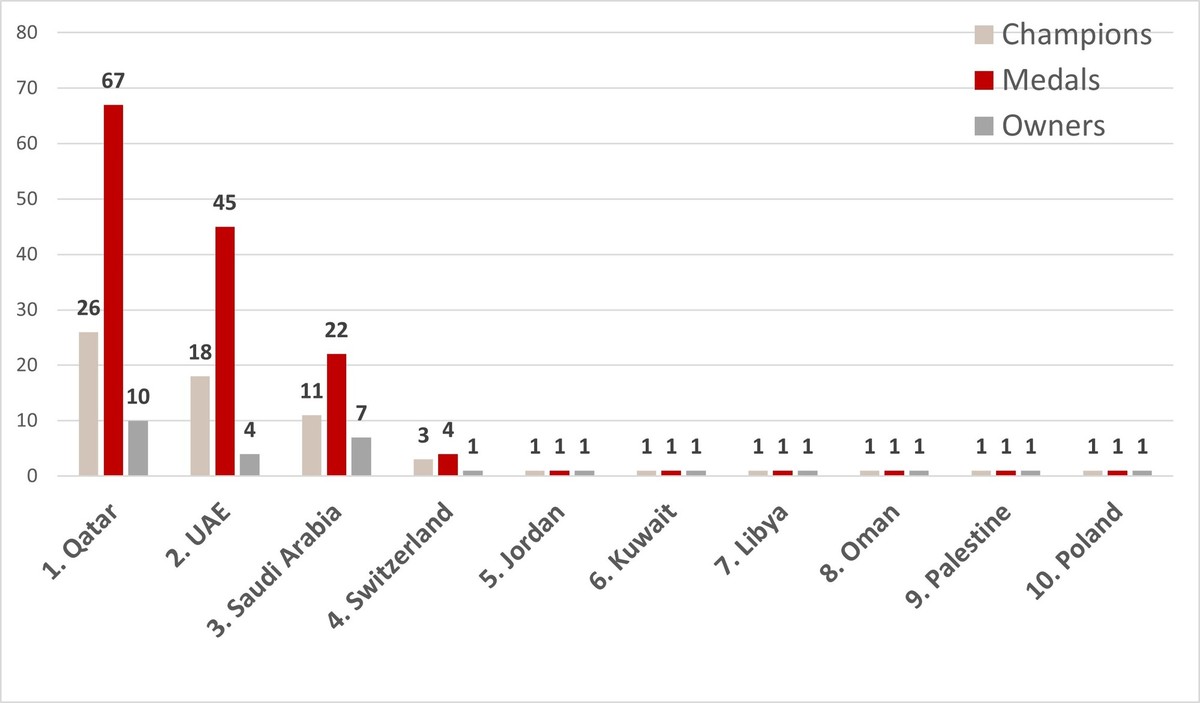 © Victoria Lazareva, feelingthelife.com
© Victoria Lazareva, feelingthelife.com
The Big Three: Over 80% of the 2025 GCAT Europe and Middle East champions are owned in Qatar, the UAE, and Saudi Arabia.
Champions: 55 out of 64 (86%)
Medals: 134 out of 144 (93%)The ownership of these champions paints a clear and concise picture, highlighting the dominance of a few key regions.
1. Qatar Champion Owners
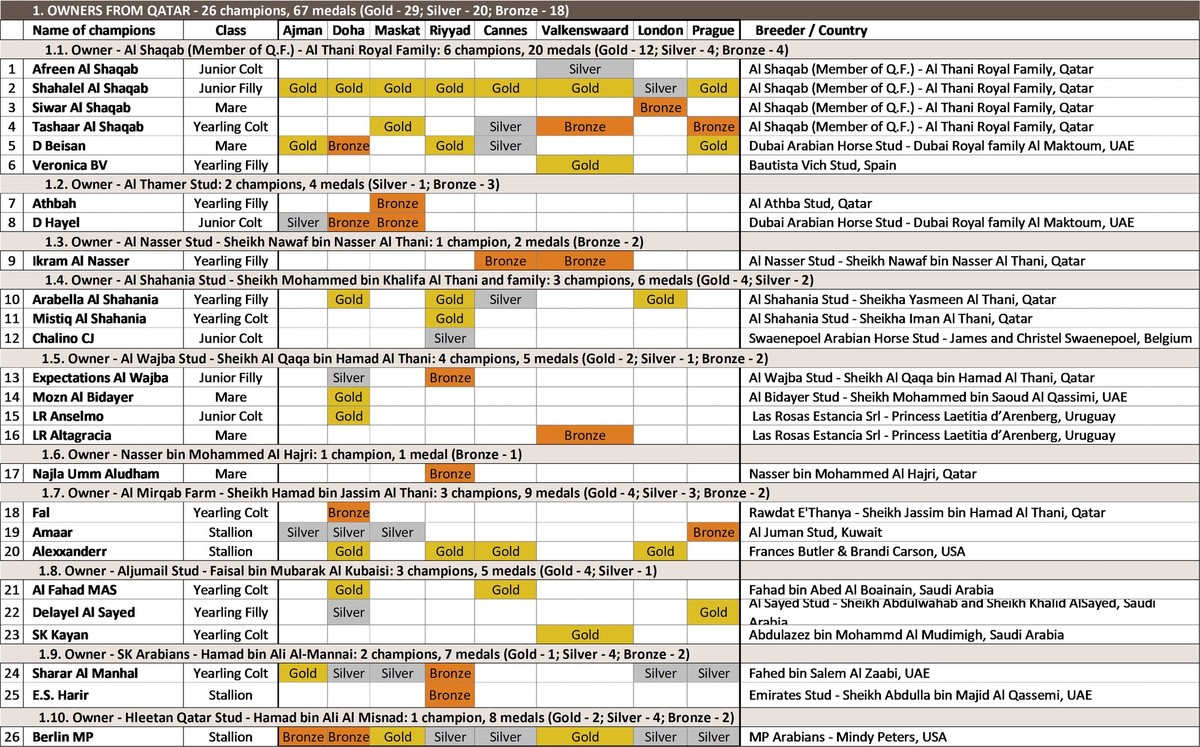 © Victoria Lazareva, feelingthelife.com
© Victoria Lazareva, feelingthelife.com

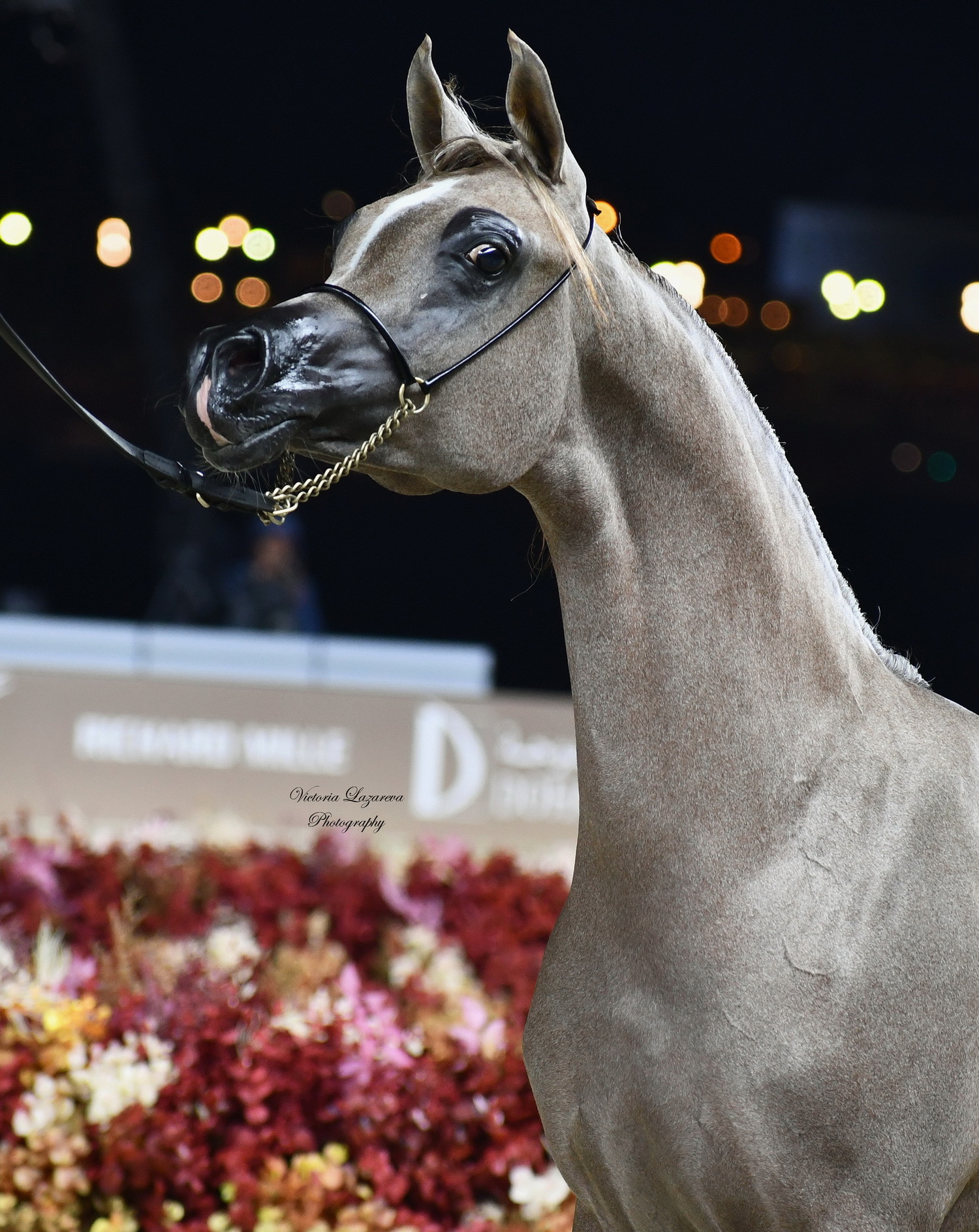
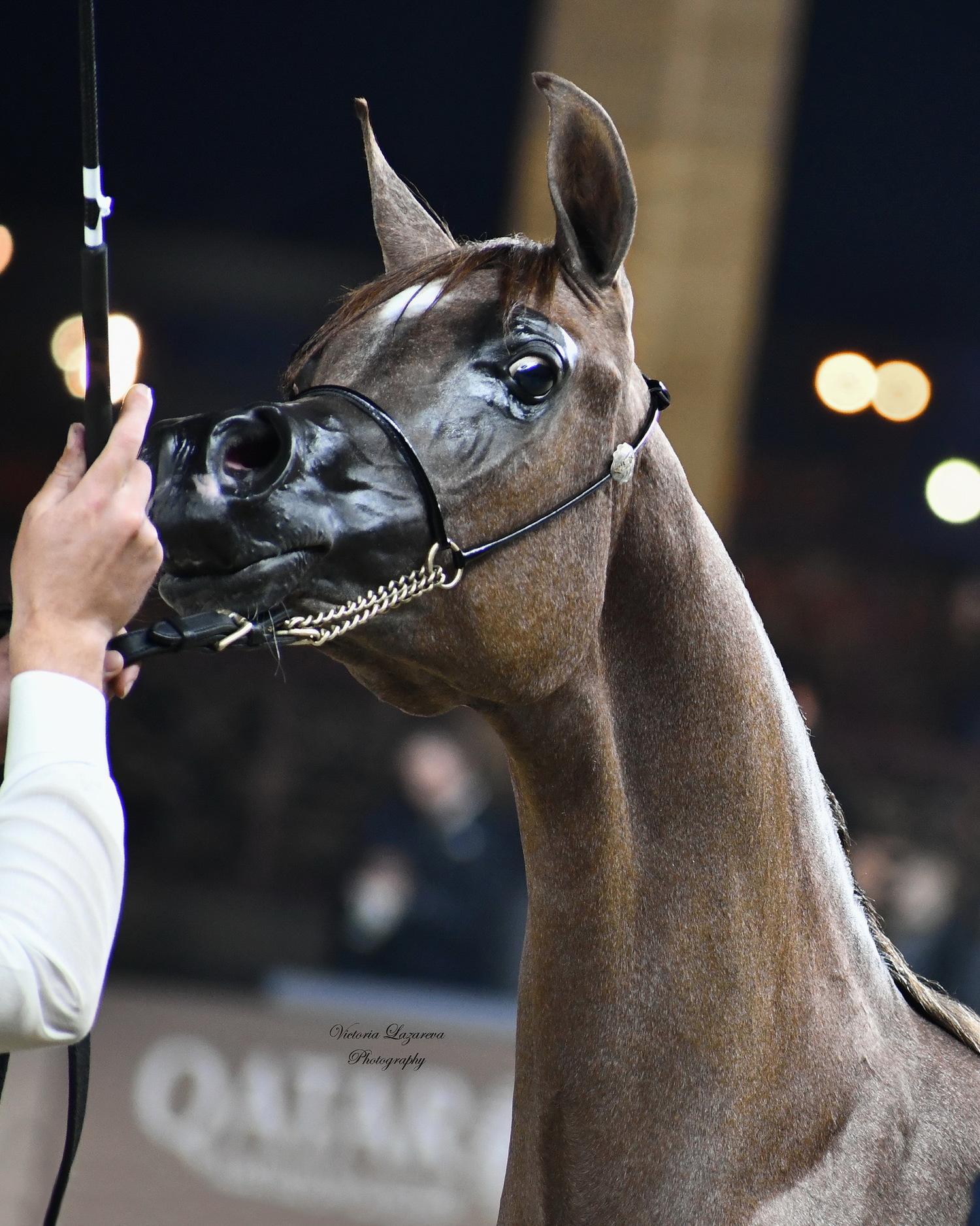
1. Qatar
- © Victoria Lazareva, feelingthelife.com
Arabian stallion Alexxanderr
- © Victoria Lazareva, feelingthelife.com
Arabian stallion Alexxanderr
- © Victoria Lazareva, feelingthelife.com
Arabian stallion Alexxanderr
- © Victoria Lazareva, feelingthelife.com
Giacomo Capacci & junior Arabian colt D Hayel
2. The UAE Champion Owners
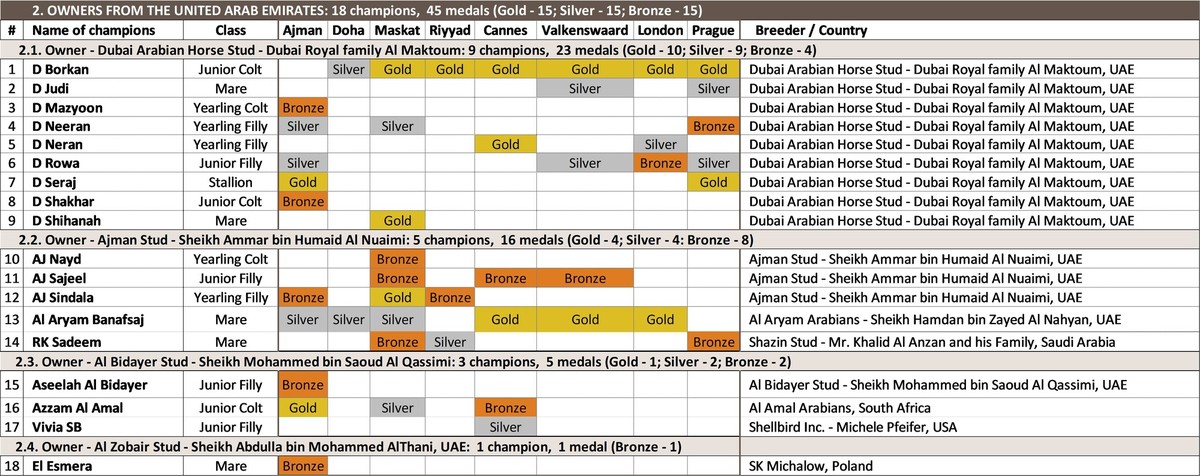 © Victoria Lazareva, feelingthelife.com
© Victoria Lazareva, feelingthelife.com
2. The United Arab Emirates
- © Victoria Lazareva, feelingthelife.com
Paolo Capecci & junior Arabian colt
- © Victoria Lazareva, feelingthelife.com
Paolo Capecci & junior Arabian colt
3. Saudi Arabia Champion Owners
 © Victoria Lazareva, feelingthelife.com
© Victoria Lazareva, feelingthelife.com
3. Kingdom of Saudi Arabia -
4. Switzerland Champion Owners
 © Victoria Lazareva, feelingthelife.com
© Victoria Lazareva, feelingthelife.com
4. Switzerland -
5-10. Other Champion Owners — Kuwait, Jordan, Libya, Poland, Oman, Palestine
 © Victoria Lazareva, feelingthelife.com
© Victoria Lazareva, feelingthelife.com
- © Victoria Lazareva, feelingthelife.com
Arabian stallion Shareem RC
5-10. Other Champion Owners -
THE NATURE OF THE BLOOD
While constructing pedigree tables for the 2025 GCAT Europe and Middle East Champions, I noticed the frequent repetition of names like Versace, DA Vinci, DA Valentino, and several others. They all linked to a common ancestor— the bay stallion Bey Shah. Out of curiosity, I decided to look at how often Bey Shah appeared in the champions' pedigrees and unexpectedly came up with a sensational figure: 99%!
63 out of 64 champions have a common ancestor in their pedigrees—Bey Shah.
To understand how critical this figure is, I created additional data tables by champion generation:
• separately listing the champions' sires, grandfathers, great-grandfathers, great-great-grandfathers, and great-great-great-grandfathers who have Bey Shah in their pedigree;
• separately listing the champions' dams, grandmothers, great-grandmothers, great-great-grandmothers, and great-great-great-grandmothers who have Bey Shah in their pedigree.
The table does not take into account the accumulation of Bey Shah blood through repeats; in the generation columns, names are listed only once. This is a very simplified table, but once you understand it, it is quite clear.
 © Victoria Lazareva, feelingthelife.com
© Victoria Lazareva, feelingthelife.com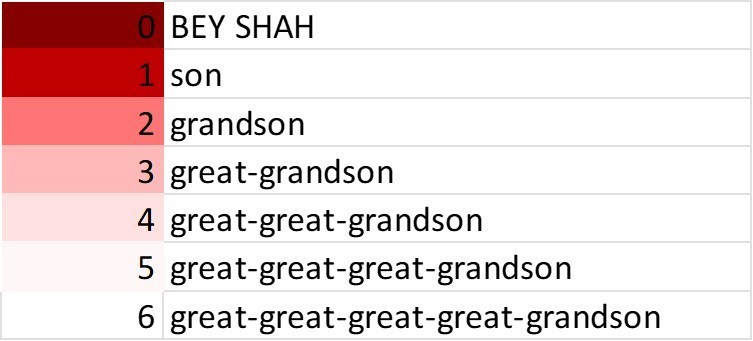 © Victoria Lazareva, feelingthelife.com
© Victoria Lazareva, feelingthelife.com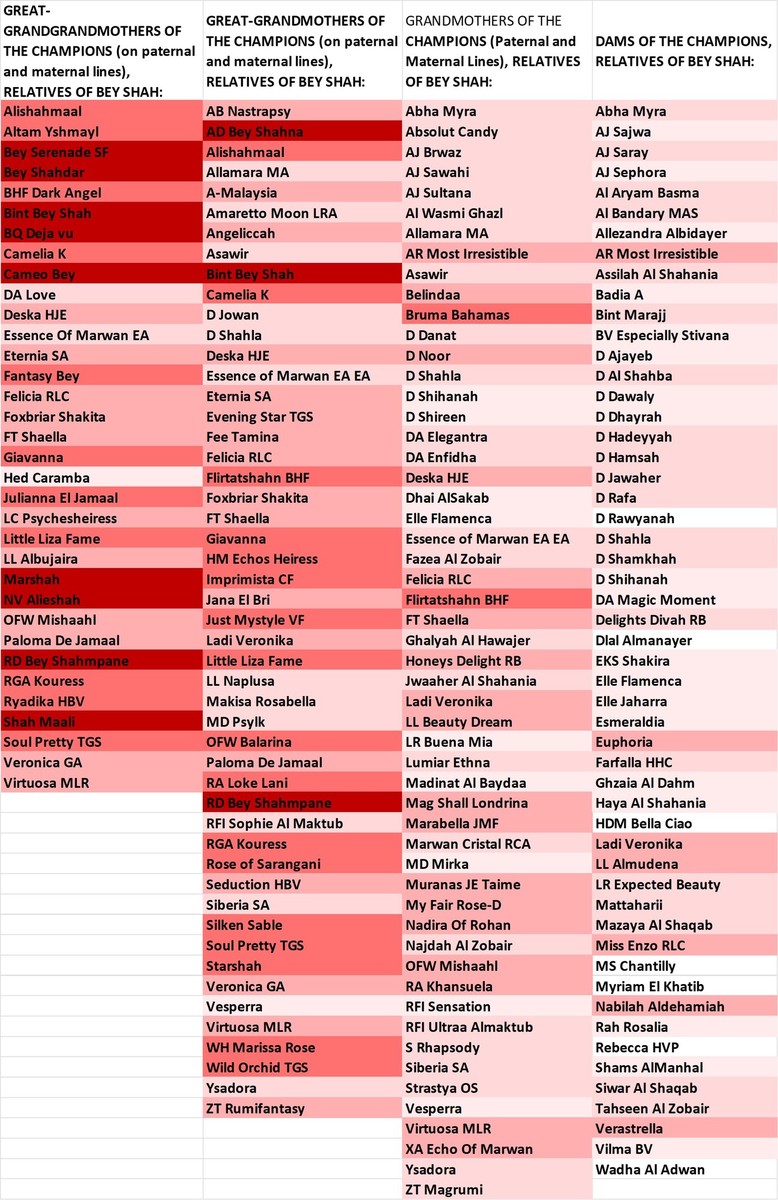 © Victoria Lazareva, feelingthelife.com
© Victoria Lazareva, feelingthelife.com © Victoria Lazareva, feelingthelife.com
© Victoria Lazareva, feelingthelife.com
It turns out that many champions are related with Bey Shah in distant, in the 3rd to 6th generation. But Bey Shah, "distant" by generations, is often "approached" through multiple repetitions in pedigrees.
99% of all Europe and Middle East GCAT 2025 champions have Bey Shah in their blood.
More than half have Bey Shah in their blood on both their maternal and paternal lines.
In 25%, Bey Shah is present in four lines: both paternal lines and both maternal lines.
For example, in the stallion D Shahhar's pedigree (the sire of the Ajman silver champion, the yearling colt FAM Vortex), Bey Shah is distant by six generations, yet his name appears seven times in the pedigree.
In the mare HDM Bella Ciao's pedigree (the dam of the Muscat bronze champion, the yearling colt AJ Nayd), Bey Shah is distant by six generations, yet his name appears six times in the pedigree.
In Ghaly Al Hawajer (the sire of the Riyad silver champion, the junior colt Chalino CJ), Bey Shah is distant by six generations, yet his name appears six times in the pedigree.
LR Solo Mio, Mutabahi Al Hawajer, and Royal Asad are the sires of GCAT champions, all of whom have Bey Shah far in generations but five times in pedigrees.
The presence of a common Bey Shah ancestor in 63 of the 64 champions of the prestigious tour is not just the norm, but a characteristic feature of intensive selective breeding in the Arabian horse breed.
This reflects a phenomenon known as the "founder effect" or line breeding, and has both its benefits and potential risks.
The benefits of such a high frequency:
• Reinforcement of desired traits: When one stallion exhibits exceptional show qualities (conformation, movement, "type"), breeders deliberately use him in breeding to reinforce these genes in the next generation. This allows for the creation of horses with predictable and high results.
• Success through homozygosity: Intensive line breeding increases the likelihood that horses will have the same genes for desired traits. The more champions from a limited number of ancestors, the "purer" the breed within a specific show standard.
• Historical precedent: A similar situation is observed in other breeds. For example, 95% of all modern Thoroughbreds share a common male ancestor—a stallion named Eclipse.
The mere presence of a common ancestor in a pedigree is not an immediate red flag, unless there is close inbreeding in the first two generations (for example, father-daughter, half-siblings).
However, it poses long-term risks to the overall health of the breed:
• Reduced genetic diversity: Overreliance on a single ancestor narrows the overall gene pool. This is called the "bottleneck effect."
• Accumulation of undesirable genes: If a dominant ancestor harbored a latent recessive gene responsible for a disease, intensive breeding can cause this gene to spread throughout the breed and begin to manifest in offspring.
• Inbreeding depression: Over the long term, a high overall inbreeding coefficient (a measure of relatedness) can negatively impact the overall health, fertility, and viability of the breed.
In the context of "sport" or "show" breeding, where the goal is immediate victory (here and now), such a concentration of Bey Shah blood is a normal and successful strategy.
However, from the perspective of long-term genetic health and breed stability, the level of inbreeding must be constantly monitored, and genetic tools must be used to manage risks.
